ZyXEL Communications PLA5236 1000 Mbps Powerline AC900 Wireless Extender User Manual Book
ZyXEL Communications Corporation 1000 Mbps Powerline AC900 Wireless Extender Book
User Manual
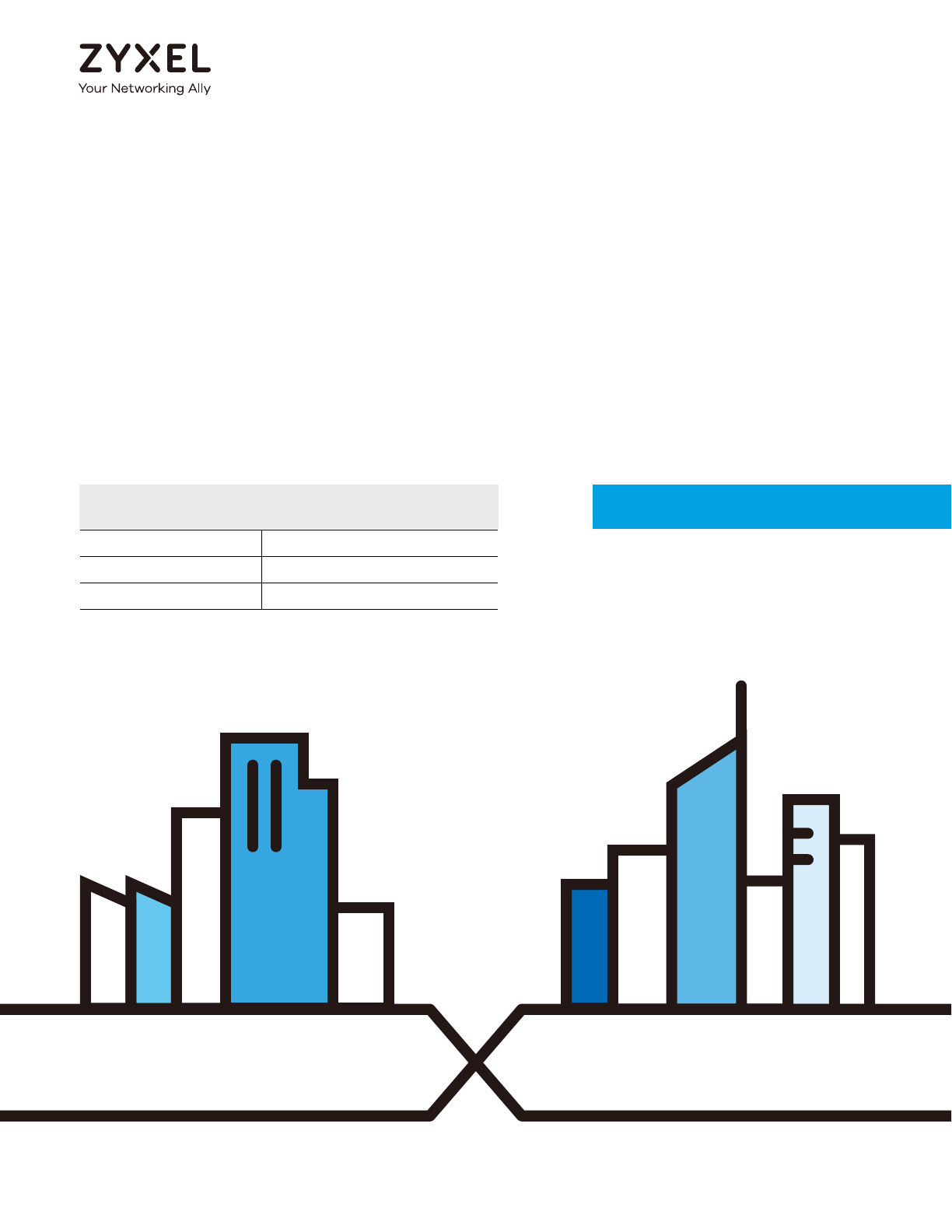
Default Login Details
User’s Guide
PLA5236
1000 Mbps Powerline AC900 Wireless Extender
Copyright © 2017 Zyxel Communications Corporation
Web Address http://zyxelsetup
LAN IP Address http://192.168.1.3
Password 1234
Version 1.10 Edition 1, 01/2017

PLA5236 User’s Guide
2
IMPORTANT!
READ CAREFULLY BEFORE USE.
KEEP THIS GUIDE FOR FUTURE REFERENCE.
This is a User’s Guide for a system managing a series of products. Not all products support all features.
Menu shots and graphics in this book may differ slightly from what you see due to differences in release
versions or your computer operating system. Every effort has been made to ensure that the information
in this manual is accurate.
Related Documentation
•Quick Start Guide
The Quick Start Guide shows how to connect PLA and access the web configurator.
• Online Help
Click the help link for a description of the fields in the PLA menus.
•More Information
Go to support.zyxel.com to find other information on the PLA.

Table of Contents
PLA5236 User’s Guide
3
Table of Contents
Table of Contents.................................................................................................................................3
Part I: Introduction ............................................................................................6
Chapter 1
Introducing the PLA .............................................................................................................................7
1.1 Overview ........................................................................................................................................... 7
1.2 LEDs .................................................................................................................................................... 7
1.3 Ways to Manage the PLA ................................................................................................................ 9
1.4 Expand Your Network with the PLA ................................................................................................ 9
1.5 Security ............................................................................................................................................ 10
1.5.1 Passwords ............................................................................................................................... 10
1.5.2 Setting Up Security ................................................................................................................ 10
1.6 Multiple Networks ........................................................................................................................... 11
Chapter 2
The RESET/ENCRYPT Button ................................................................................................................12
2.1 RESET/ENCRYPT Button Overview .................................................................................................. 12
2.2 Adding Devices to a Powerline Network ..................................................................................... 12
2.3 Removing a Device from a Powerline Network ......................................................................... 14
2.4 Multiple Separate Powerline Networks ........................................................................................ 15
2.5 One Combination RESET/ENCRYPT Button .................................................................................. 16
Part II: Web Configurator................................................................................17
Chapter 3
Introducing the Web Configurator ...................................................................................................18
3.1 Overview ......................................................................................................................................... 18
3.2 Accessing the Web Configurator ................................................................................................. 18
3.2.1 Login Screen .......................................................................................................................... 18
3.2.2 Password Screen ................................................................................................................... 19
3.3 Navigating the Web Configurator ............................................................................................... 20
3.3.1 Title Bar ................................................................................................................................... 20
3.3.2 Navigation Panel .................................................................................................................. 21

Table of Contents
PLA5236 User’s Guide
4
Chapter 4
Dashboard..........................................................................................................................................23
4.1 The Dashboard Screen .................................................................................................................. 23
Chapter 5
Connection Wizard............................................................................................................................26
5.1 Overview ......................................................................................................................................... 26
5.2 Using the Web Configurator Wizard ............................................................................................. 26
Chapter 6
Monitor................................................................................................................................................28
6.1 Overview ......................................................................................................................................... 28
6.2 What You Can Do .......................................................................................................................... 28
6.3 Log .................................................................................................................................................... 28
6.4 Packet Statistics ........................................................................................................................... 29
6.5 WLAN 2.4G Station Status .......................................................................................................... 30
6.6 WLAN 5G Station Status ................................................................................................................. 31
Chapter 7
Wireless LAN .......................................................................................................................................32
7.1 Overview ......................................................................................................................................... 32
7.1.1 Powerline Extended Wireless LAN ....................................................................................... 32
7.2 What You Can Do .......................................................................................................................... 33
7.3 What You Should Know ................................................................................................................. 34
7.3.1 Wireless Security Overview ................................................................................................... 34
7.4 General Wireless LAN Screen ....................................................................................................... 35
7.5 Wireless Security .............................................................................................................................. 37
7.5.1 No Security ............................................................................................................................. 37
7.5.2 WEP Encryption ..................................................................................................................... 38
7.5.3 WPA-PSK/WPA2-PSK .............................................................................................................. 40
7.6 MAC Filter ........................................................................................................................................ 41
7.7 Wireless LAN Advanced Screen ................................................................................................... 42
7.8 Quality of Service (QoS) Screen ................................................................................................... 43
7.9 WPS Screen ..................................................................................................................................... 44
7.10 WPS Station Screen ...................................................................................................................... 45
7.11 Scheduling Screen ....................................................................................................................... 46
Chapter 8
LAN......................................................................................................................................................48
8.1 Overview ......................................................................................................................................... 48
8.2 What You Can Do .......................................................................................................................... 48
8.3 What You Need To Know .............................................................................................................. 48
8.3.1 LAN TCP/IP ............................................................................................................................. 49

Table of Contents
PLA5236 User’s Guide
5
8.3.2 IP Alias ..................................................................................................................................... 49
8.4 LAN IP Screen .................................................................................................................................. 49
8.5 IP Alias Screen ................................................................................................................................. 50
Chapter 9
Home Plug ..........................................................................................................................................52
9.1 Overview ......................................................................................................................................... 52
9.2 What You Can Do .......................................................................................................................... 52
9.3 HomePlug Screen ........................................................................................................................... 52
Chapter 10
One Connect......................................................................................................................................55
10.1 Overview ....................................................................................................................................... 55
10.2 What You Can Do ........................................................................................................................ 55
10.3 One Connect Screen ................................................................................................................... 55
Chapter 11
Maintenance......................................................................................................................................56
11.1 Overview ....................................................................................................................................... 56
11.2 What You Can Do ........................................................................................................................ 56
11.3 General Screen ............................................................................................................................ 56
11.4 Password Screen ........................................................................................................................... 57
11.5 Time Setting Screen ...................................................................................................................... 57
11.6 Firmware Upgrade Screen .......................................................................................................... 59
11.7 Configuration Backup/Restore Screen ...................................................................................... 61
11.8 Restart Screen ............................................................................................................................... 62
11.9 Language Screen ......................................................................................................................... 62
11.10 Wi-Fi Mode Screen ...................................................................................................................... 62
Chapter 12
Troubleshooting..................................................................................................................................64
12.1 Power and Light Problems ........................................................................................................... 64
12.2 Powerline Problems ...................................................................................................................... 65
12.3 RESET/ENCRYPT Button Problems ................................................................................................ 65
Appendix A Customer Support ....................................................................................................... 68
Appendix B Legal Information......................................................................................................... 74
Index...................................................................................................................................................82

6
PART I
Introduction

PLA5236 User’s Guide
7
CHAPTER 1
Introducing the PLA
1.1 Overview
This chapter introduces the main applications and features of your Zyxel Powerline Wireless 11ac Dual
Band Extender with 1000Mbps PHY rate, which is called “PLA” in this guide. The following generic icon is
used to represent the PLA.
This User’s Guide helps you understand more about how your PLA works and how to configure your
network. The PLA plugs into an ordinary power outlet to easily extend a cable or DSL broadband
connection or existing Ethernet (LAN) network to any other electrical outlet in any room of a house. The
PLA provides a hybrid powerline transmission and Wi-Fi solution, enabling a larger transmission capacity,
all without the need for any new cabling, since power sockets are available everywhere in your home.
With the PLA you can easily set up a wireless network with both IEEE 802.11 b/g/n and IEEE 802.11 a/n/ac
compatible devices. Multiple HD videos can be streamed over an interference-free 5GHz radio band
across the network with no frame loss.
In this User’s Guide the electrical wiring network is referred to as the “powerline network”. You can
directly plug an electrical device (such as a router or computer) into PLA with an AC power pass-
through socket to supply power to the device.
1.2 LEDs
The following sections describes the lights on the PLA.
The following figure is the front panel of the PLA. Use the lights to determine if the PLA is behaving
normally or if there are some problems on your powerline network.
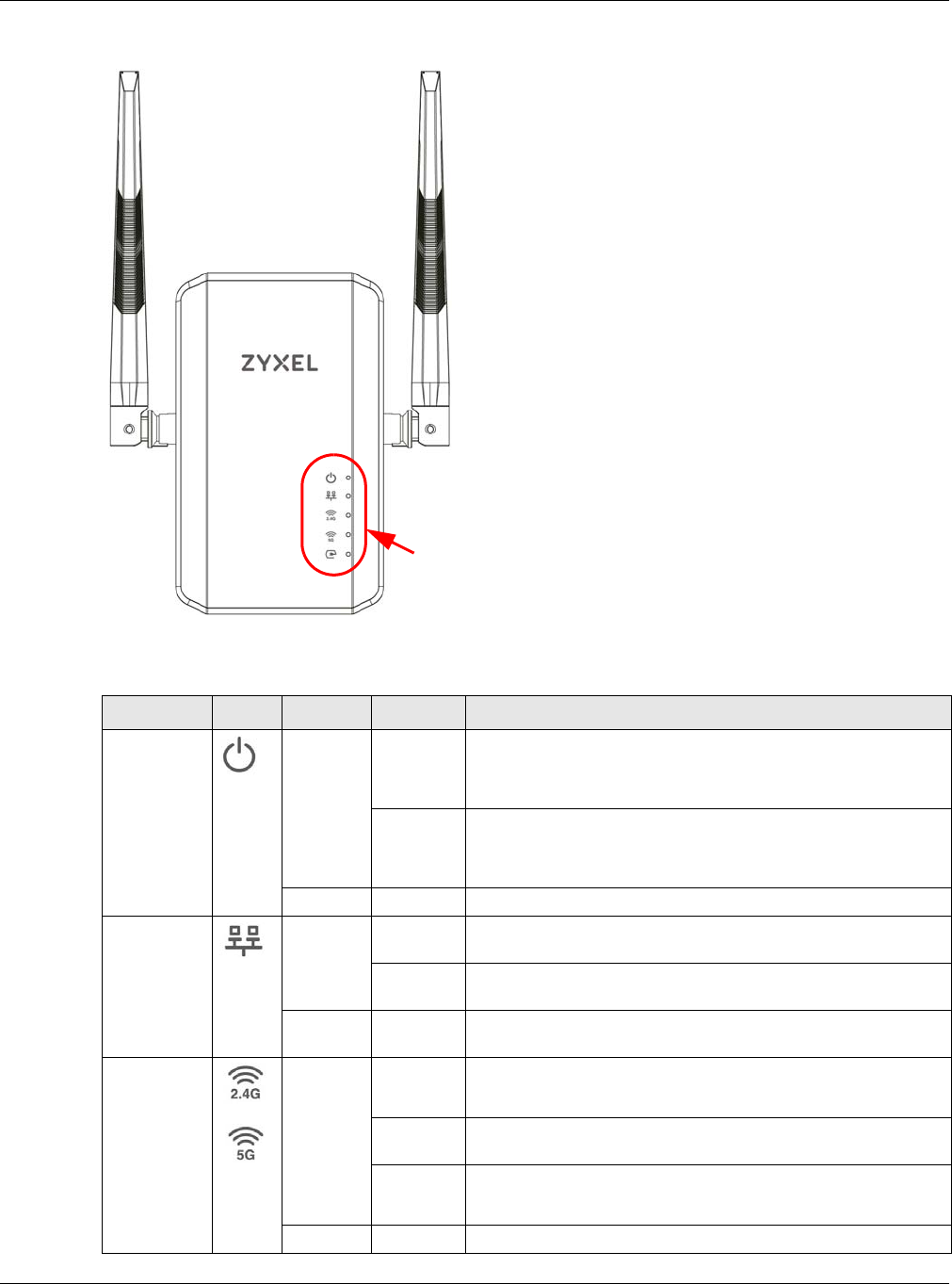
Chapter 1 Introducing the PLA
PLA5236 User’s Guide
8
Figure 1 Front Panel
The following table describes the behavior of the lights on the PLA.
Table 1 Front Panel LEDs
LIGHTS ICON COLOR STATUS DESCRIPTION
POWER Green On The PLA is on and receiving power.
It also indicates a successful connection using the RESET/
ENCRYPT button.
Blinking Blinking during 10 seconds: The ENCRYPT function has been
active.
Blinking during 120 seconds: The ENCRYPT function has failed.
Off The PLA is not receiving power.
ETHERNET Green On The ETHERNET port is on and ready and the PLA detects a device
connected to it.
Blinking The PLA is communicating with a networking device connected
to it.
Off The PLA does not detect any devices connected to its ETHERNET
port.
Wi-Fi 2.4G
Wi-Fi 5G
Green On The PLA’s wireless signal is ready.
Wi-Fi protected security is enabled.
Slow
Blinking
The WPS is syncing the PLA with another device.
Fast
Blinking
The PLA is transmitting and/or receiving wireless traffic.
The WPS syncing has failed.
Off The wireless signal is disabled.
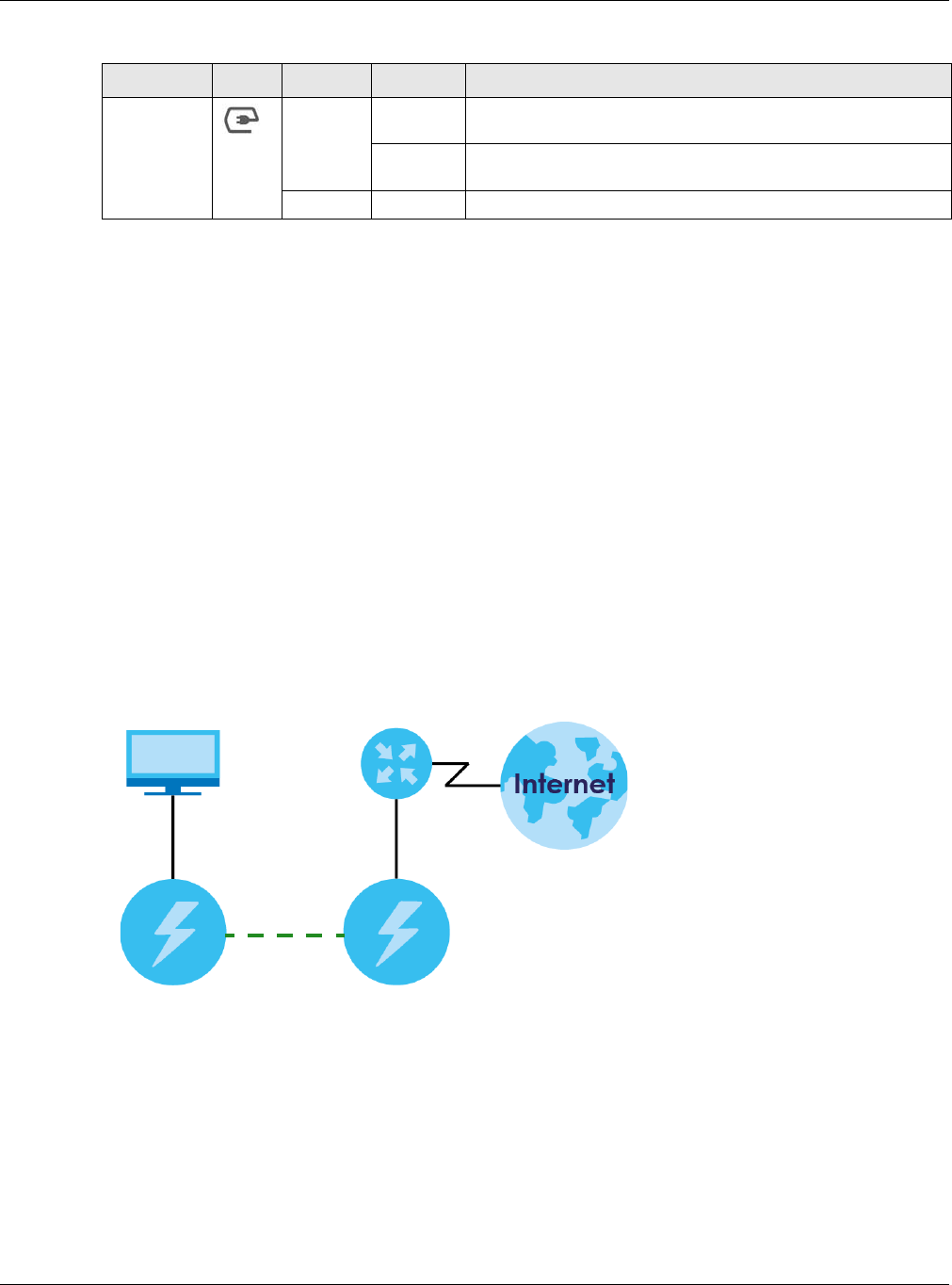
Chapter 1 Introducing the PLA
PLA5236 User’s Guide
9
1.3 Ways to Manage the PLA
Use the RESET/ENCRYPT button to add powerline devices to your powerline network if they have this
button. See Chapter 2 on page 12 for instructions on using the ENCRYPT feature.
Use the Home Plug screen to manage the PLA. See Section 9.3 on page 52 for instructions on installing
the utility.
1.4 Expand Your Network with the PLA
The PLA plugs into an ordinary power outlet to easily extend a cable or DSL broadband connection or
existing Ethernet (LAN) network to any other electrical outlet in any room of a house, all without the
need for any new cabling. Devices can securely communicate with each other at high data transfer
rates. The PLA uses 128-bit Advanced Encryption Standard (AES) to ensure safe transfer of information.
Figure 2 Expand Your Network with the PLA
Connect your PLA to an Internet gateway such as a modem and plug it into an ordinary power outlet in
your home. Plug a second PLA into another power outlet and connect a computer to the PLA for
Internet access. Your network can be further expanded by plugging additional PLAs into other outlets in
your home and connecting other computers or network devices (for example, a printer) to them.
Refer to your Quick Start Guide for hardware connection information.
HomePlug Green On The PLA detects another powerline adapter. The data transfer
rate is greater than 80 Mbps.
Blinking The PLA is communicating with another powerline adapter. Data
is being transmitted and/or received.
Off The HomePlug port does not detect another powerline adapter.
Table 1 Front Panel LEDs
LIGHTS ICON COLOR STATUS DESCRIPTION
PLA
PLA

Chapter 1 Introducing the PLA
PLA5236 User’s Guide
10
1.5 Security
Since your powerline network may extend outside your premises, it is important to set up security on your
PLA.
1.5.1 Passwords
You use two types of passwords in the Home Plug AV powerline network. The following table describes
the differences between the passwords.
1.5.2 Setting Up Security
The ENCRYPT feature automatically sets up security on your powerline network. Use this feature if your
powerline devices have the RESET/ENCRYPT button.
Alternatively, use the Zyxel Home Plug screen (Section 9.3 on page 52) to set up security on the
PLA.Although the PLA is a “plug-and-play” network expanding solution there are several reasons for
enabling security on the powerline network in your home.
1It’s easy and only requires you to change a network name.
2It’s a good idea to ensure privacy of your communication. When you use the PLA and other powerline
adapters, the electrical wiring in your home becomes an extension of your Ethernet network. Your
network traffic flows freely within the electrical circuit of your home and is bounded in most cases by a
power meter.
Without security (encryption) your information is accessible to anyone using a powerline adapter on the
same electrical circuit. In some cases, a circuit can be shared by more than one household.
To prevent compromising your network security, you can create a private network. A private network
uses a secret password (Network Name) to make sure that only permitted powerline adapters can
communicate in your network.
3You may need to change the Network Name to create multiple powerline networks. See the next
section for more information on how to set up a multiple network.
Table 2 Password Summary
PASSWORD DESCRIPTION
Network Name All powerline adapters that follow the HomePlug AV standard are shipped with the
same powerline network name “HomePlugAV”.
DAK (Data Access Key)
Password
In order to manage the powerline adapters on your powerline network you must
enter the adapters’ DAK password in the Home Plug Screen (Section 9.3 on page
52). This password is printed on the powerline adapter itself.
You don’t need to add the password for the powerline adapter directly connected
to the computer running the web configurator (local powerline adapter), you only
have to add the remote powerline adapters’ passwords (those on your circuit, but
not directly connected to your computer).

Chapter 1 Introducing the PLA
PLA5236 User’s Guide
11
1.6 Multiple Networks
Multiple powerline networks can coexist on a single powerline circuit. You might want to implement
multiple powerline networks in a small office environment where you have two separate Ethernet
networks.
1Connect one powerline adapter to a router or switch on the first Ethernet network and assign a Network
Name (for example “Password1”) to this powerline adapter. Add additional powerline adapters to your
network by plugging them into your powerline outlets and assigning them “Password1”. This completes
the configuration of your first powerline network.
2Connect another powerline adapter to a router or switch on the second Ethernet network and assign a
different Network Name (for example “Password2”) to this powerline adapter. Again, add additional
powerline adapters and assign them “Password2”.
You now have two private networks on your powerline circuit. Information is not shared between the
two networks as only powerline adapters with the same Network Name can communicate with each
other.
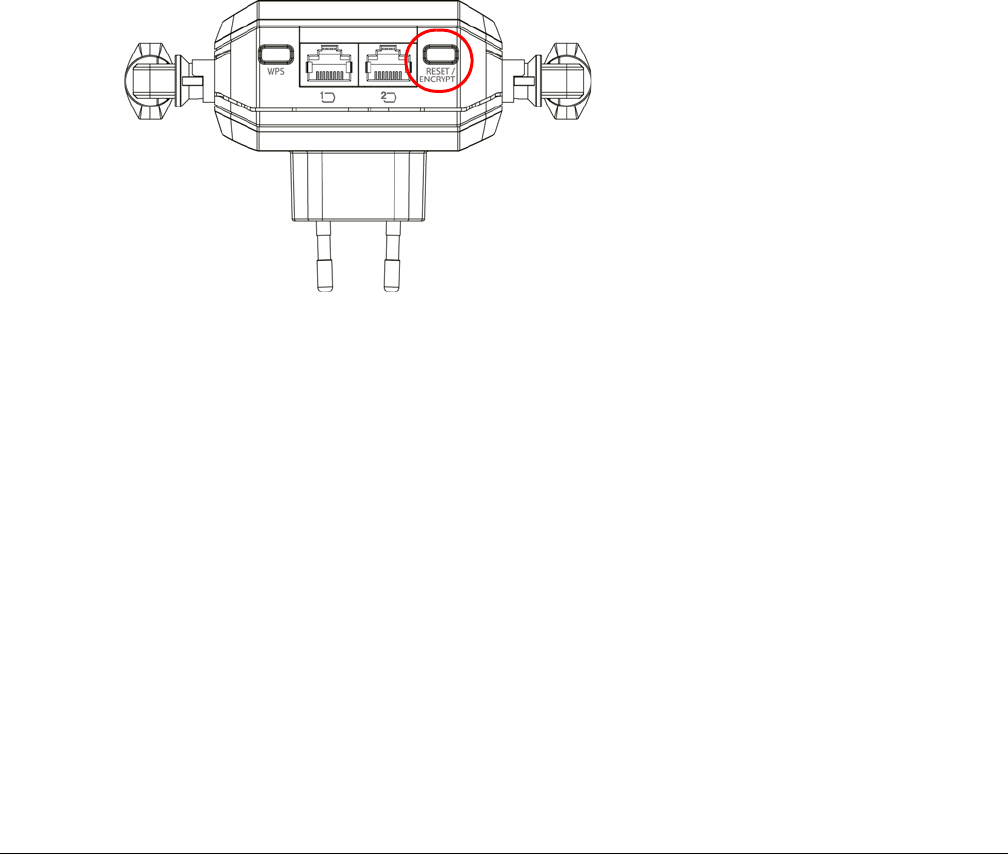
PLA5236 User’s Guide
12
CHAPTER 2
The RESET/ENCRYPT Button
Use the RESET/ENCRYPT button to automatically set up a secure powerline connection between your
powerline devices.
2.1 RESET/ENCRYPT Button Overview
The RESET/ENCRYPT button allows you to set up a secure powerline connection with other HomePlug AV
compliant powerline devices which also support the ENCRYPT feature. No other powerline setting
changes are required to connect.
You can use the RESET/ENCRYPT button to:
• set up a new powerline network.
• separate an existing powerline network into multiple networks.
• reset the PLA to the factory defaults.
2.2 Adding Devices to a Powerline Network
You can connect a number of PLAs on a powerline network, but you can use the RESET/ENCRYPT button
on only two PLAs at a time.
Place a powerline device close to another powerline device so you have time to set up each one. After
you set up the first powerline device, you have 120 seconds to set up the second powerline device.
Note: Your PLA must be connected to a networking equipment for the RESET/ENCRYPT button
to work. Refer to Section 1.3 on page 9 for more details.
Follow the steps below to set up your HomePlug AV Network:
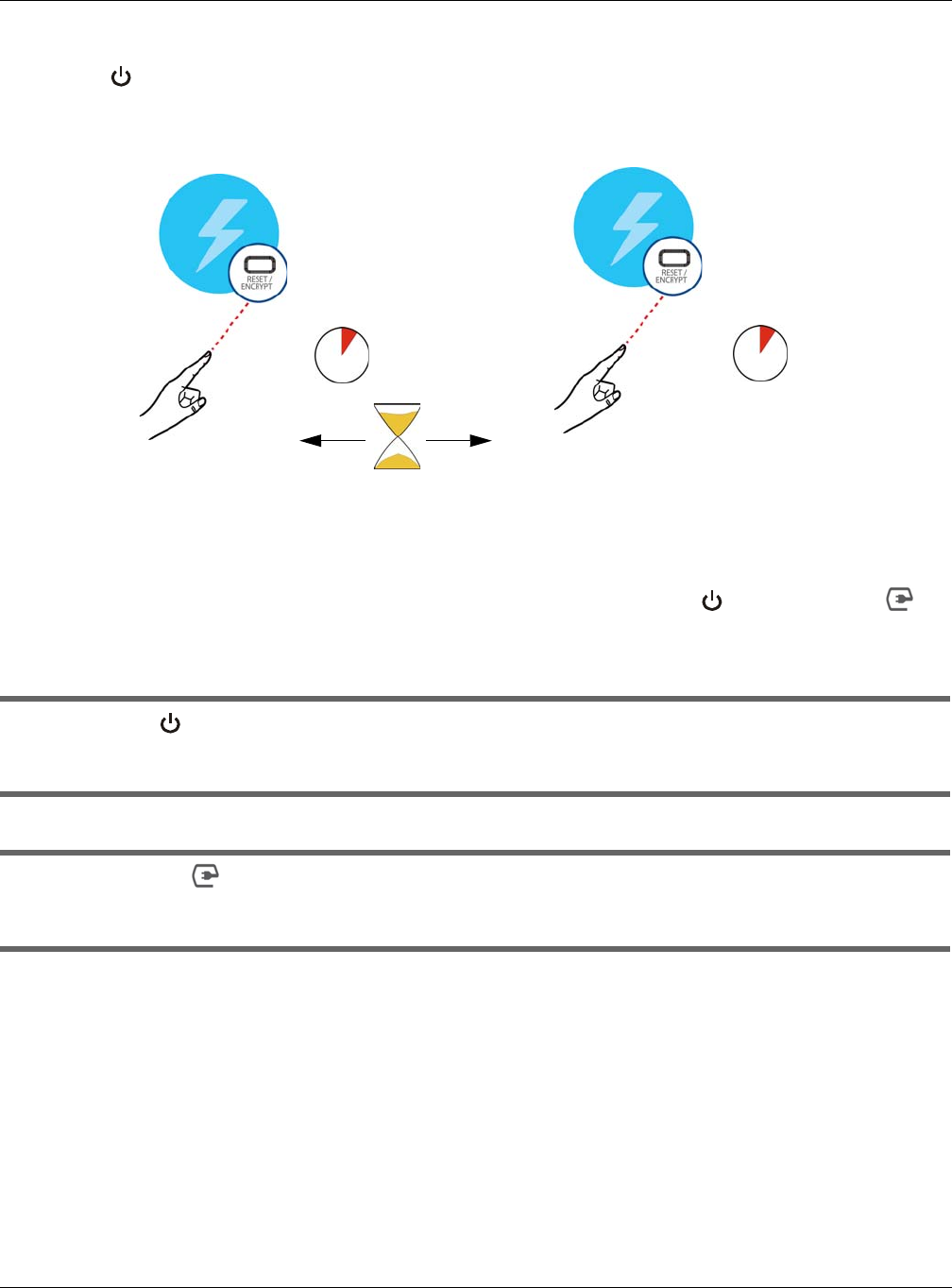
Chapter 2 The RESET/ENCRYPT Button
PLA5236 User’s Guide
13
1Press the RESET/ENCRYPT button at the side of your powerline device for 0.5 to 3 seconds. The power
( ) light will blink as the powerline device tries to set up a connection with a new random network
name.
Figure 3 ENCRYPT Connection Procedure
Note: The RESET/ENCRYPT button’s location varies for each Powerline model.
Note: Check the lights on the two powerline devices. The power ( ) and HomePlug ( )
lights should be on while the devices are connecting. Wait for about two minutes while
your powerline devices connect.
If the power ( ) light does not blink when you press RESET/ENCRYPT, you have probably pressed
the RESET/ENCRYPT button for too long. Try again, pressing the RESET/ENCRYPT button for 0.5 to 3
seconds.
If the HomePlug ( ) lights on both powerline devices do not light up, the powerline devices
are not connected. Repeat step 1 in this section. If that doesn’t work, see the Troubleshooting in
Section 12.3 on page 65 for suggestions.
2To add more powerline devices to your network, use any powerline device (A or B) you have
connected to set up a connection with the powerline devices you want to connect (C and D).
3Press the RESET/ENCRYPT button on both powerline devices (A and C, or B and C) for 0.5 to 3 seconds to
add powerline device C. This must be done within 2 minutes (120 seconds) of pressing the RESET/
ENCRYPT button on the PLA.
4Press the RESET/ENCRYPT button on both powerline devices (A and D, B and D or C and D) for 0.5 to 3
seconds to add powerline device D. This must be done within 2 minutes (120 seconds) of pressing the
RESET/ENCRYPT button on the PLA.
press 0.5 ~ 3 seconds
press 0.5 ~ 3 seconds
within 2
minutes
PLA PLA
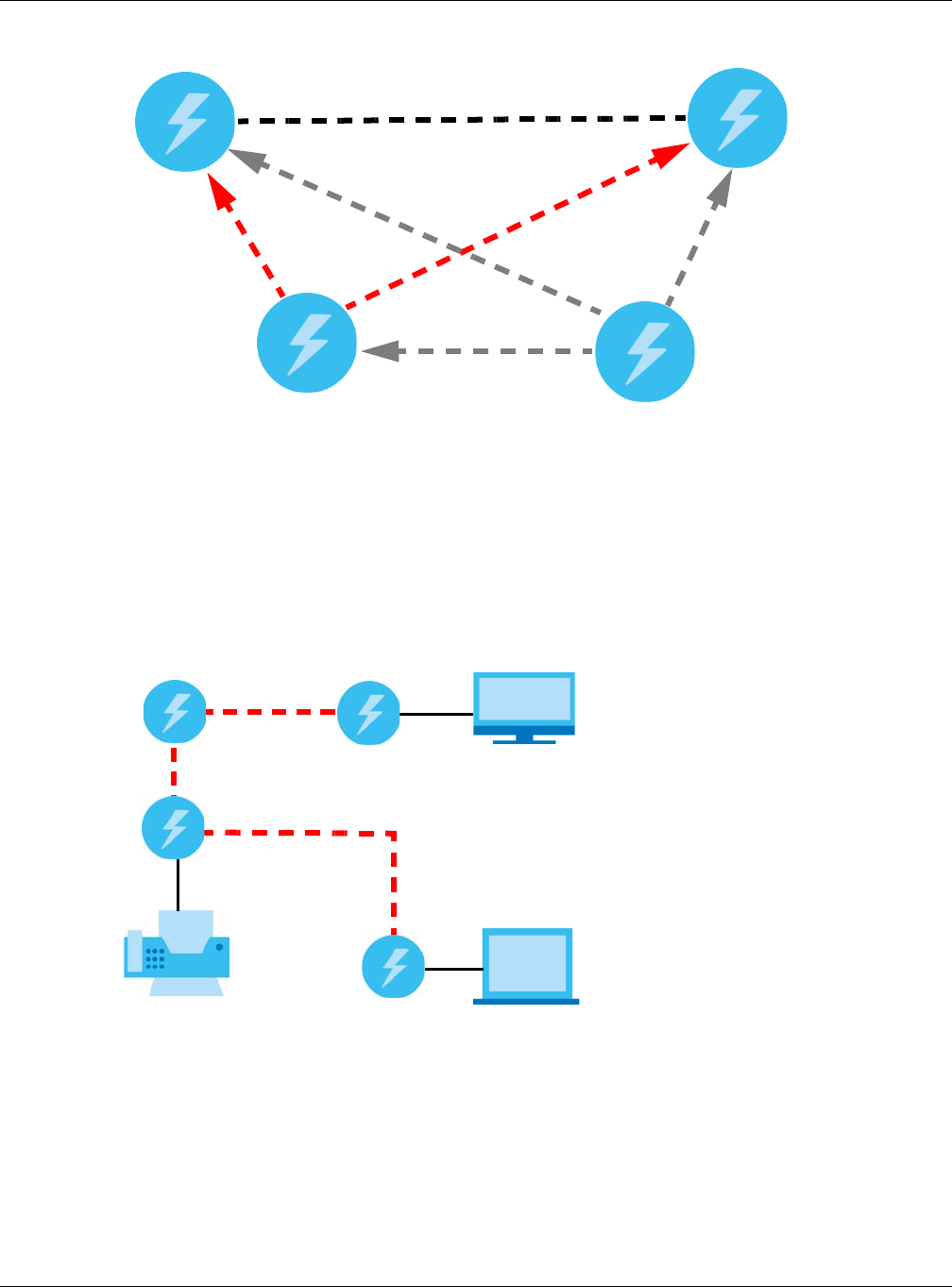
Chapter 2 The RESET/ENCRYPT Button
PLA5236 User’s Guide
14
Figure 4 Adding More Powerline Adapters to Your Network
This sets up your powerline network between your powerline devices.
2.3 Removing a Device from a Powerline Network
Suppose you want to remove PLAs (C) and (D) from the following powerline network.
Figure 5 Removing Devices From an Existing Powerline Network
1Press the RESET/ENCRYPT button on powerline device C for 5 to 8 seconds and then release it. This
disconnects C from the current network.
2Press the RESET/ENCRYPT button on powerline device D for 5 to 8 seconds and then release it. This
disconnects D from the current network.
A
B
C
A OR B
D
A OR B OR C
A
C
B
D
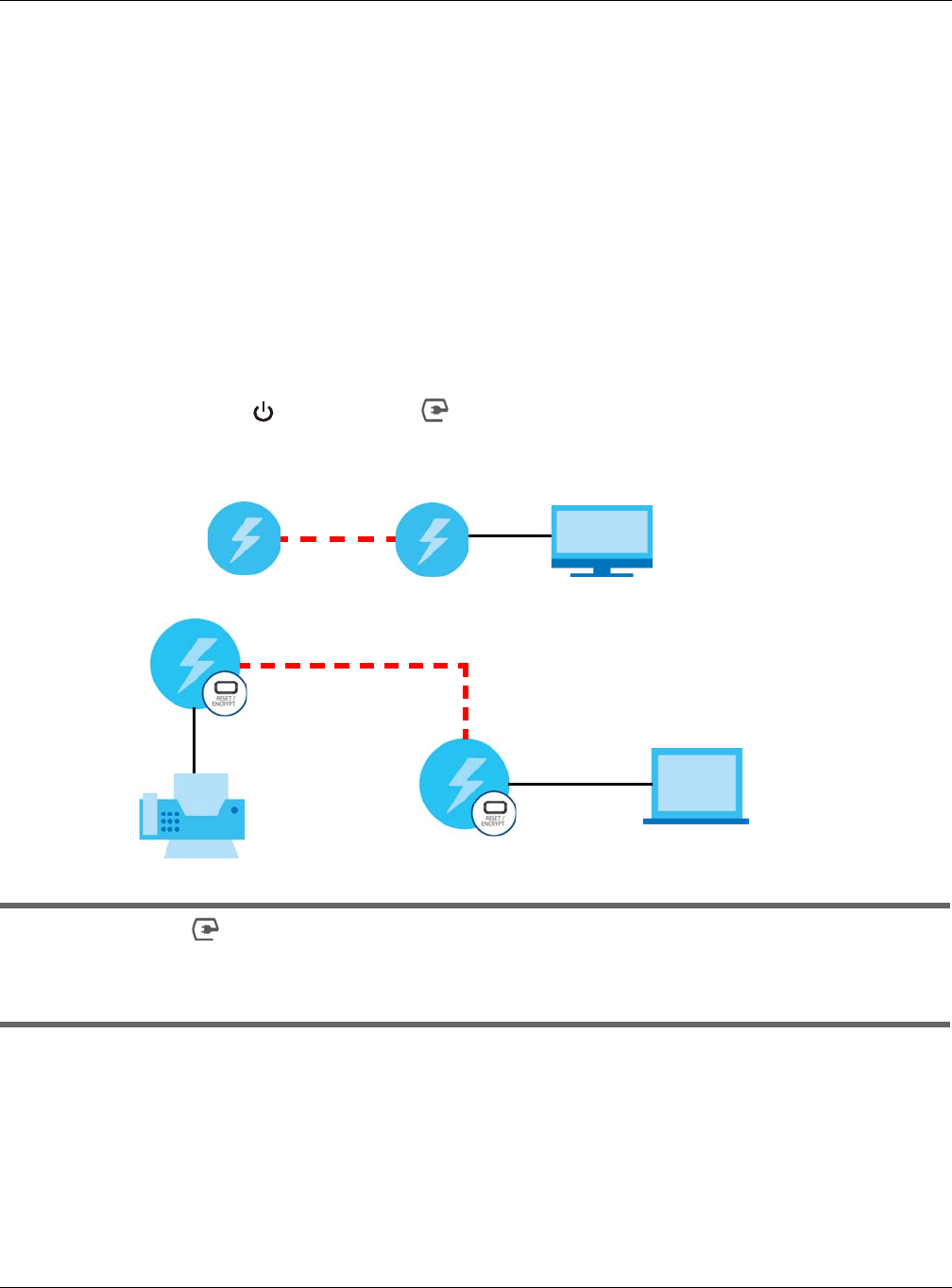
Chapter 2 The RESET/ENCRYPT Button
PLA5236 User’s Guide
15
2.4 Multiple Separate Powerline Networks
You can use the RESET/ENCRYPT button to create multiple separate powerline networks. Use the RESET/
ENCRYPT button on only two PLAs at a time.
1Press the RESET/ENCRYPT button on powerline devices E and F for 0.5 to 3 seconds. This must be done
within 2 minutes (120 seconds) of pressing the RESET/ENCRYPT button on the first PLA.
2Wait for about one minute while powerline devices E and F connect.
3Now pair two different PLAs. Press the RESET/ENCRYPT button on powerline devices G and H for 0.5 to 3
seconds and within two minutes of each other.
4Wait for about one minute while powerline devices G and H connect.
5When the power ( ) and HomePlug ( ) lights shine steadily, the devices are connected.
Figure 6 Two Separate Powerline Networks
If the HomePlug ( ) lights on both powerline devices do not light up, the powerline devices
are not connected. Repeat the connection process, making certain you press the RESET/
ENCRYPT buttons for the correct time and within two minutes of each other. If that does not work
see Section 12.3 on page 65 for suggestions.
E
G
F
H

Chapter 2 The RESET/ENCRYPT Button
PLA5236 User’s Guide
16
2.5 One Combination RESET/ENCRYPT Button
The following table summarizes the actions that occur when the RESET/ENCRYPT button is pressed for
specific lengths of time.
Note: The network name is unknown when you use the RESET/ENCRYPT button.
Table 3 RESET/ENCRYPT
TIME ACTION POWER LIGHT BEHAVIOR HOMEPLUG LIGHT BEHAVIOR
0.5 to 3
seconds
Create a powerline network
with a new random network
name.
Join an existing powerline
network by sharing the same
network name as other
devices on the network.
The power ( ) light blinks until
the device is connected. This
may take a minute.
The HomePlug ( ) light turns on
if your device is connected to
another powerline device or a
powerline network.
5 to 8
seconds
Remove the device from any
network it is associated with
and its network name assumes
a random value.
The power ( ) light blinks and
then shines steadily.
The HomePlug ( ) light turns off
when it disconnects from the
powerline network.
10 to 15
seconds
Clear all user-entered
configuration information and
return the device to its factory
defaults.
The power ( ) light blinks and
then shines steadily.
The HomePlug ( ) light turns off
when it disconnects from the
powerline network.

17
PART II
Web Configurator

PLA5236 User’s Guide
18
CHAPTER 3
Introducing the Web
Configurator
3.1 Overview
This chapter describes how to access the PLA Web Configurator and provides an overview of its screens.
The Web Configurator is an HTML-based management interface that allows easy setup and
management of the PLA via Internet browser. Use Internet Explorer 8.0 and later or Safari 2.0 or later
versions. The recommended screen resolution is 1024 by 768 pixels.
In order to use the Web Configurator you need to allow:
• Web browser pop-up windows from your device. Web pop-up blocking is enabled by default in
Windows XP SP (Service Pack) 2.
• JavaScripts (enabled by default).
• Java permissions (enabled by default).
Refer to the Troubleshooting chapter (Chapter 12 on page 64) to see how to make sure these functions
are allowed in the Internet Explorer.
3.2 Accessing the Web Configurator
1Connect your computer to the LAN port of the PLA.
2The default IP address of the PLA is “192.168.1.3”. In this case, your computer must have an IP address in
the range between “192.168.1.4” and “192.168.1.254”.
Click Start > Run on your computer in Windows. Type “cmd” in the dialog box. Enter “ipconfig” to show
your computer’s IP address. If your computer’s IP address is not in the correct range then change your
computer’s IP address.
3After you’ve set your computer’s IP address, open a web browser such as Internet Explorer and type
“http://192.168.1.3” as the web address in your web browser.
3.2.1 Login Screen
The Web Configurator initially displays the following login screen.
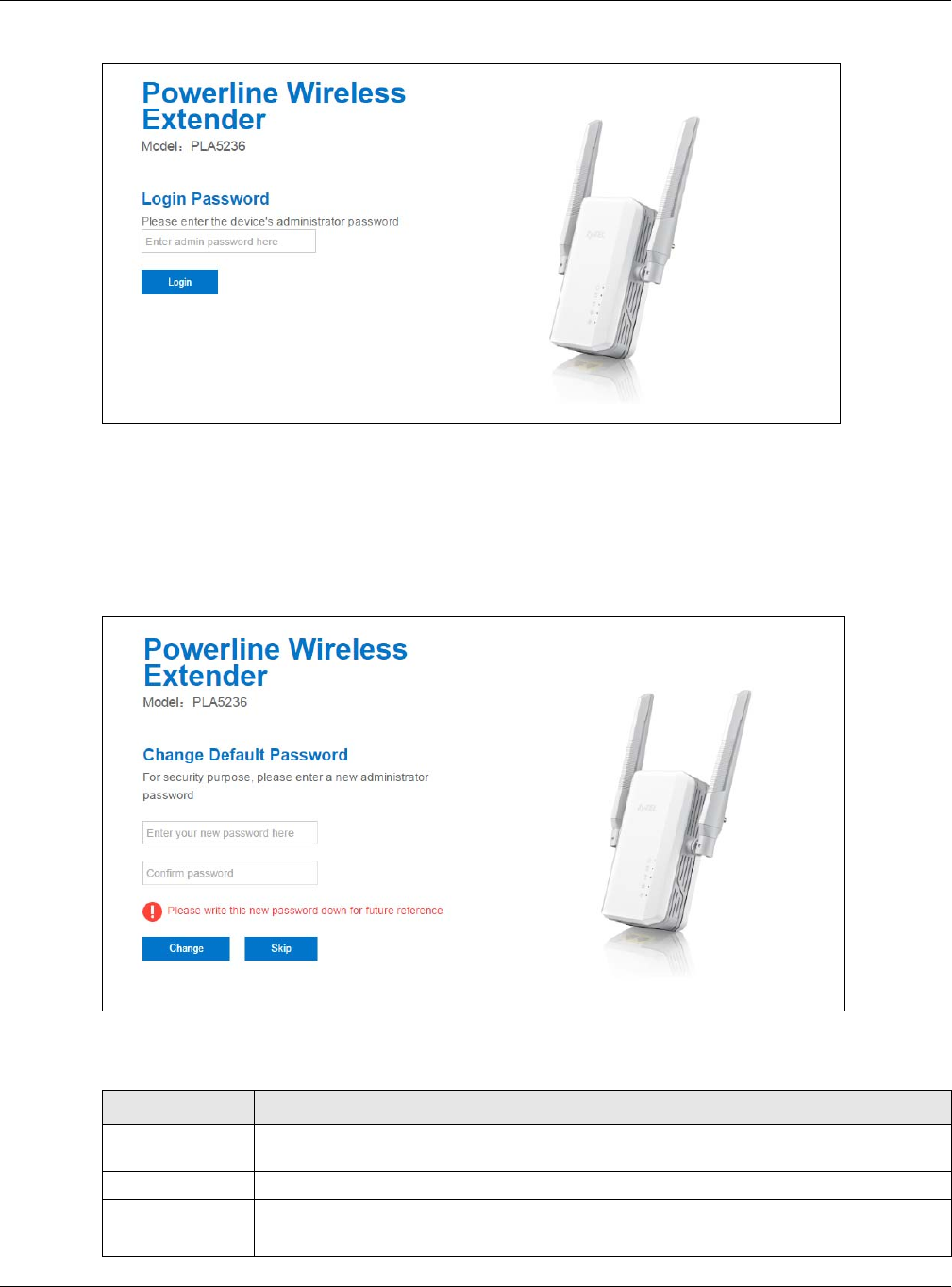
Chapter 3 Introducing the Web Configurator
PLA5236 User’s Guide
19
Figure 7 Login screen
Type “1234” (default) as the password.
3.2.2 Password Screen
You should see a screen asking you to change your password (highly recommended) as shown next.
Figure 8 Change Password Screen
The following table describes the labels in this screen.
Table 4 Change Password Screen
LABEL DESCRIPTION
Enter Your New
Password Here
Type a new password.
Confirm Password Retype the password for confirmation.
Change Click Change to save your changes back to the PLA.
Skip Click Skip if you do not want to change the password this time.
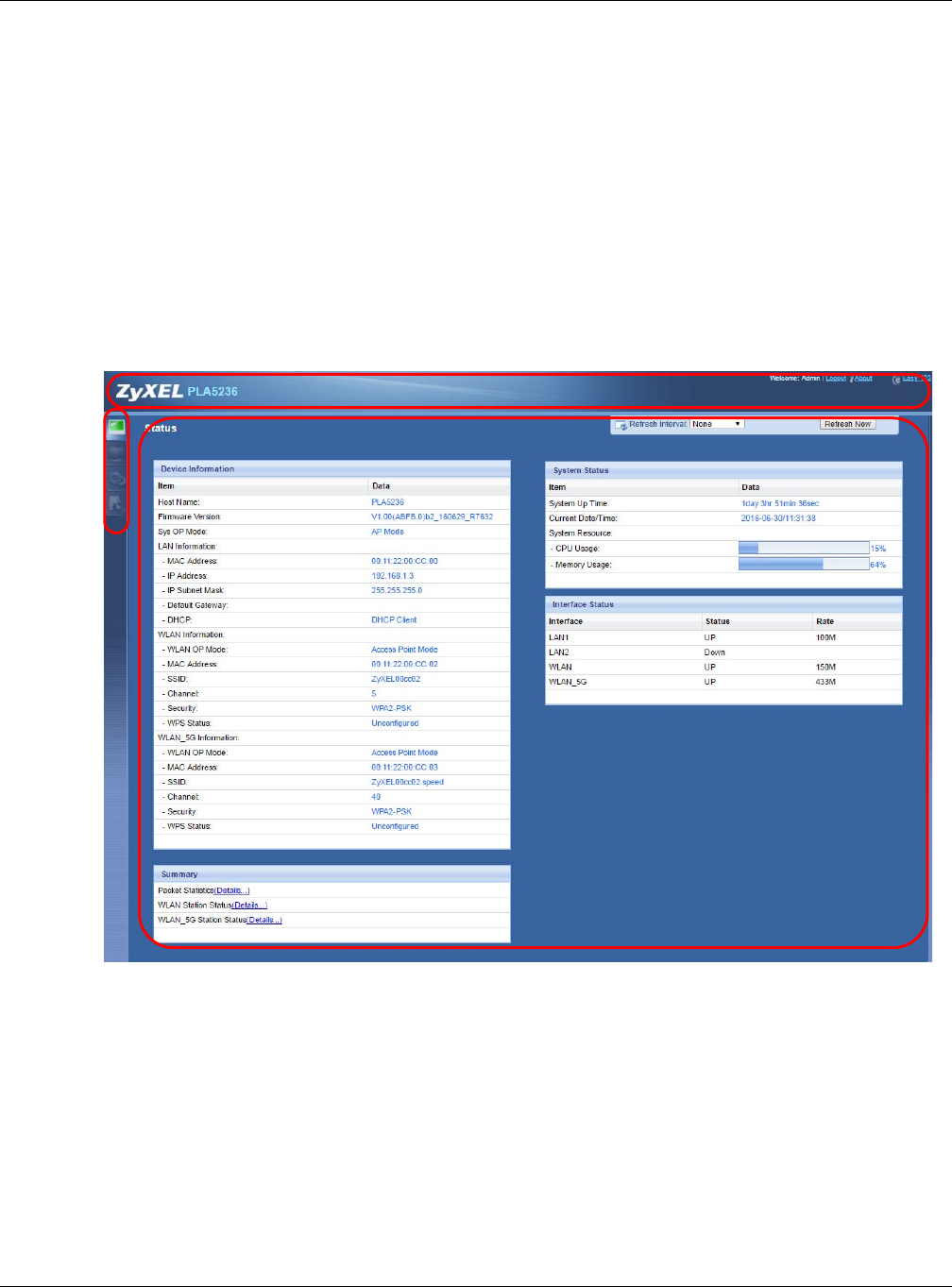
Chapter 3 Introducing the Web Configurator
PLA5236 User’s Guide
20
Note: The management session automatically times out when the time period set in the
Administrator Inactivity Timer field expires (default five minutes; go to Chapter 11 on
page 56 to change this). Simply log back into the PLA if this happens.
Right after you log in, the Dashboard screen is displayed. See Chapter 4 on page 23 for more
information about the Dashboard screen.
3.3 Navigating the Web Configurator
The following summarizes how to navigate the web configurator from the Dashboard screen.
Figure 9 Status Screen of the Web Configurator
As illustrated above, the Web Configurator screen is divided into these parts:
•A - title bar
•B - navigation panel
•C - main window
3.3.1 Title Bar
Click Logout at any time to exit the Web Configurator.
A
BC

Chapter 3 Introducing the Web Configurator
PLA5236 User’s Guide
21
Click About to open the about window, which provides information of the boot module and driver
versions.
Click Easy 123 to select the PLA Wi-Fi mode and give a name and password to identify your PLA in the
Wi-Fi network.
3.3.2 Navigation Panel
Use the menu items on the navigation panel to open screens to configure PLA features. The following
tables describe each menu item.
Table 5 Navigation Panel: Access Point Mode
LINK TAB FUNCTION
Dashboard This screen shows the PLA’s general device, system and interface status
information. Use this screen to access the summary statistics tables.
MONITOR
Log Use this screen to view the list of activities recorded by your PLA.
Packet Statistics Use this screen to view port status and packet specific statistics.
WLAN 2.4G
Station Status
Use this screen to view the details about the devices connected to your PLA,
using the 2.5G wireless connection.
WLAN 5G Station
Status
Use this screen to view the details about the devices connected to your PLA,
using the 5G wireless connection.
CONFIGURATION
Network
Wireless LAN
2.4 and
Wireless LAN
5G
General Use this screen to configure general wireless LAN and wireless security settings.
MAC Filter Use the MAC filter screen to configure the PLA to block access to devices or
block the devices from accessing the PLA.
Advanced This screen allows you to configure advanced wireless settings.
QoS Use this screen to configure Wi-Fi Multimedia Quality of Service (WMM QoS).
WMM QoS allows you to prioritize wireless traffic according to the delivery
requirements of individual services.
WPS Use this screen to configure WPS.
WPS Station Use this screen to add a wireless station using WPS.
Scheduling Use this screen to schedule the times the Wireless LAN is enabled.
LAN IP Use this screen to configure LAN IP address and subnet mask.
IP Alias Use this screen to have the PLA apply IP alias to create LAN subnets.
HomePlug Powerline
Setting
Use this screen to view and change powerline settings.
One Connect Use this screen to enable the One Connect feature. One Connect uses an app
that allows you to easily integrate the PLA and other devices to your home
network.
MAINTENANCE
General Use this screen to view and change administrative settings such as system and
domain names.
Password Password
Setup
Use this screen to change the password of your PLA.
Time Time Setting Use this screen to change your PLA’s time and date.
Firmware
Upgrade Use this screen to upload firmware to your PLA.

Chapter 3 Introducing the Web Configurator
PLA5236 User’s Guide
22
Backup/
Restore Use this screen to backup and restore the configuration or reset your PLA to
the factory defaults.
Restart System Restart This screen allows you to reboot the PLA without turning the power off.
Language Language This screen allows you to select the language you prefer.
WiFi Mode This screen allows you to select the device Wi-Fi mode: Range Mode,
Performance Mode or Mixed Mode.
Table 5 Navigation Panel: Access Point Mode
LINK TAB FUNCTION
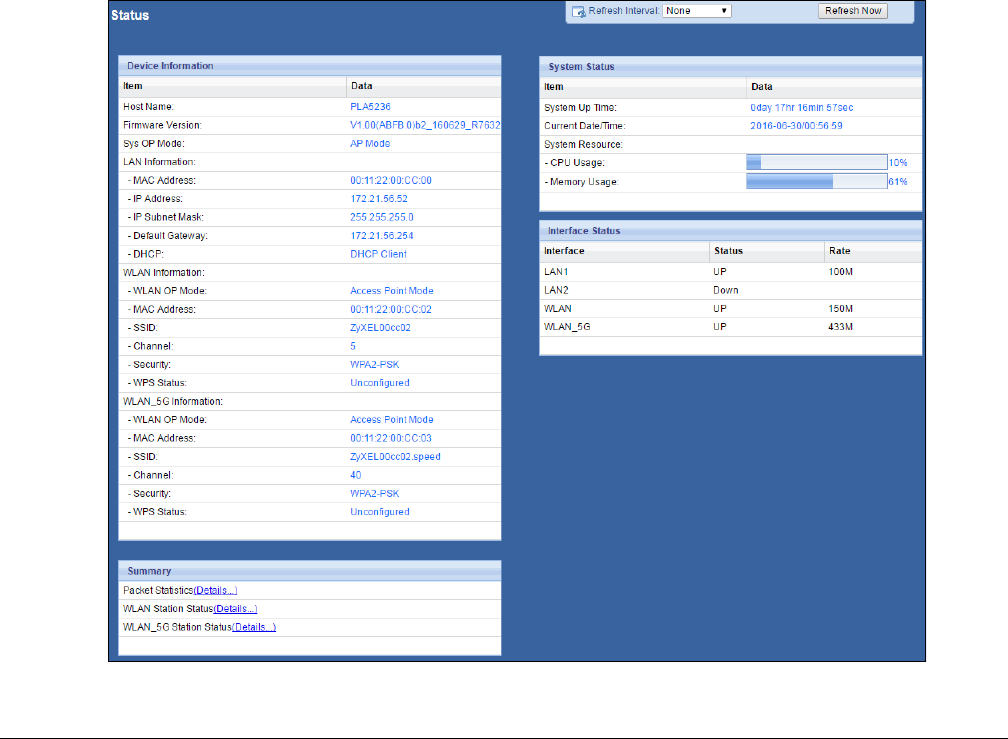
PLA5236 User’s Guide
23
CHAPTER 4
Dashboard
The Dashboard screens display when you log into the PLA, or click Dashboard in the navigation menu.
Use the Dashboard screen to look at the current status of the device, system resources, and interfaces.
The Dashboard screens also provide detailed information about system statistics, associated wireless
clients, and logs.
4.1 The Dashboard Screen
Use this screen to get a quick view of system, Ethernet, WLAN and other information regarding your PLA.
Click Dashboard. The following screen displays.
Figure 10 The Dashboard Screen

Chapter 4 Dashboard
PLA5236 User’s Guide
24
The following table describes the labels in this screen.
Table 6 The Dashboard Screen
LABEL DESCRIPTION
Refresh Interval Select a number of seconds or None from the drop-down list box to refresh all screen statistics
automatically at the end of every time interval or to not refresh the screen statistics.
Refresh Now Click this button to refresh the status screen statistics.
Device Information
Host Name This is the PLA’s model name.
Firmware Version This is the firmware version and the date created.
Sys OP Mode This is the device mode, the PLA works as an Access Point (AP).
LAN Information
MAC Address This shows the LAN Ethernet adapter MAC Address of your device.
IP Address This shows the LAN port’s IP address.
IP Subnet Mask This shows the LAN port’s subnet mask.
Default Gateway This shows the gateway IP address.
DHCP This shows the LAN port’s DHCP role - Client or None.
WLAN Information
WLAN OP Mode This is the device mode to which the PLA’s 2.4GHz wireless LAN is set - Access Point Mode.
MAC Address This shows the wireless adapter MAC Address of your device.
SSID This shows a descriptive name used to identify the PLA in the wireless LAN.
Channel This shows the channel number which the PLA is currently using over the wireless LAN.
Security This shows the level of wireless security the PLA is using.
WPS Status This displays Configured when the WPS has been set up.
This displays Unconfigured if the WPS has not been set up.
WLAN_5G Information
WLAN OP Mode This is the device mode to which the PLA’s 5GHz wireless LAN is set - Access Point Mode.
MAC Address This shows the wireless adapter MAC Address of your device.
SSID This shows a descriptive name used to identify the PLA in the wireless LAN.
Channel This shows the channel number which the PLA is currently using over the wireless LAN.
Security This shows the level of wireless security the PLA is using.
WPS Status This displays Configured when the WPS has been set up.
This displays Unconfigured if the WPS has not been set up.
Summary
Packet Statistics Click Details... to go to the Monitor > Packet Statistics screen (Section 6.4 on page 29). Use this
screen to view port status and packet specific statistics.
WLAN Station Status Click Details... to go to the Monitor > WLAN Station Status screen (Section 6.5 on page 30). Use this
screen to view the 2.4Ghz wireless stations that are currently associated to the PLA.
WLAN_5G Station Status Click Details... to go to the Monitor > WLAN Station Status screen (Section 6.6 on page 31). Use this
screen to view the 5Ghz wireless stations that are currently associated to the PLA.
System Status
Item This column shows the type of data the PLA is recording.
Data This column shows the actual data recorded by the PLA.
System Up Time This is the total time the PLA has been on.

Chapter 4 Dashboard
PLA5236 User’s Guide
25
Current Date/Time This field displays your PLA’s present date and time.
System Resource
CPU Usage This displays what percentage of the PLA’s processing ability is currently used. When this
percentage is close to 100%, the PLA is running at full load, and the throughput is not going to
improve anymore. If you want some applications to have more throughput, you should turn off
other applications (for example, using bandwidth management.
Memory Usage This shows what percentage of the heap memory the PLA is using.
Interface Status
Interface This displays the PLA port types. The port types are: LAN and WLAN.
Status For the LAN ports, this field displays Down (line is down) or Up (line is up or connected).
For the WLAN, it displays Up when the WLAN is enabled or Down when the WLAN is disabled.
Rate For the LAN ports, this displays the port speed or N/A when the line is disconnected.
For the WLAN, it displays the maximum transmission rate when the WLAN is enabled and N/A
when the WLAN is disabled.
Table 6 The Dashboard Screen
LABEL DESCRIPTION
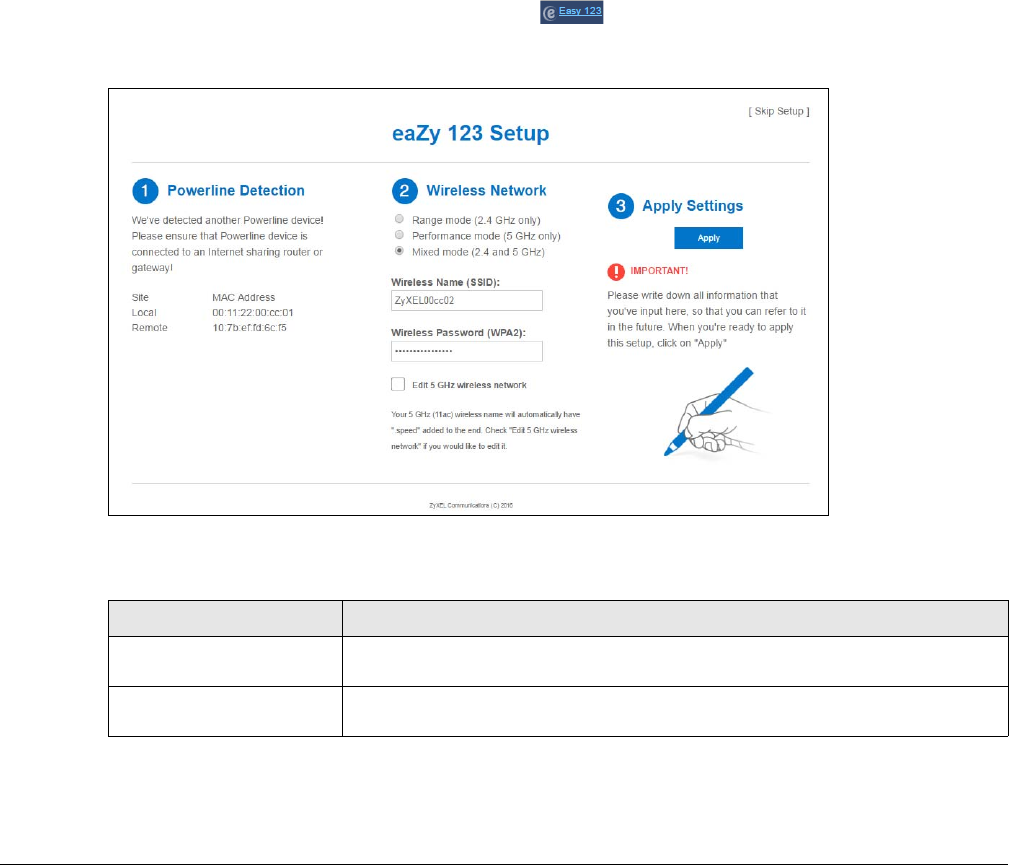
PLA5236 User’s Guide
26
CHAPTER 5
Connection Wizard
5.1 Overview
This Chapter provides information on the Wizard setup screens in the Web Configurator. The Web
Configurator Wizard setup helps you configure your device.
5.2 Using the Web Configurator Wizard
After you access the PLA Web Configurator. click to begin the Wizard setup, located in the Title
Bar on the Dashboard Screen.
Figure 11 Wizard Setup Screen
The following table describes the labels in this screen.
Table 7 Wizard Setup Screen
LABEL DESCRIPTION
Powerline Detection This shows details of the connection between other powerline adapters and your
PLA.
Detect Again Click Detect Again to refresh your PLA and connect with other powerline Ethernet
adapters.

Chapter 5 Connection Wizard
PLA5236 User’s Guide
27
Wireless Network Use this step to configure your PLA wireless network. Choose one of the Wi-Fi modes.
Range Mode enables a 2.4GHz Wi-Fi, with a wider range for your Wi-Fi devices.
Choose this mode if all your Wi-Fi devices are IEEE 802.11 b/g/n compatible.
Performance Mode enables a 5Ghz Wi-Fi, with a better performance than 2.4Ghz,
but a shorter range for your Wi-Fi devices. Choose this mode if all your Wi-Fi devices
are IEEE 802.11 a/n/ac compatible.
Mixed Mode enables both 2.5GHz and 5GHz Wi-Fi for all devices to connect.
Choose this mode if you have IEEE 802.11 a/n/ac and IEEE802.11 b/g/n Wi-Fi devices
connecting to your wireless network.
Wireless Name (SSID) Enter a descriptive name used to identify your PLA in the wireless network.
Wireless Password (WPA2) Enter the password that lets you connect to the PLA wireless network. Your password
should be in a string of ASCII characters between 8 and 63 or hexadecimal
characters between 8 and 64.
Edit 5GHz wireless network For Mixed Mode an additional SSID and password field appear for your 5Ghz wireless
network.
Click this to view and/or change your 5Ghz wireless network SSID and password.
Apply Settings Click Apply to save your settings to the PLA.
Skip Setup Click this to skip the Wizard setup and go to the Dashboard screen.
Table 7 Wizard Setup Screen
LABEL DESCRIPTION

PLA5236 User’s Guide
28
CHAPTER 6
Monitor
6.1 Overview
This chapter discusses read-only information related to the device state of the PLA.
Note: To access the Monitor screens, you can also click the links in the Summary table of the
Status screen to view the packets sent/received as well as the status of clients
connected to the PLA.
6.2 What You Can Do
• Use the Log screen (Section 6.3 on page 28) to view the logs for the categories such as system
maintenance, system errors, and so on.
• use the Packet Statistics screen (Section 6.4 on page 29) to view port status, packet specific statistics,
the "system up time" and so on.
• Use the WLAN Station Status screen (Section 6.5 on page 30) to view the wireless stations that are
currently associated to the PLA.
• Use the WLAN_5G Station Status screen (Section 6.6 on page 31) to view the wireless stations that are
currently associated to the PLA.
6.3 Log
Use the View Log screen to see the logged messages for the PLA.
Log entries in red indicate system error logs. The log wraps around and deletes the old entries after it fills.
Click Monitor > Log.
Figure 12 Monitor > View Log
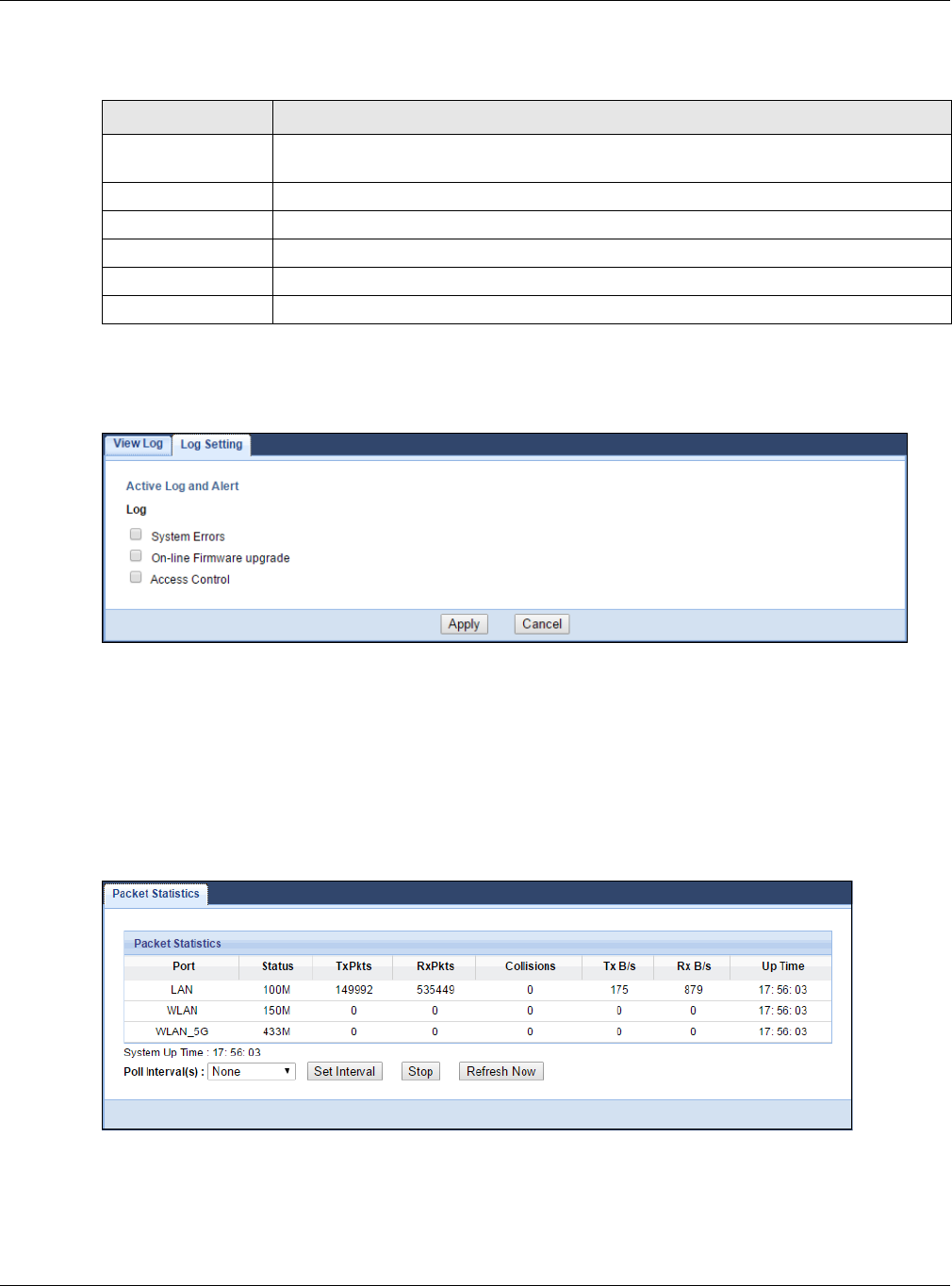
Chapter 6 Monitor
PLA5236 User’s Guide
29
The following table describes the labels in this screen.
You can configure which logs to display in the View Log screen. Go to the Log Setting screen and select
the logs you wish to display. Click Apply to save your settings. Click Cancel to start the screen afresh.
Figure 13 Monitor > Log Setting
6.4 Packet Statistics
Click the Packet Statistics (Details...) hyperlink in the Dashboard screen or Monitor > Packet Statistics.
Read-only information here includes port status, packet specific statistics and the "system up time". The
Poll Interval(s) field is configurable and is used for refreshing the screen.
Figure 14 Monitor > Packet Statistics
Table 8 Monitor > Log
LABEL DESCRIPTION
Display Select what logs you want to see from the Display drop list. The log choices depend on your
settings in the Log Setting screen.
Refresh Click Refresh to renew the log screen.
Clear Log Click Clear Log to delete all the logs.
#This field is a sequential value and is not associated with a specific entry.
Time This field displays the time the log was recorded.
Message This field states the reason for the log.
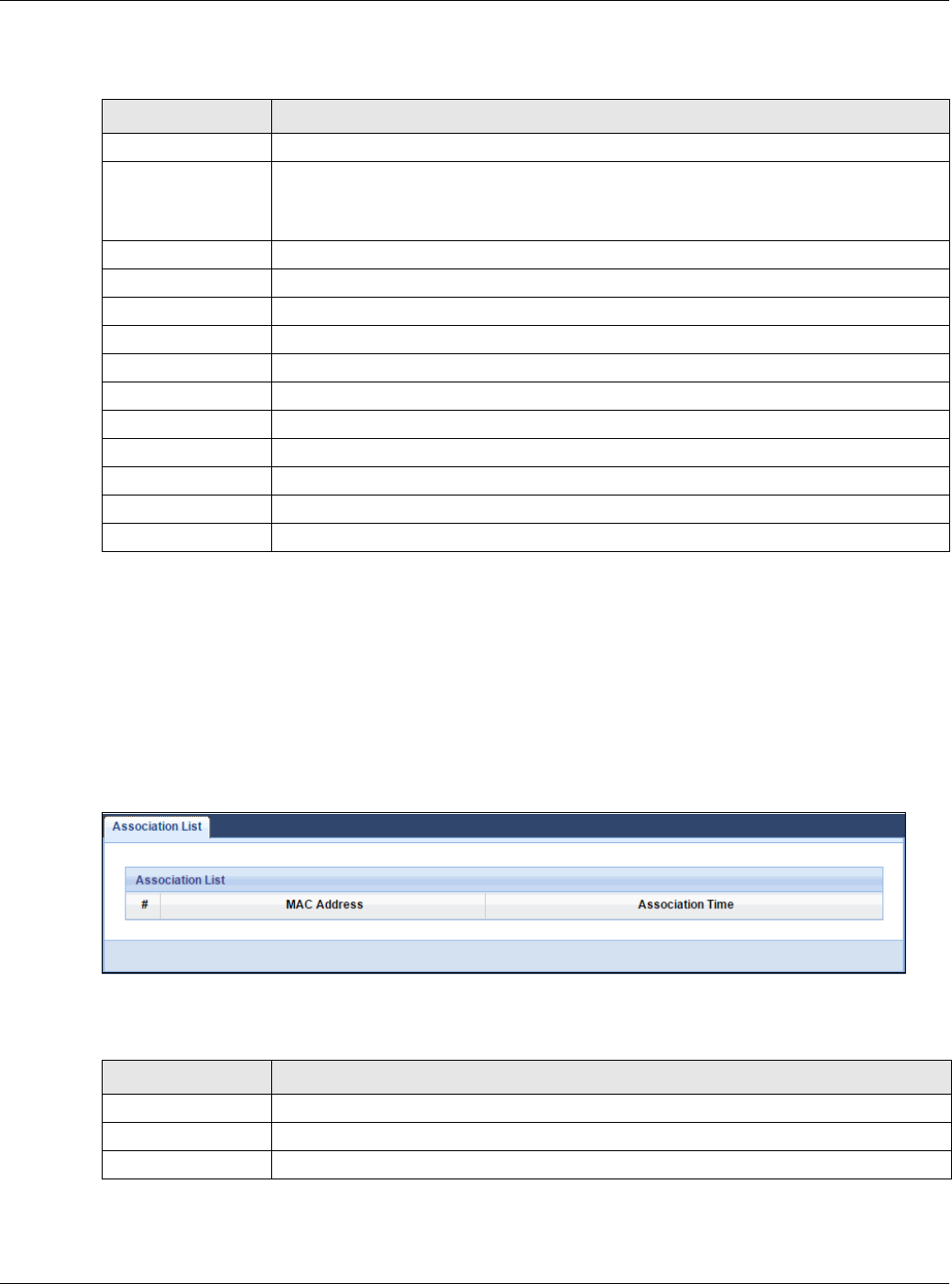
Chapter 6 Monitor
PLA5236 User’s Guide
30
The following table describes the labels in this screen.
6.5 WLAN 2.4G Station Status
Click the WLAN Station Status (Details...) hyperlink in the Dashboard screen or Monitor > WLAN 2.4G
Station Status. View the 2.4G wireless stations that are currently associated to the PLA in the Association
List. Association means that a wireless client (for example, your network or computer with a wireless
network card) has connected successfully to the PLA using the same SSID, channel and security settings.
Figure 15 Monitor > WLAN Station Status
The following table describes the labels in this screen.
Table 9 Monitor > Packet Statistics
LABEL DESCRIPTION
Port This is the PLA’s interface type.
Status For the LAN port, this displays the port speed or Down when the line is disconnected.
For the WLAN, it displays the maximum transmission rate when the WLAN is enabled and
Down when the WLAN is disabled.
TxPkts This is the number of transmitted packets on this port.
RxPkts This is the number of received packets on this port.
Collisions This is the number of collisions on this port.
Tx B/s This displays the transmission speed in bytes per second on this port.
Rx B/s This displays the reception speed in bytes per second on this port.
Up Time This is the total time the PLA has been for each session.
System Up Time This is the total time the PLA has been on.
Poll Interval(s) Enter the time interval in seconds for refreshing statistics in this field.
Set Interval Click this button to apply the new poll interval you entered in the Poll Interval(s) field.
Stop Click Stop to stop refreshing statistics.
Refresh Now Click this button to refresh the Packet Statistics screen.
Table 10 Monitor > WLAN Station Status
LABEL DESCRIPTION
# This is the index number of an associated wireless station.
MAC Address This field displays the MAC address of an associated wireless station.
Association Time This field displays the time a wireless station first associated with the PLA’s WLAN network.
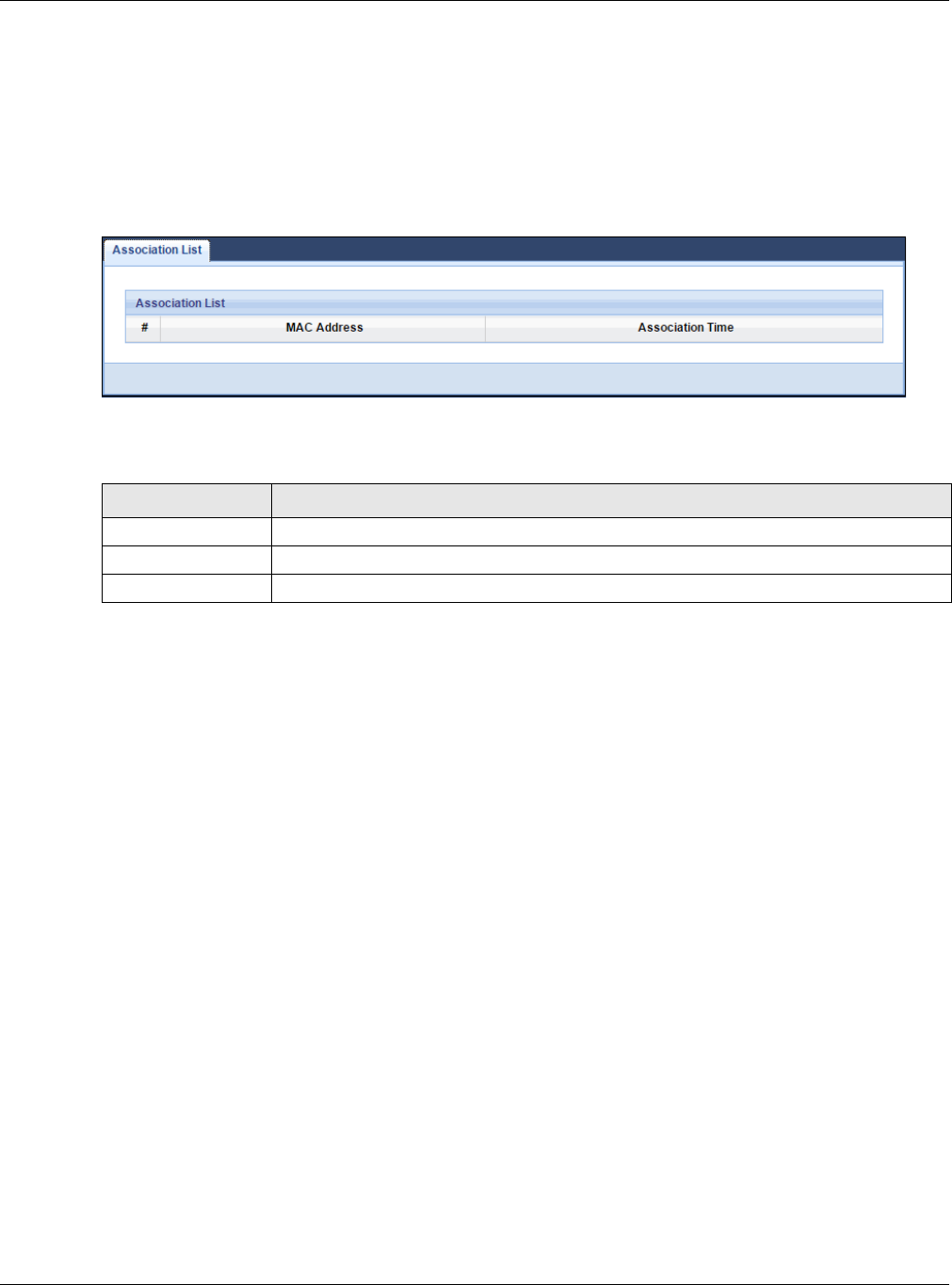
Chapter 6 Monitor
PLA5236 User’s Guide
31
6.6 WLAN 5G Station Status
Click the WLAN_5G Station Status (Details...) hyperlink in the Dashboard screen or Monitor > WLAN 5G
Station Status. View the 5G wireless stations that are currently associated to the PLA in the Association
List. Association means that a wireless client (for example, your network or computer with a wireless
network card) has connected successfully to the PLA using the same SSID, channel and security settings.
Figure 16 Monitor > WLAN 5G Station Status
The following table describes the labels in this screen.
Table 11 Monitor > WLAN 5G Station Status
LABEL DESCRIPTION
# This is the index number of an associated wireless station.
MAC Address This field displays the MAC address of an associated wireless station.
Association Time This field displays the time a wireless station first associated with the PLA’s WLAN network.
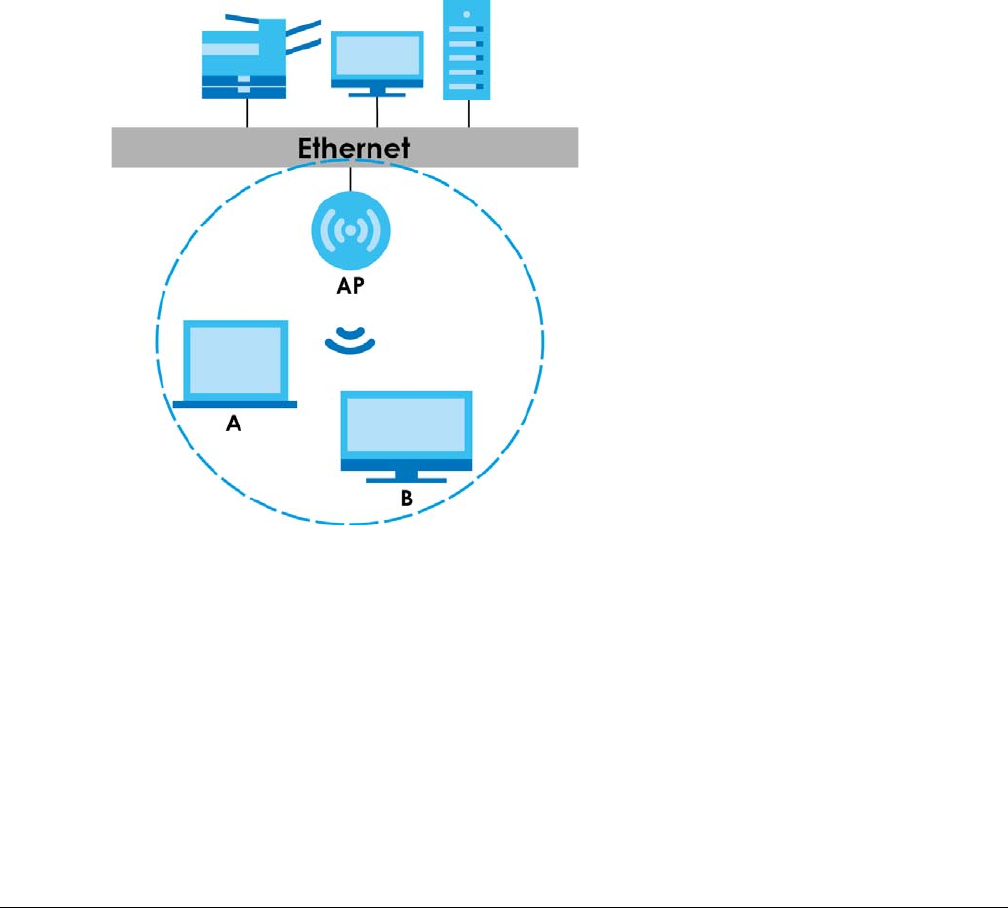
PLA5236 User’s Guide
32
CHAPTER 7
Wireless LAN
7.1 Overview
This chapter discusses how to configure the wireless network settings in your PLA. See the appendices for
more detailed information about wireless networks.
The following figure provides an example of a wireless network.
Figure 17 Example of a Wireless Network
The wireless network is the part in the blue circle. In this wireless network, devices A and B are called
wireless clients. The wireless clients use the access point (AP) to interact with other devices (such as the
printer) or with the Internet. Your PLA is the AP.
7.1.1 Powerline Extended Wireless LAN
The PLA is a wireless Powerline Extender (PE) that allows you to extend your original wireless network,
connected to a compatible Powerline Adapter (PA) over a power cable. This is the key for items in
Figure 18 on page 33:
• PE = Powerline Extender (= PLA here)
• PEN = PE wireless Network
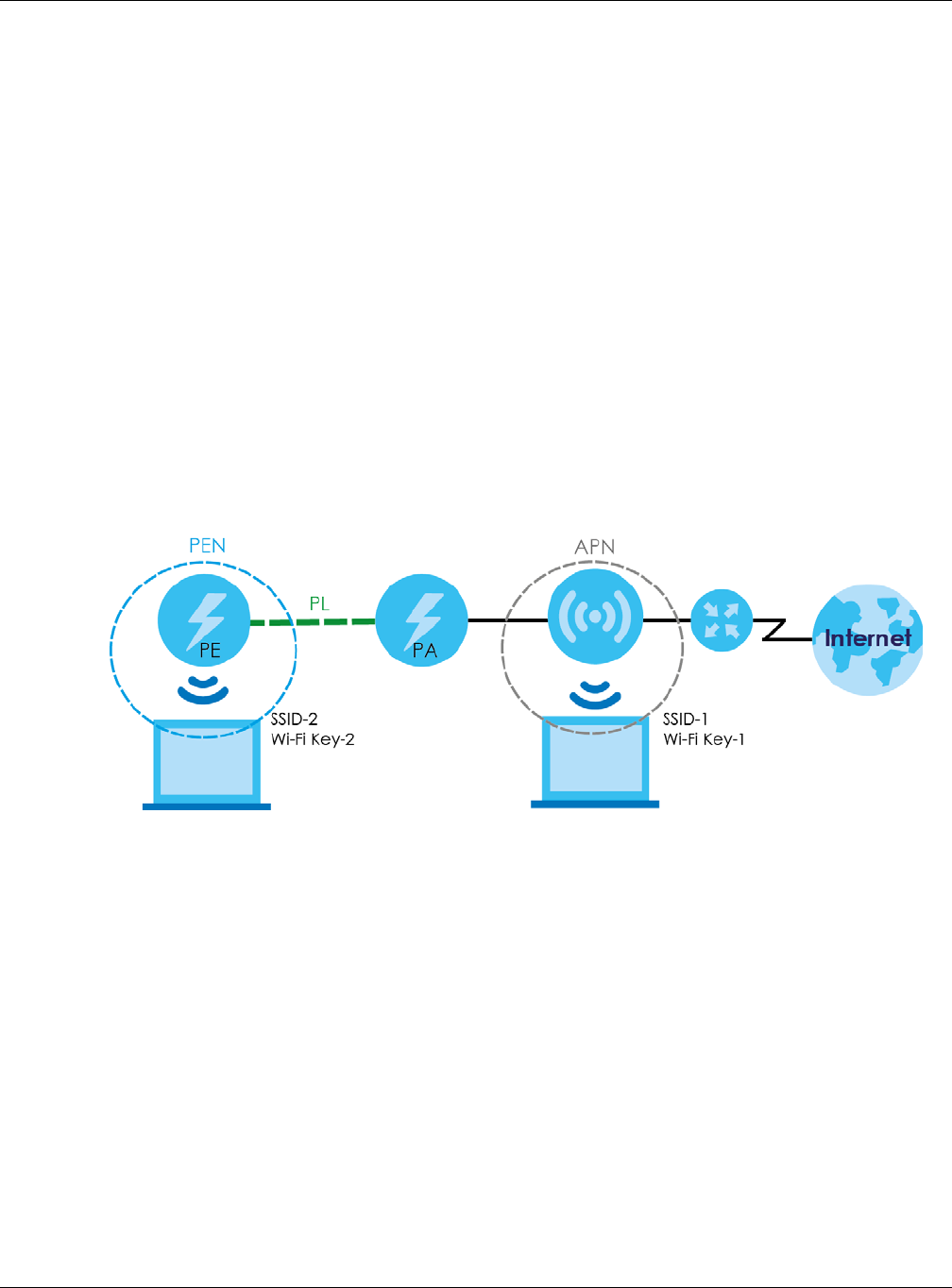
Chapter 7 Wireless LAN
PLA5236 User’s Guide
33
• PA = Powerline Adapter
• APN = Your existing wireless router or AP wireless Network
• PL = Powerline connection
Using a PE is desirable when you want to expand your existing wireless network, there is a power
connection to it, and the PE is located beyond the Wi-Fi range of the AP, or there are obstructions, such
as thick walls, impeding Wi-Fi signals between them.
These are some ways to configure the PLA for Wi-Fi access in the PE location.
• Use the default PLA wireless settings (SSID = ZyXEL, no Wi-Fi key). No configuration is necessary, but the
PLA wireless network is open (no Wi-Fi key) and vulnerable.
• Copy the AP settings to the PLA using the WPS button. When using WPS to copy wireless settings, the
PLA4213 must be within 5 meters of the AP. After a successful copy, position them where you want
them in your Powerline network. This allows seamless wireless roaming between APN and PEN
networks but some wireless clients may have problems if they discover duplicate SSIDs. You also won’t
know if your wireless device is connecting to the APN or the PEN.
• Use the web configurator to configure a different SSID and Wi-Fi key on the PLA (SSID-2, Wi-Fi Key-2).
Roaming is not seamless as you need to manually connect to the PEN when the signal from the APN
becomes weak (and vice-versa).
Figure 18 Powerline Extended Wireless LAN
7.2 What You Can Do
• Use the General screen (Section 7.4 on page 35) to turn the wireless connection on or off, enter the
SSID, select the channel, and configure wireless security between the PLA and the wireless clients.
• Use the MAC Filter screen (Section 7.6 on page 41) to allow or deny wireless stations based on their
MAC addresses from connecting to the PLA.
• Use the Advanced screen (Section 7.7 on page 42) to configure wireless advanced features, such as
set the RTS/CTS Threshold and HT physical mode.
• Use the QoS screen (Section 7.8 on page 43) to enable Wi-fi MultiMedia Quality of Service
(WMMQoS). This allows the PLA to automatically set priority levels to services, such as e-mail, VoIP,
chat, and so on.
• Use the WPS screen (Section 7.9 on page 44) to quickly set up a wireless network with strong security,
without having to configure security settings manually.
• Use the WPS Station screen (Section 7.10 on page 45) to add a wireless station using WPS.

Chapter 7 Wireless LAN
PLA5236 User’s Guide
34
• Use the Scheduling screen (Section 7.11 on page 46) to set the times your wireless LAN is turned on
and off.
7.3 What You Should Know
Every wireless network must follow these basic guidelines.
• Every wireless client in the same wireless network must use the same SSID.
The SSID is the name of the wireless network. It stands for Service Set IDentity.
• If two wireless networks overlap, they should use different channels.
Like radio stations or television channels, each wireless network uses a specific channel, or frequency,
to send and receive information.
• Every wireless client in the same wireless network must use security compatible with the AP.
Security stops unauthorized devices from using the wireless network. It can also protect the
information that is sent in the wireless network.
7.3.1 Wireless Security Overview
The following sections introduce different types of wireless security you can set up in the wireless
network.
7.3.1.1 SSID
Normally, the AP acts like a beacon and regularly broadcasts the SSID in the area. You can hide the
SSID instead, in which case the AP does not broadcast the SSID. In addition, you should change the
default SSID to something that is difficult to guess.
This type of security is fairly weak, however, because there are ways for unauthorized devices to get the
SSID. In addition, unauthorized devices can still see the information that is sent in the wireless network.
7.3.1.2 MAC Address Filter
Every wireless client has a unique identification number, called a MAC address.1 A MAC address is
usually written using twelve hexadecimal characters2; for example, 00A0C5000002 or 00:A0:C5:00:00:02.
To get the MAC address for each wireless client, see the appropriate User’s Guide or other
documentation.
You can use the MAC address filter to tell the AP which wireless clients are allowed or not allowed to use
the wireless network. If a wireless client is allowed to use the wireless network, it still has to have the
correct settings (SSID, channel, and security). If a wireless client is not allowed to use the wireless
network, it does not matter if it has the correct settings.
This type of security does not protect the information that is sent in the wireless network. Furthermore,
there are ways for unauthorized devices to get the MAC address of an authorized wireless client. Then,
they can use that MAC address to use the wireless network.
1. Some wireless devices, such as scanners, can detect wireless networks but cannot use wireless networks. These
kinds of wireless devices might not have MAC addresses.
2. Hexadecimal characters are 0, 1, 2, 3, 4, 5, 6, 7, 8, 9, A, B, C, D, E, and F.

Chapter 7 Wireless LAN
PLA5236 User’s Guide
35
Encryption
Wireless networks can use encryption to protect the information that is sent in the wireless network.
Encryption is like a secret code. If you do not know the secret code, you cannot understand the
message.
Usually, you should set up the strongest encryption that every wireless client in the wireless network
supports. For example, suppose the AP does not have a local user database, and you do not have a
RADIUS server. Therefore, there is no user authentication. Suppose the wireless network has two wireless
clients. Device A only supports WEP, and device B supports WEP and WPA. Therefore, you should set up
Static WEP in the wireless network.
Note: It is recommended that wireless networks use WPA-PSK or stronger encryption. WEP
encryption are better than none at all, but it is still possible for unauthorized devices to
figure out the original information pretty quickly.
When you select WPA2-PSK in your PLA, you can also select an option (WPA-PSK Compatible) to support
WPA as well. In this case, if some wireless clients support WPA and some support WPA2, you should set up
WPA2-PSK and select the WPA-PSK Compatible option in the PLA.
Many types of encryption use a key to protect the information in the wireless network. The longer the
key, the stronger the encryption. Every wireless client in the wireless network must have the same key.
7.3.1.3 WPS
Wi-Fi Protected Setup (WPS) is an industry standard specification, defined by the Wi-Fi Alliance. WPS
allows you to quickly set up a wireless network with strong security, without having to configure security
settings manually. Depending on the devices in your network, you can either press a button (on the
device itself) or enter a PIN (Personal Identification Number) in the devices. Then, they connect and set
up a secure network by themselves.
7.4 General Wireless LAN Screen
Use this screen to enable or disable the WLAN, enter the SSID, select the channel and configure wireless
security settings.
Note: If you are configuring the PLA from a computer connected to the wireless LAN and you
change the PLA’s SSID, channel or security settings, you will lose your wireless
connection when you press Apply to confirm. You must then change the wireless
settings of your computer to match the PLA’s new settings.
Click Network > Wireless LAN 2.4G or 5G to open the General screen.
Table 12 Types of Encryption
Weakest No Security
Static WEP
WPA-PSK
Strongest WPA2-PSK
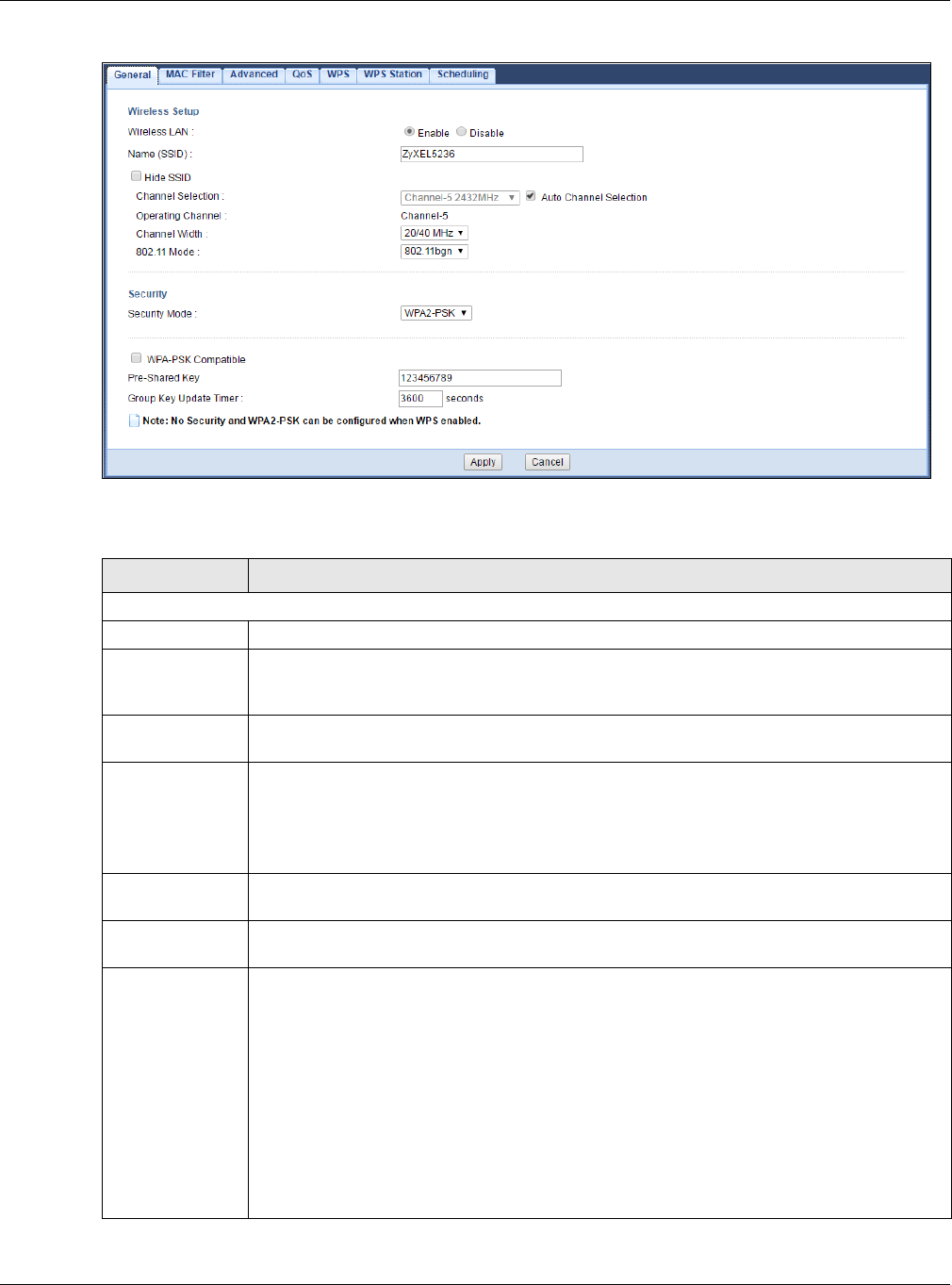
Chapter 7 Wireless LAN
PLA5236 User’s Guide
36
Figure 19 Network > Wireless LAN 2.4G or 5G> General
The following table describes the general wireless LAN labels in this screen.
Table 13 Network > Wireless LAN 2.4G or 5G> General
LABEL DESCRIPTION
Wireless Setup
Wireless LAN Select to enable or disable the wireless LAN. This is turned on by default.
Name (SSID) The SSID (Service Set IDentity) identifies the Service Set with which a wireless client is associated.
Enter a descriptive name (up to 32 printable characters found on a typical English language
keyboard) for the wireless LAN.
Hide SSID Select this check box to hide the SSID in the outgoing beacon frame so a wireless client cannot
obtain the SSID through scanning using a site survey tool.
Channel
Selection
Set the operating frequency/channel depending on your particular region.
Select a channel from the drop-down list box. The options vary depending on the frequency
band and the country you are in.
This option is only available if Auto Channel Selection is disabled.
Auto Channel
Selection Select the check box to have the PLA automatically scan for and select a channel which is not
used by another device.
Operating
Channel
This displays the channel the PLA is currently using.
Channel Width Select the wireless channel width used by PLA.
A standard 20 MHz channel offers transfer speeds of up to 150Mbps whereas a 40 MHz channel
uses two standard channels and offers speeds of up to 300Mbps.
Because not all devices support 40 MHz channels, select Auto 20/40 MHz to allow the PLA to
adjust the channel bandwidth automatically.
40 MHz (channel bonding or dual channel) bonds two adjacent radio channels to increase
throughput. The wireless clients must also support 40 MHz. It is often better to use the 20 MHz
setting in a location where the environment hinders the wireless signal.
Select 20 MHz if you want to lessen radio interference with other wireless devices in your
neighborhood or the wireless clients do not support channel bonding.

Chapter 7 Wireless LAN
PLA5236 User’s Guide
37
7.5 Wireless Security
The screen varies depending on what you select in the Security Mode field.
7.5.1 No Security
Select No Security to allow wireless clients to communicate with the access points without any data
encryption.
Note: If you do not enable any wireless security on your PLA, your network is accessible to any
wireless networking device that is within range.
802.11 Mode You can select from the following:
•802.11b: allows either IEEE 802.11b or IEEE 802.11g compliant WLAN devices to associate
with the PLA. In this mode, all wireless devices can only transmit at the data rates supported
by IEEE 802.11b.
•802.11g: allows IEEE 802.11g compliant WLAN devices to associate with the Device. IEEE
802.11b compliant WLAN devices can associate with the PLA only when they use the short
preamble type.
•802.11bg: allows either IEEE 802.11b or IEEE 802.11g compliant WLAN devices to associate
with the PLA. The PLA adjusts the transmission rate automatically according to the wireless
standard supported by the wireless devices.
•802.11n: allows IEEE 802.11n compliant WLAN devices to associate with the PLA. This can
increase transmission rates, although IEEE 802.11b or IEEE 802.11g clients will not be able to
connect to the PLA. I
•802.11gn: allows either IEEE 802.11g or IEEE 802.11n compliant WLAN devices to associate
with the PLA. The transmission rate of your PLA might be reduced.
•802.11 bgn: allows IEEE802.11b, IEEE802.11g and IEEE802.11n compliant WLAN devices to
associate with the PLA. The transmission rate of your PLA might be reduced.
Security
Security Mode Select Static WEP, WPA-PSK, or WPA2-PSK to add security on this wireless network. The wireless
clients which want to associate to this network must have same wireless security settings as this
device. After you select to use a security, additional options appears in this screen. See Section
7.5 on page 37 for detailed information on different security modes. Or you can select No
Security to allow any client to associate this network without authentication.
Note: If the WPS function is enabled (default), only No Security and WPA2-PSK are
available in this field.
Apply Click Apply to save your changes back to the PLA.
Cancel Click Cancel to reload the previous configuration for this screen.
Table 13 Network > Wireless LAN 2.4G or 5G> General
LABEL DESCRIPTION
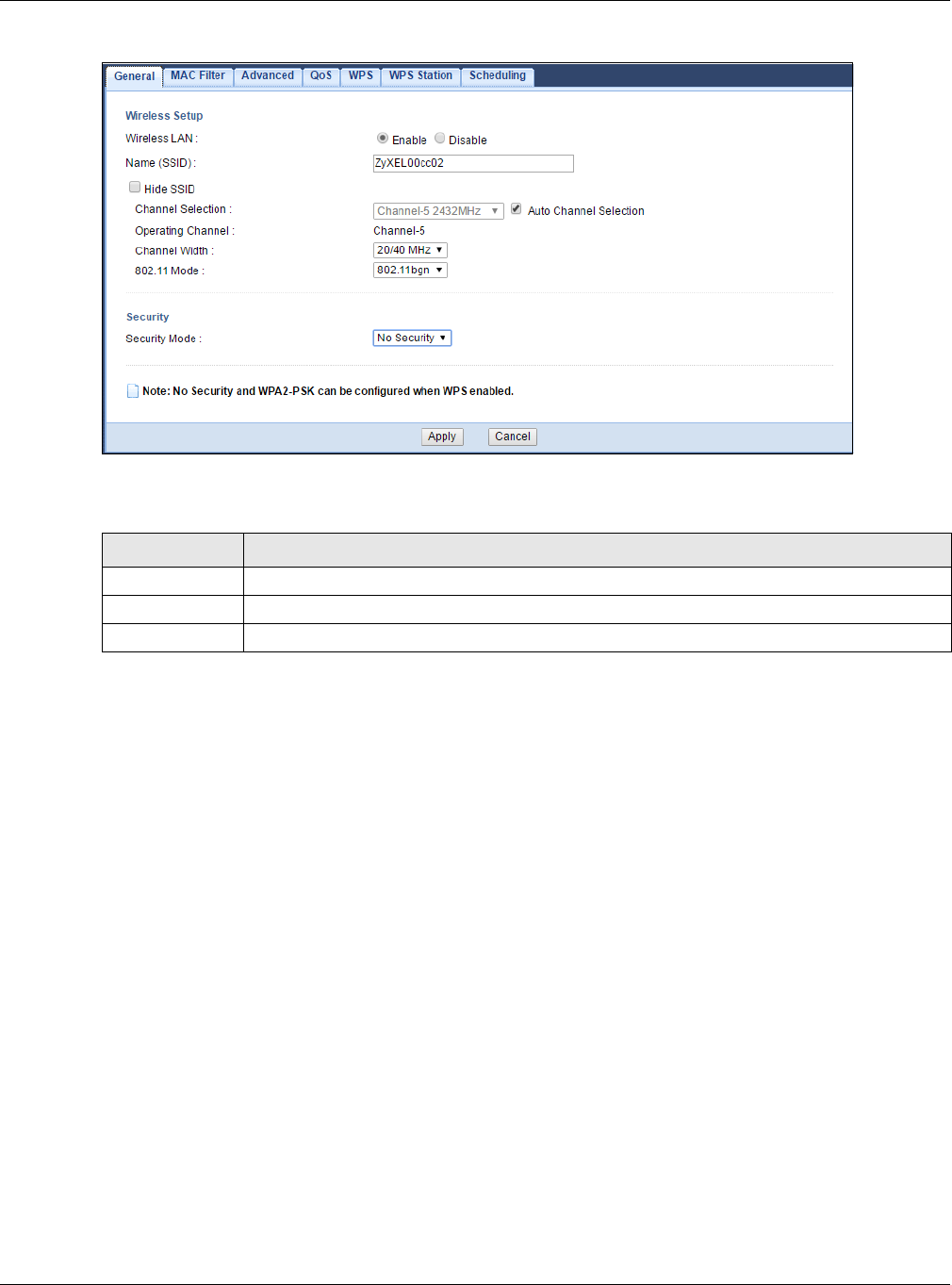
Chapter 7 Wireless LAN
PLA5236 User’s Guide
38
Figure 20 Network > Wireless LAN 2.4G or 5G > Security: No Security
The following table describes the labels in this screen.
7.5.2 WEP Encryption
WEP encryption scrambles the data transmitted between the wireless stations and the access points to
keep network communications private. It encrypts unicast and multicast communications in a network.
Both the wireless stations and the access points must use the same WEP key.
Your PLA allows you to configure up to four 64-bit or 128-bit WEP keys but only one key can be enabled
at any one time.
Select Static WEP from the Security Mode list.
Table 14 Network > Wireless LAN 2.4G or 5G > Security: No Security
LABEL DESCRIPTION
Security Mode Choose No Security from the drop-down list box.
Apply Click Apply to save your changes back to the PLA.
Cancel Click Cancel to reload the previous configuration for this screen.
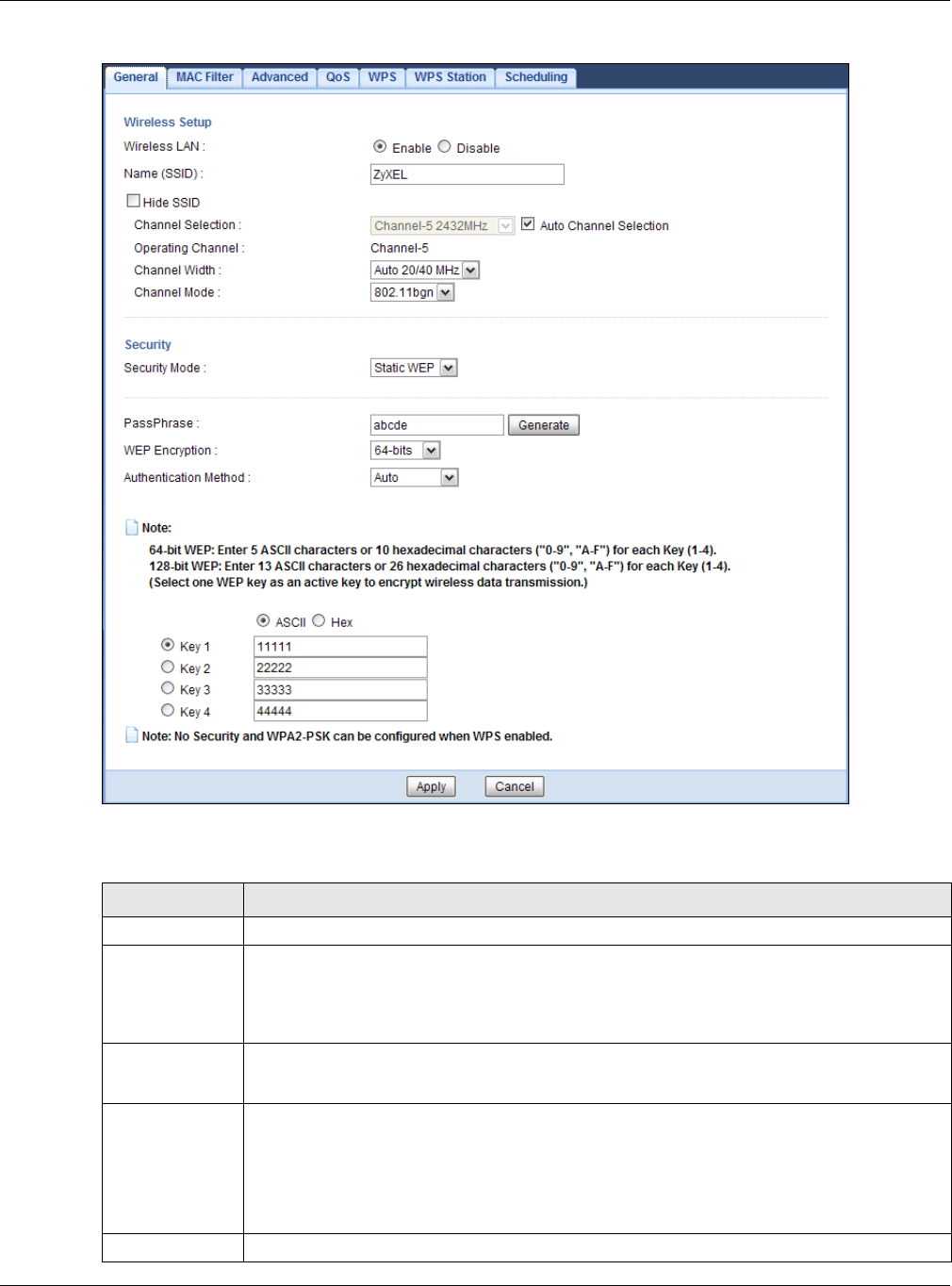
Chapter 7 Wireless LAN
PLA5236 User’s Guide
39
Figure 21 Network > Wireless LAN 2.4G or 5G > Security: Static WEP
The following table describes the wireless LAN security labels in this screen.
Table 15 Network > Wireless LAN 2.4G or 5G > Security: Static WEP
LABEL DESCRIPTION
Security Mode Select Static WEP to enable data encryption.
PassPhrase Enter a passphrase (up to 26 printable characters) and click Generate.
A passphrase functions like a password. In WEP security mode, it is further converted by the PLA
into a complicated string that is referred to as the “key”. This key is requested from all devices
wishing to connect to a wireless network.
WEP Encryption Select 64-bits or 128-bits.
This dictates the length of the security key that the network is going to use.
Authentication
Method
Select Auto or Shared Key from the drop-down list box.
This field specifies whether the wireless clients have to provide the WEP key to login to the
wireless client. Keep this setting at Auto unless you want to force a key verification before
communication between the wireless client and the PLA occurs.
Select Shared Key to force the clients to provide the WEP key prior to communication.
ASCII Select this option in order to enter ASCII characters as WEP key.
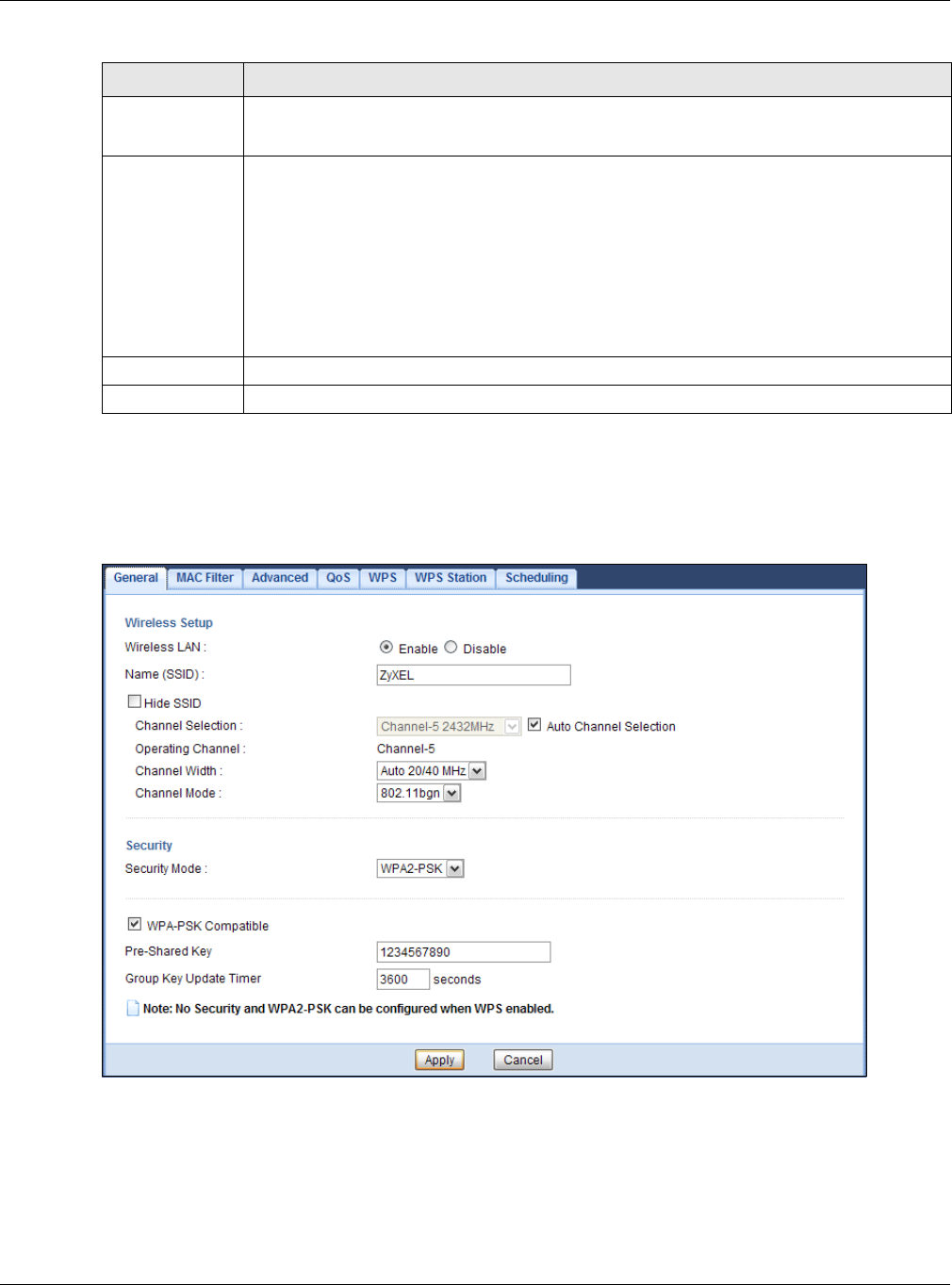
Chapter 7 Wireless LAN
PLA5236 User’s Guide
40
7.5.3 WPA-PSK/WPA2-PSK
Select WPA-PSK or WPA2-PSK from the Security Mode list.
Figure 22 Network > Wireless LAN 2.4G or 5G > Security: WPA2-PSK
Hex Select this option in order to enter hexadecimal characters as a WEP key.
The preceding "0x", that identifies a hexadecimal key, is entered automatically.
Key 1 to Key 4 The WEP keys are used to encrypt data. Both the PLA and the wireless stations must use the
same WEP key for data transmission.
If you chose 64-bit WEP, then enter any 5 ASCII characters or 10 hexadecimal characters ("0-9",
"A-F").
If you chose 128-bit WEP, then enter 13 ASCII characters or 26 hexadecimal characters ("0-9",
"A-F").
You must configure at least one key, only one key can be activated at any one time. The
default key is key 1.
Apply Click Apply to save your changes back to the PLA.
Cancel Click Cancel to reload the previous configuration for this screen.
Table 15 Network > Wireless LAN 2.4G or 5G > Security: Static WEP
LABEL DESCRIPTION

Chapter 7 Wireless LAN
PLA5236 User’s Guide
41
The following table describes the labels in this screen.
7.6 MAC Filter
The MAC filter screen allows you to configure the PLA to give exclusive access to devices (Allow) or
exclude devices from accessing the PLA (Deny). Every Ethernet device has a unique MAC (Media
Access Control) address. The MAC address is assigned at the factory and consists of six pairs of
hexadecimal characters, for example, 00:A0:C5:00:00:02. You need to know the MAC address of the
devices to configure this screen.
To change your PLA’s MAC filter settings, click Network > Wireless LAN 2.4G or 5G > MAC Filter. The
screen appears as shown.
Table 16 Network > Wireless LAN 2.4G or 5G > Security: WPA-PSK/WPA2-PSK
LABEL DESCRIPTION
Security Mode Select WPA-PSK or WPA2-PSK to enable data encryption.
WPA-PSK
Compatible This field appears when you choose WPA2-PSK as the Security Mode.
Check this field to allow wireless devices using WPA-PSK security mode to connect to your
PLA.
Pre-Shared Key WPA-PSK/WPA2-PSK uses a simple common password for authentication.
Type a pre-shared key from 8 to 63 case-sensitive keyboard characters.
Group Key Update
Timer
The Group Key Update Timer is the rate at which the AP sends a new group key out to all
clients.
The default is 3600 seconds (60 minutes).
Apply Click Apply to save your changes back to the PLA.
Cancel Click Cancel to reload the previous configuration for this screen.
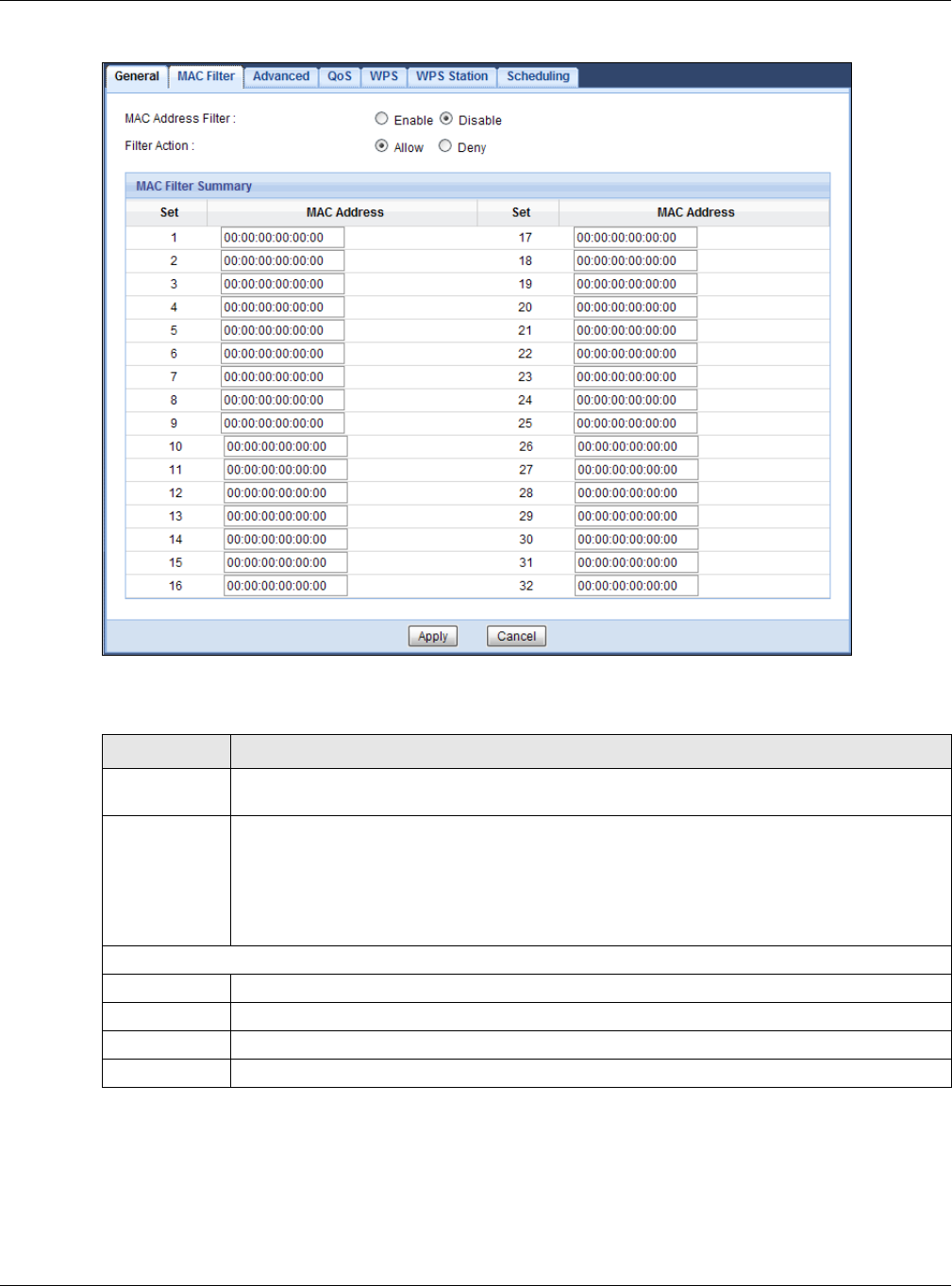
Chapter 7 Wireless LAN
PLA5236 User’s Guide
42
Figure 23 Network > Wireless LAN 2.4G or 5G > MAC Filter
The following table describes the labels in this menu.
7.7 Wireless LAN Advanced Screen
Use this screen to allow wireless advanced features, such as the output power, and RTS/CTS Threshold.
Table 17 Network > Wireless LAN 2.4G or 5G> MAC Filter
LABEL DESCRIPTION
MAC Address
Filter
Select to turn on (Enable) or off (Disable) MAC address filtering.
Filter Action Define the filter action for the list of MAC addresses in the MAC Filter Summary table.
Select Allow to permit access to the PLA, MAC addresses not listed will be denied access to the
PLA.
Select Deny to block access to the PLA, MAC addresses not listed will be allowed to access the
PLA.
MAC Filter Summary
Set This is the index number of the MAC address.
MAC Address Enter the MAC address of the wireless station that are allowed or denied access to the PLA.
Apply Click Apply to save your changes back to the PLA.
Cancel Click Cancel to reload the previous configuration for this screen.
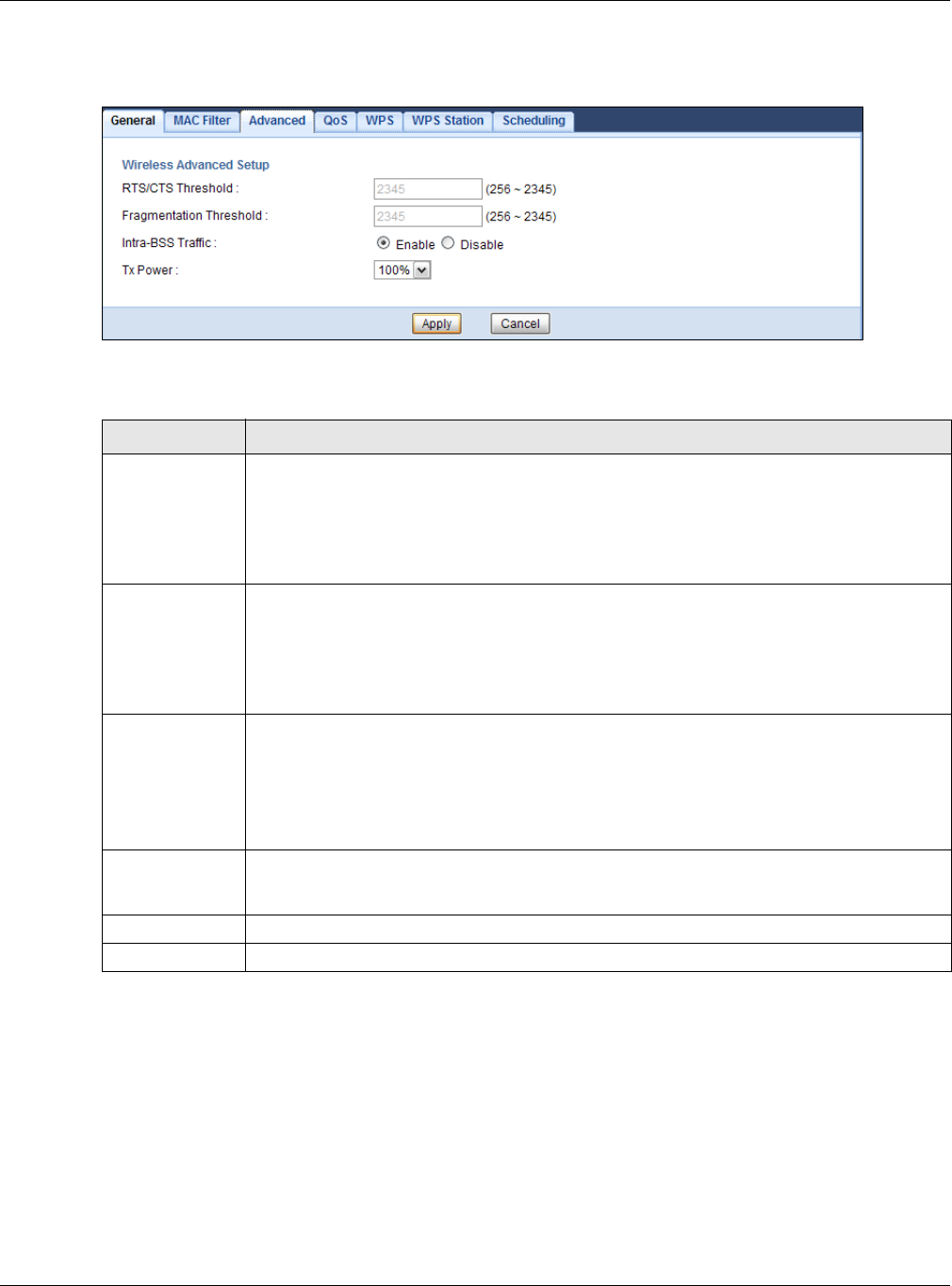
Chapter 7 Wireless LAN
PLA5236 User’s Guide
43
Click Network > Wireless LAN 2.4G or 5G > Advanced. The screen appears as shown.
Figure 24 Network > Wireless LAN 2.4G or 5G > Advanced
The following table describes the labels in this screen.
7.8 Quality of Service (QoS) Screen
The QoS screen allows you to automatically give a service (such as VoIP and video) a priority level.
Click Network > Wireless LAN 2.4G or 5G > QoS. The following screen appears.
Table 18 Network > Wireless LAN 2.4G or 5G > Advanced
LABEL DESCRIPTION
RTS/CTS Threshold Data with its frame size larger than this value will perform the RTS (Request To Send)/CTS (Clear
To Send) handshake.
Note: If you select 802.11n, 802.11gn or 802.11bgn in the Wireless LAN 2.4G or 5G>
General screen, this field is not configurable and the PLA automatically
changes to use the maximum value.
Fragmentation
Threshold
The threshold (number of bytes) for the fragmentation boundary for directed messages. It is the
maximum data fragment size that can be sent.
Note: If you select 802.11n, 802.11gn or 802.11bgn in the Wireless LAN 2.4G or 5G>
General screen, this field is not configurable and the PLA automatically
changes to use the maximum value.
Intra-BSS Traffic A Basic Service Set (BSS) exists when all communications between wireless clients or between a
wireless client and a wired network client go through one access point (AP).
Intra-BSS traffic is traffic between wireless clients in the BSS. When Intra-BSS traffic is enabled,
wireless clients can access the wired network and communicate with each other. When Intra-
BSS traffic is disabled, wireless clients can still access the wired network but cannot
communicate with each other.
Tx Power Set the output power of the PLA in this field. If there is a high density of APs in an area, decrease
the output power of the PLA to reduce interference with other APs. Select one of the following
100%, 90%, 75%, 50%, 25% or 10%.
Apply Click Apply to save your changes back to the PLA.
Cancel Click Cancel to reload the previous configuration for this screen.
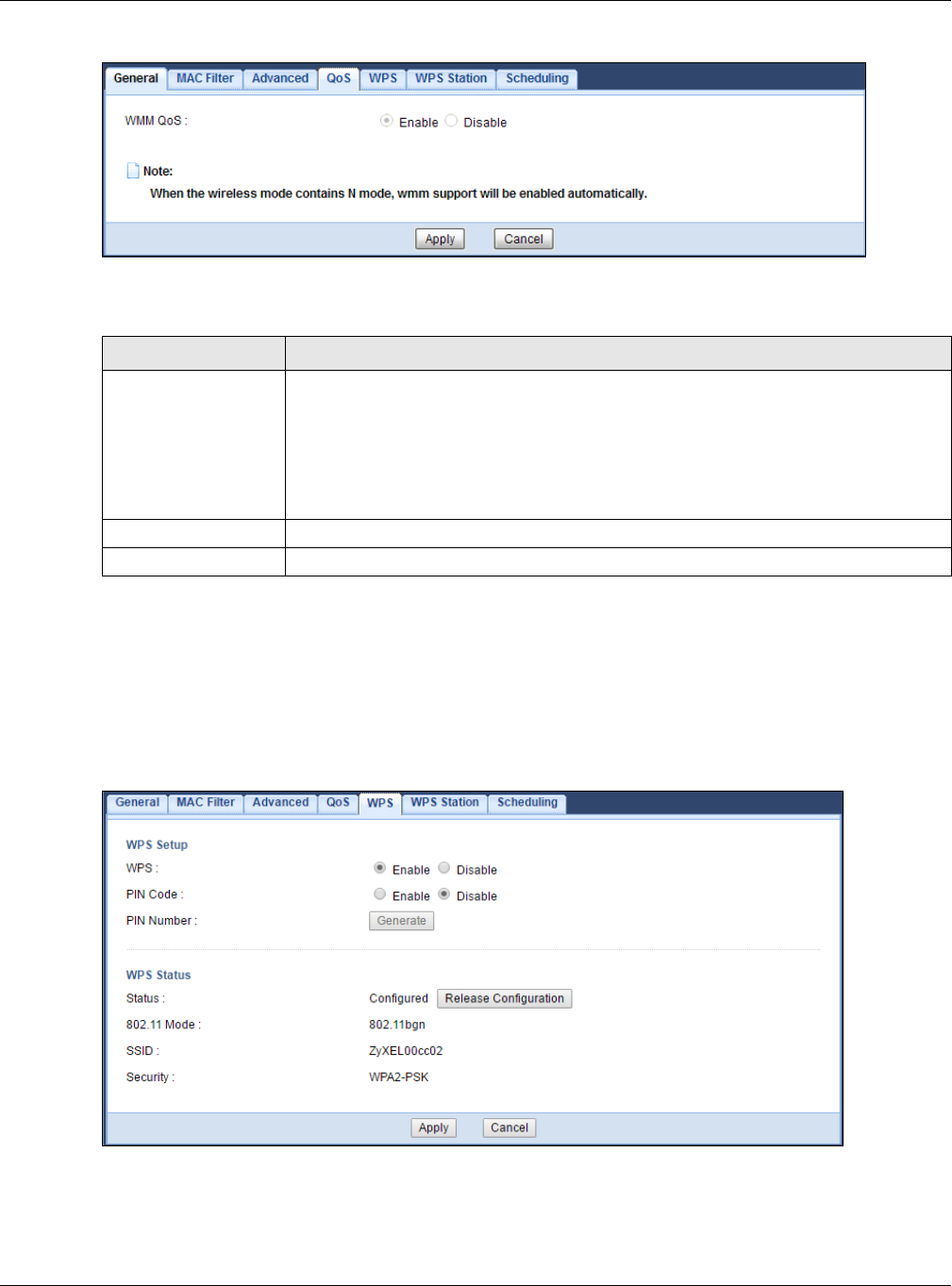
Chapter 7 Wireless LAN
PLA5236 User’s Guide
44
Figure 25 Network > Wireless LAN 2.4G or 5G > QoS
The following table describes the labels in this screen.
7.9 WPS Screen
Use this screen to enable/disable WPS, view or generate a new PIN number and check current WPS
status. To open this screen, click Network > Wireless LAN 2.4G or 5G > WPS tab.
Figure 26 Network > Wireless LAN 2.4G or 5G > WPS
Table 19 Network > Wireless LAN 2.4G or 5G > QoS
LABEL DESCRIPTION
WMM QoS Select Enable to have the PLA automatically give a service a priority level according to
the ToS value in the IP header of packets it sends. WMM QoS (Wifi MultiMedia Quality of
Service) gives high priority to voice and video, which makes them run more smoothly.
Note: If you select 802.11n, 802.11gn or 802.11bgn in the Wireless LAN 2.4G or
5G> General screen, this field is not configurable and the PLA
automatically enables WMM QoS.
Apply Click Apply to save your changes to the PLA.
Cancel Click Cancel to reload the previous configuration for this screen.

Chapter 7 Wireless LAN
PLA5236 User’s Guide
45
The following table describes the labels in this screen.
7.10 WPS Station Screen
Use this screen when you want to add a wireless station using WPS. To open this screen, click Network >
Wireless LAN 2.4G or 5G > WPS Station tab.
Figure 27 Network > Wireless LAN 2.4G or 5G > WPS Station
Table 20 Network > Wireless LAN 2.4G or 5G > WPS
LABEL DESCRIPTION
WPS Setup
WPS Select Enable to turn on the WPS feature. Otherwise, select Disable.
PIN Code Select Enable and click Apply to allow the PIN Configuration method. If you select Disable,
you cannot create a new PIN number.
PIN Number This is the WPS PIN (Personal Identification Number) of the PLA.
The PIN is not necessary when you use WPS push-button method.
Click Generate to generate a new PIN number.
WPS Status
Status This displays Configured when the PLA has connected to a wireless network using WPS or when
Enable WPS is selected and wireless or wireless security settings have been changed. The
current wireless and wireless security settings also appear in the screen.
This displays Unconfigured if WPS is disabled and there are no wireless or wireless security
changes on the PLA or you click Release_Configuration to remove the configured wireless
and wireless security settings.
Release
Configuration
This button is only available when the WPS status displays Configured.
Click this button to remove all configured wireless and wireless security settings for WPS
connections on the PLA.
802.11 Mode This is the 802.11 mode used. Only compliant WLAN devices can associate with the PLA.
SSID This is the name of the wireless network (the PLA’s first SSID).
Security This is the type of wireless security employed by the network.
Apply Click Apply to save your changes back to the PLA.
Cancel Click Cancel to reload the previous configuration for this screen.
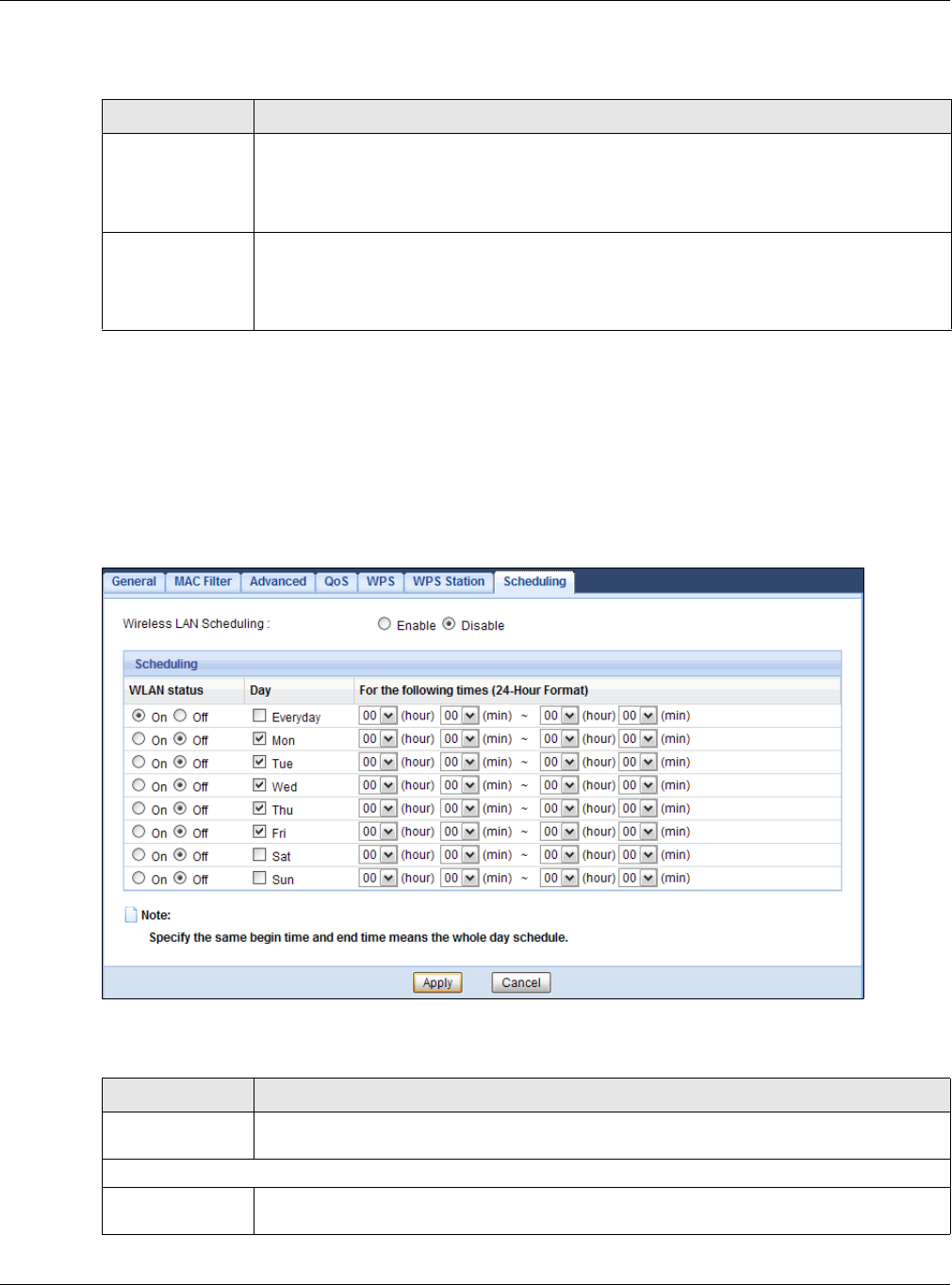
Chapter 7 Wireless LAN
PLA5236 User’s Guide
46
The following table describes the labels in this screen.
7.11 Scheduling Screen
Use this screen to set the times your wireless LAN is turned on and off. Wireless LAN scheduling is disabled
by default. The wireless LAN can be scheduled to turn on or off on certain days and at certain times. To
open this screen, click Network > Wireless LAN 2.4G or 5G > Scheduling tab.
Figure 28 Network > Wireless LAN 2.4G or 5G > Scheduling
The following table describes the labels in this screen.
Table 21 Network > Wireless LAN 2.4G or 5G > WPS Station
LABEL DESCRIPTION
Push Button Use this button when you use the PBC (Push Button Configuration) method to configure
wireless station’s wireless settings.
Click this to start WPS-aware wireless station scanning and the wireless security information
synchronization.
Or input station’s
PIN number
Use this button when you use the PIN Configuration method to configure wireless station’s
wireless settings.
Type the same PIN number generated in the wireless station’s utility. Then click Start to
associate to each other and perform the wireless security information synchronization.
Table 22 Network > Wireless LAN 2.4G or 5G > Scheduling
LABEL DESCRIPTION
Wireless LAN
Scheduling
Select Enable to activate the wireless LAN scheduling feature. Select Disable to turn it off.
Scheduling
WLAN Status Select On or Off to specify whether the Wireless LAN is turned on or off. This field works in
conjunction with the Day and For the following times fields.

Chapter 7 Wireless LAN
PLA5236 User’s Guide
47
Day Select Everyday or the specific days to turn the Wireless LAN on or off. If you select Everyday
you can not select any specific days. This field works in conjunction with the For the following
times field.
For the following
times (24-Hour
Format)
Select a begin time using the first set of hour and minute (min) drop down boxes and select an
end time using the second set of hour and minute (min) drop down boxes. If you have chosen
On earlier for the WLAN Status the Wireless LAN will turn on between the two times you enter in
these fields. If you have chosen Off earlier for the WLAN Status the Wireless LAN will turn off
between the two times you enter in these fields.
Apply Click Apply to save your changes back to the PLA.
Cancel Click Cancel to reload the previous configuration for this screen.
Table 22 Network > Wireless LAN 2.4G or 5G > Scheduling
LABEL DESCRIPTION
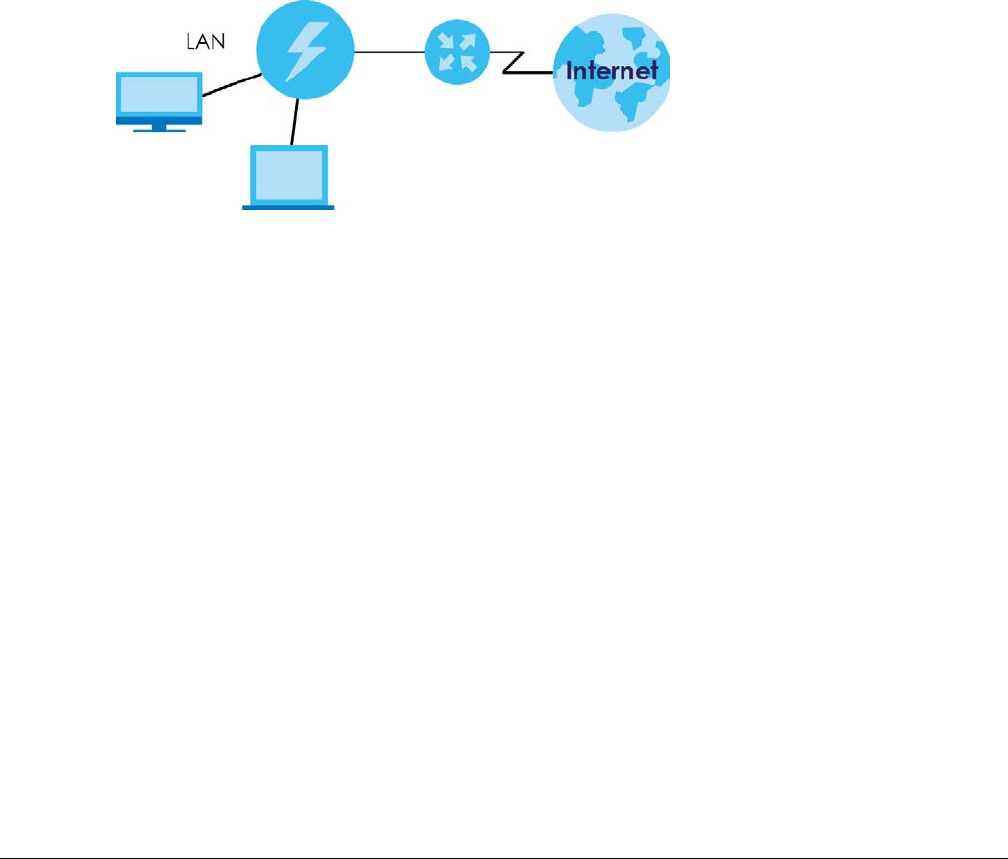
PLA5236 User’s Guide
48
CHAPTER 8
LAN
8.1 Overview
This chapter describes how to configure LAN settings.
A Local Area Network (LAN) is a shared communication system to which many computers are
attached. A LAN is a computer network limited to the immediate area, usually the same building or floor
of a building. The LAN screens can help you configure the manage IP address, and partition your
physical network into logical networks.
Figure 29 LAN Example
The LAN screens can help you manage IP addresses.
8.2 What You Can Do
• Use the IP screen (Section 8.4 on page 49) to change the IP address for your PLA and DNS server
information.
• Use the IP Alias screen (Section 8.5 on page 50) to have the PLA apply IP alias to create LAN subnets.
8.3 What You Need To Know
There are two separate IP networks, one inside the LAN network and the other outside the WAN network
as shown next.
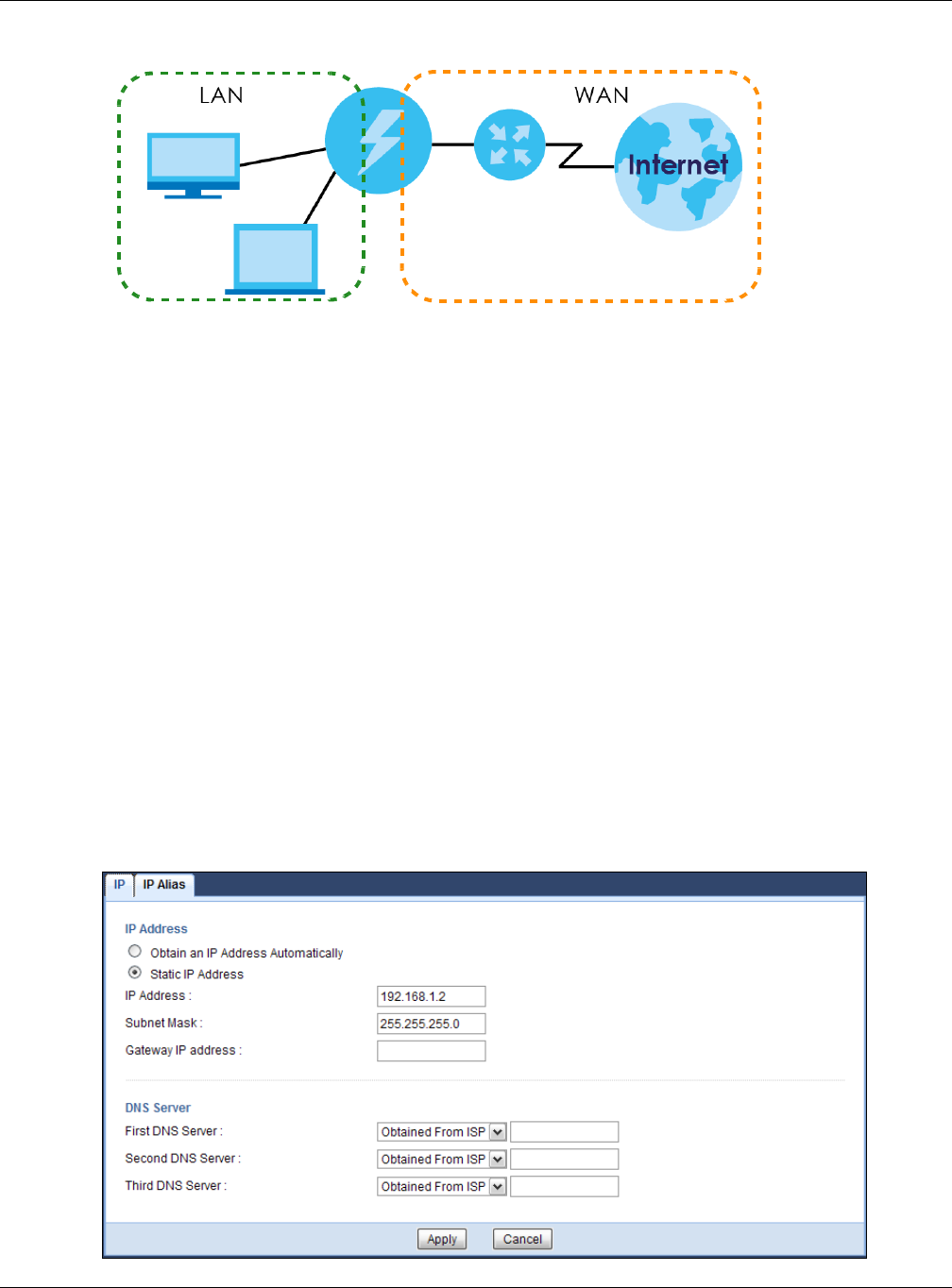
Chapter 8 LAN
PLA5236 User’s Guide
49
Figure 30 LAN and WAN IP Addresses
The LAN parameters of the PLA are preset in the factory with the following values:
• IP address of 192.168.1.2 with subnet mask of 255.255.255.0 (24 bits)
8.3.1 LAN TCP/IP
The PLA has built-in DHCP server capability that assigns IP addresses and DNS servers to systems that
support DHCP client capability.
8.3.2 IP Alias
IP alias allows you to partition a physical network into different logical networks over the same Ethernet
interface. The PLA supports three logical LAN interfaces via its single physical Ethernet interface with the
PLA itself as the gateway for each LAN network.
8.4 LAN IP Screen
Use this screen to change the IP address for your PLA. Click Network > LAN > IP.
Figure 31 Network > LAN > IP (Access Point or Universal Repeater)

Chapter 8 LAN
PLA5236 User’s Guide
50
The following table describes the labels in this screen.
8.5 IP Alias Screen
Use this screen to have the PLA apply IP alias to create LAN subnets. Click LAN > IP Alias.
Figure 32 Network > LAN > IP Alias
Table 23 Network > LAN > IP
LABEL DESCRIPTION
Obtain an IP
Address
Automatically
Click this to deploy the PLA as a DHCP client in the network.
When you enable this, the PLA gets its IP address from the network’s DHCP server (for
example, your ISP or router). Users connected to the PLA can now access the network (i.e.,
the Internet if the IP address is given by the ISP or a router with Internet access).
The Web Configurator may no longer be accessible unless you know the IP address assigned
by the DHCP server to the PLA. Otherwise, you need to reset the PLA to be able to access
the Web Configurator again (see Section 11.7 on page 61 for details on how to reset the
PLA).
Also when you select this, you cannot enter an IP address for your PLA in the field below.
Static IP Address Click this if you want to specify the IP address of your PLA. Or if your ISP or network
administrator gave you a static IP address to access the network or the Internet.
IP Address Type the IP address in dotted decimal notation. The default setting is 192.168.1.2. If you
change the IP address you will have to log in again with the new IP address.
Subnet Mask The subnet mask specifies the network number portion of an IP address.
Gateway IP Address Enter a gateway IP address (if your ISP or network administrator gave you one) in this field.
DNS Server
First DNS Server
Second DNS Server
Select Obtained From ISP if your ISP or router to which the PLA connects dynamically assigns
DNS server information (and the PLA's WAN IP address). The field to the right displays the
(read-only) DNS server IP address that the ISP assigns.
Select User-Defined if you have the IP address of a DNS server. Enter the DNS server's IP
address in the field to the right.
Select None if you do not want to configure DNS servers. If you do not configure a DNS
server, you must know the IP address of a computer in order to access it.
Apply Click Apply to save your changes back to the PLA.
Cancel Click Cancel to reload the previous configuration for this screen.

Chapter 8 LAN
PLA5236 User’s Guide
51
The following table describes the labels in this screen.
Table 24 Network > LAN > IP Alias
LABEL DESCRIPTION
IP Alias Check this to enable IP alias.
IP Address Type the IP alias address of your PLA in dotted decimal notation.
IP Subnet Mask The subnet mask specifies the network number portion of an IP address.
Apply Click Apply to save your changes back to the PLA.
Cancel Click Cancel to reload the previous configuration for this screen.
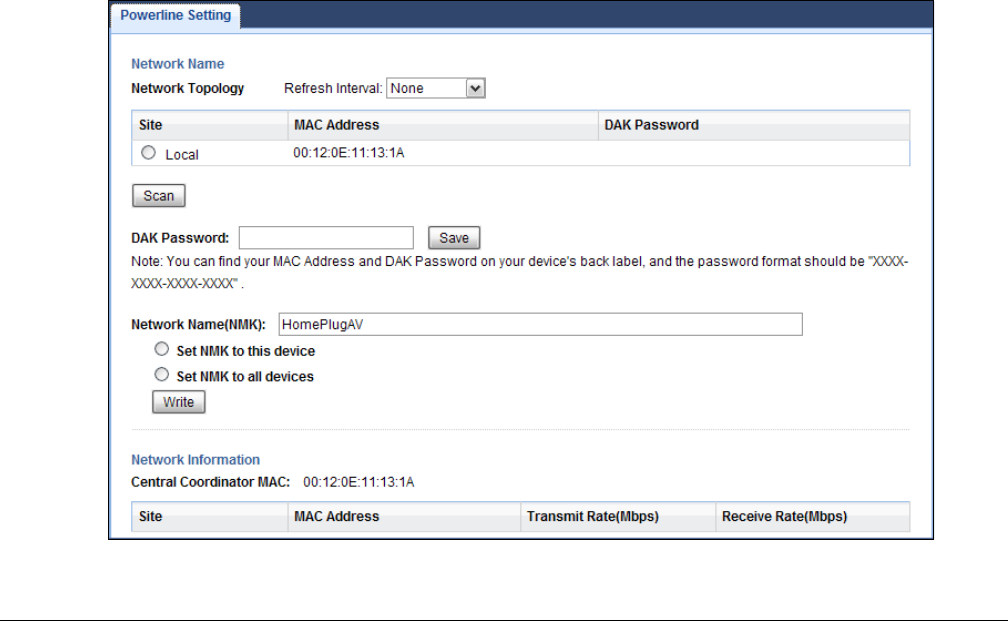
PLA5236 User’s Guide
52
CHAPTER 9
Home Plug
9.1 Overview
This chapter describes how to configure powerline settings. See Chapter 4 on page 23 for more
information about powerline network security.
9.2 What You Can Do
Use the HomePlug screen (Section 9.3 on page 52) to secure, manage and set up Quality of Service
(QoS) on your powerline network.
9.3 HomePlug Screen
Use this screen to change the powerline settings for your PLA. Click Network > HomePlug.
Figure 33 Network > HomePlug

Chapter 9 Home Plug
PLA5236 User’s Guide
53
The following table describes the labels in this screen.
Table 25 Configuration Screen
LABEL DESCRIPTION
Network
Refresh Interval Select a number of seconds or None from the drop-down list box to update the powerline
network information automatically at the end of every time interval or to not refresh the
powerline network information.
The fields described below are used to identify the powerline adapters recognized on the powerline network. Click
Scan to refresh the information in these fields (immediately).
Note: Only devices which share the same network name are displayed in this table.
Site This field displays
•Local, if it is identifying the powerline adapter directly connected to the computer running
the Web Configurator.
•Remote, if it is a powerline adapter in your powerline network but not directly connected to
the computer running the Web Configurator.
MAC Address This is a read-only field which shows the MAC address of the powerline adapter you are
configuring. You can find the MAC address of your PLA displayed on a sticker on the bottom of
your device.
DAK Password DAK (Device Access Key) password is used to verify that you are authorized to perform changes
on a remote device. You can find the DAK password printed on a sticker on the bottom of your
PLA.
Select the remote powerline adapter you want to manage by clicking the MAC address which
corresponds to it in the MAC Address column. Enter the DAK Password value and click Save.
Note: You must enter the DAK Password value exactly as it is printed on the label (all
caps and with dashes “-”).
Network Name
(NMK)
The default network name (sometimes called a network password or network membership key
(NMK)) of the PLA is “HomePlugAV”. HomePlug compatible devices use the same network
name to recognize and communicate with each other over the powerline network. If you
change the network name of one device on the network, it will no longer be recognized as part
of that network.
If you change the network name, make sure you change the network name for all of the
powerline adapters that you want to be part of your powerline network.
The network name can be from 8 to 64 characters in length, using “A”~”Z”, “a”~”z”, “0”~”9”;
spaces are not allowed.
Set NMK to this
device
Select this to apply the NMK (entered in the field above) as the network name for the powerline
adapter directly connected to the computer running the Web Configurator.
Set NMK to all
devices
Select this to apply the NMK (entered in the field above) as the network name for all powerline
adapter detected by the Web Configurator.
Write Click this to apply your changes. The new Network Name is applied to the selected powerline
adapter.
Note: You must enter the correct DAK password for the selected powerline adapter
before you can make changes to it.
Network
Information
Central
Coordinator
MAC
The Central Coordinator of the powerline network is the powerline adapter which keeps track
of which devices are part of the network as well as synchronizes communication within the
powerline network. If the Central Coordinator is removed from the powerline network then
another powerline adapter takes its place. This field displays the MAC address of the PLA which
is the Central Coordinator of the powerline network. The powerline adapters in your powerline
network automatically select the Central Coordinator.

Chapter 9 Home Plug
PLA5236 User’s Guide
54
The information provided in the following table reflects transmission rate information about the powerline adapters
which communicate in your powerline network.
The powerline adapters listed in this table are all the powerline adapters in your powerline network except the
powerline adapter selected in the table of the Network Name section. In other words, if the Local powerline
adapter is selected in the table of the Network Name section, then this table will display the rates of transmission
from the powerline adapter connected to the computer running the Web Configurator to all the Remote powerline
adapters.
Site This field displays:
•Local, if it is the PLA directly connected to the computer running the Web Configurator.
•Remote, if it is a PLA in your powerline network but not directly connected to the computer
running the Web Configurator.
MAC Address This field displays the MAC address of your powerline adapter. The MAC address of your
powerline adapter can be found by looking at the label on your device. It consists of six pairs of
hexadecimal characters (hexadecimal characters are “0-9” and “a-f”). In the case of the PLA,
this label is on the bottom of the device.
Transmit Rate
(Mbps)
This field displays how fast information is sent from the powerline adapter selected in the table of
the Network Name section to this powerline adapter. The rate is given in the following format:
“application data transmission rate / raw data transmission rate”. Application data reflects
more accurately how fast devices are transmitting application relevant traffic (for example
Internet Protocol (IP) traffic). Raw data refers to the whole payload of the packets transmitted
across the powerline network.
Receive Rate
(Mbps)
This field displays how fast information is received from the powerline adapter selected in the
table of the Network Name section to this powerline adapter. The rate is given in the following
format: “application data transmission rate / raw data transmission rate”. Application data
reflects more accurately how fast devices are transmitting application relevant traffic (for
example Internet Protocol (IP) traffic). Raw data refers to the whole payload of the packets
transmitted across the powerline network.
Table 25 Configuration Screen (continued)
LABEL DESCRIPTION
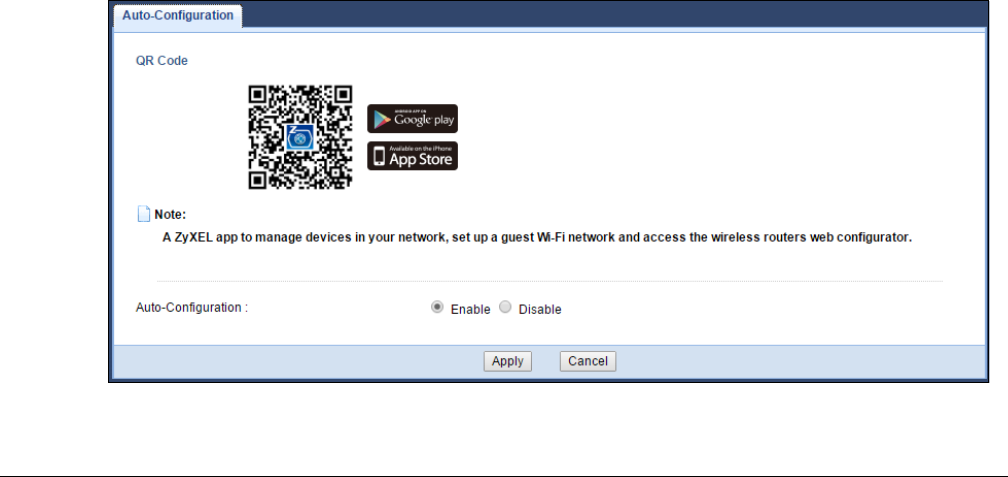
PLA5236 User’s Guide
55
CHAPTER 10
One Connect
10.1 Overview
This chapter describes the One Connect feature. This feature uses an app that allows you to easily
integrate the PLA and other devices to your home network. Through the app you can view a neighbor
device list, along with detailed information, such as each device’s address, firmware version and
description of its physical location previously noted by the administrator. One Connect can be used to
remotely turn the power of a neighboring powered device (PD), on or off from a distance. And most
importantly, you can easily set up notifications, customize and control all the devices in your network
using your smart phone or tablet.
10.2 What You Can Do
Use the One Connect screen (Section 10.3 on page 55) to enable this One Connect feature and access
your PLA through the Zyxel app.
10.3 One Connect Screen
The One Connect screen has a QR code to help you download the app. Use this screen to Enable or
Disable the One Connect feature in your PLA.
Figure 34 Network > One Connect> Auto-Configuration
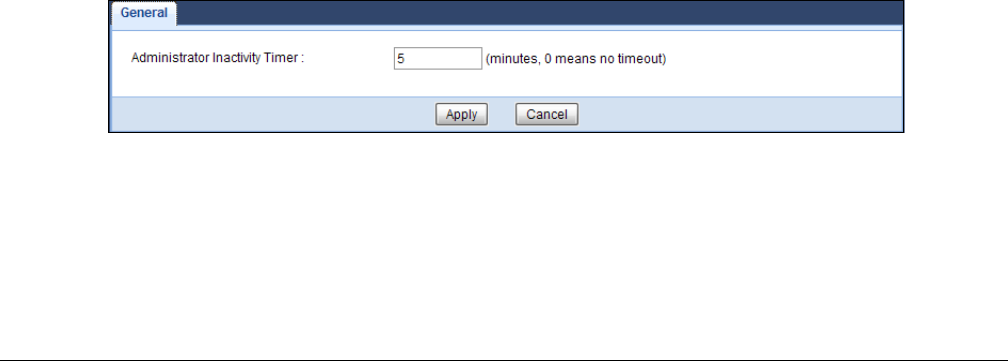
PLA5236 User’s Guide
56
CHAPTER 11
Maintenance
11.1 Overview
This chapter provides information on the Maintenance screens.
11.2 What You Can Do
• Use the General screen (Section 11.3 on page 56) to set the timeout period of the management
session.
• Use the Password screen (Section 11.4 on page 57) to change your PLA’s system password.
• Use the Time screen (Section 11.5 on page 57) to change your PLA’s time and date.
• Use the Firmware Upgrade screen (Section 11.6 on page 59) to upload firmware to your PLA.
• Use the Backup/Restore screen (Section 11.8 on page 62) to view information related to factory
defaults, backup configuration, and restoring configuration.
• Use the Restart screen (Section 11.8 on page 62) to reboot the PLA without turning the power off.
• Use the Language screen (Section 11.9 on page 62) to change the language for the Web
Configurator.
• Use the WiFi Mode screen (Section 11.10 on page 62)to change the Wi-Fi mode on your PLA.
11.3 General Screen
Use this screen to set the management session timeout period. Click Maintenance > General. The
following screen displays.
Figure 35 Maintenance > General
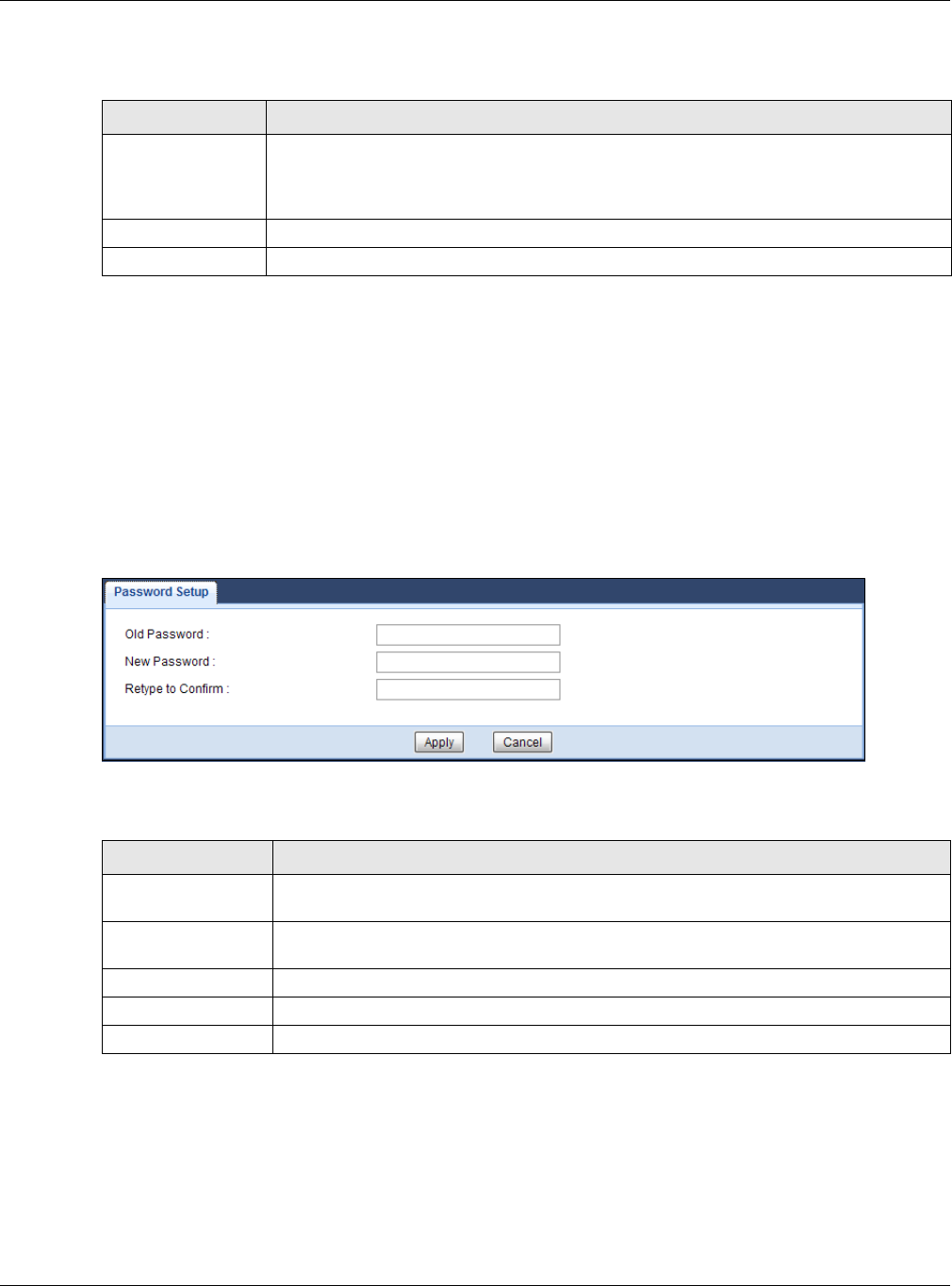
Chapter 11 Maintenance
PLA5236 User’s Guide
57
The following table describes the labels in this screen.
11.4 Password Screen
It is strongly recommended that you change your PLA's password.
If you forget your PLA's password (or IP address), you will need to reset the device. See Section 11.8 on
page 62 for details
Click Maintenance > Password.
Figure 36 Maintenance > Password
The following table describes the labels in this screen.
11.5 Time Setting Screen
Use this screen to configure the PLA’s time based on your local time zone. To change your PLA’s time
and date, click Maintenance > Time. The screen appears as shown.
Table 26 Maintenance > General
LABEL DESCRIPTION
Administrator
Inactivity Timer
Type how many minutes a management session can be left idle before the session times out.
The default is 5 minutes. After it times out you have to log in with your password again. Very
long idle timeouts may have security risks. A value of "0" means a management session
never times out, no matter how long it has been left idle (not recommended).
Apply Click Apply to save your changes back to the PLA.
Cancel Click Cancel to reload the previous configuration for this screen.
Table 27 Maintenance > Password
LABEL DESCRIPTION
Old Password Type the default password or the existing password you use to access the system in this
field.
New Password Type your new system password (up to 30 characters). Note that as you type a password,
the screen displays an asterisk (*) for each character you type.
Retype to Confirm Type the new password again in this field.
Apply Click Apply to save your changes back to the PLA.
Cancel Click Cancel to reload the previous configuration for this screen.
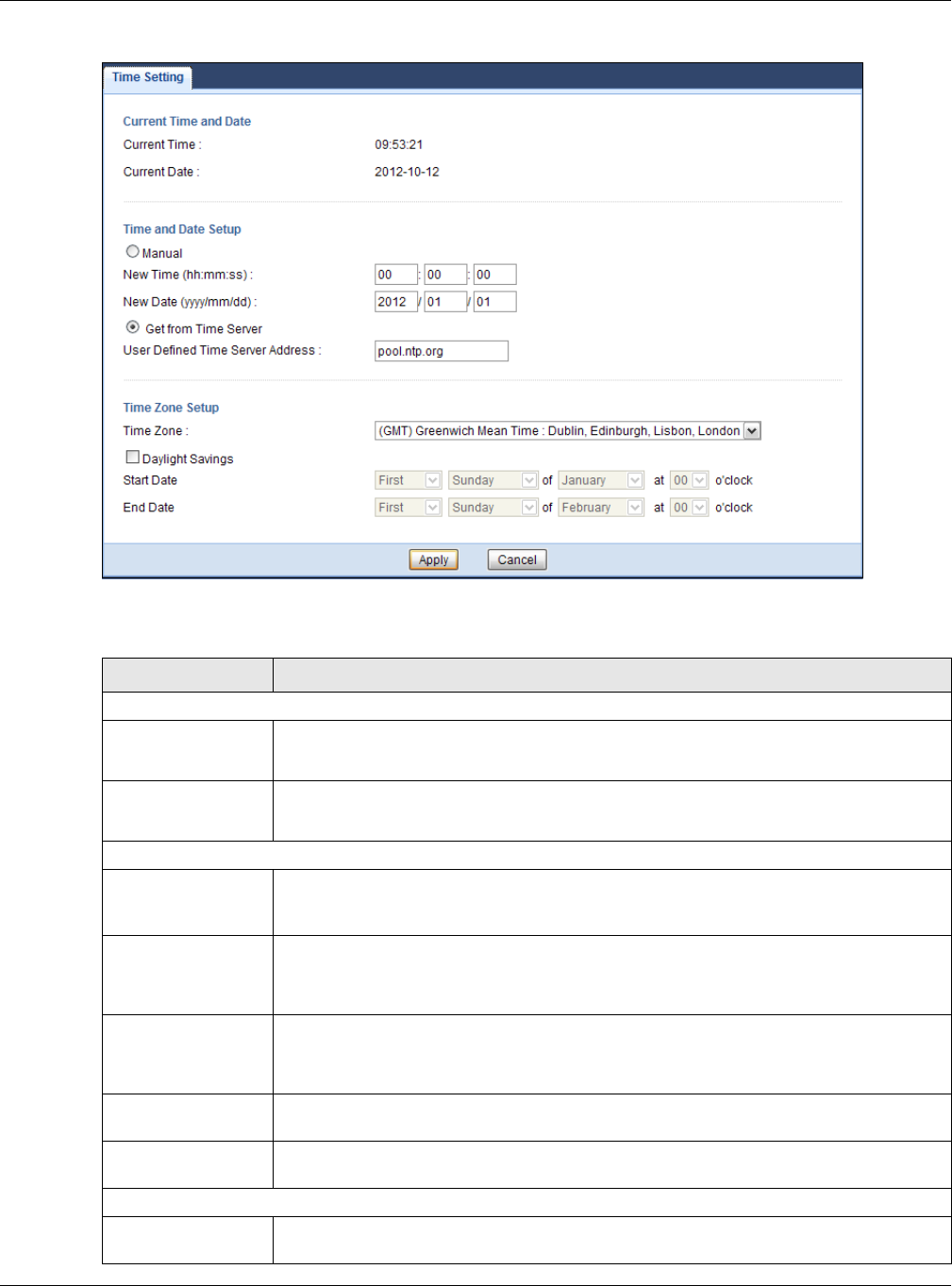
Chapter 11 Maintenance
PLA5236 User’s Guide
58
Figure 37 Maintenance > Time
he following table describes the labels in this screen.
Table 28 Maintenance > Time
LABEL DESCRIPTION
Current Time and Date
Current Time This field displays the time of your PLA.
Each time you reload this page, the PLA synchronizes the time with the time server.
Current Date This field displays the date of your PLA.
Each time you reload this page, the PLA synchronizes the date with the time server.
Time and Date Setup
Manual Select this radio button to enter the time and date manually. If you configure a new time
and date, Time Zone and Daylight Saving at the same time, the new time and date you
entered has priority and the Time Zone and Daylight Saving settings do not affect it.
New Time
(hh:mm:ss)
This field displays the last updated time from the time server or the last time configured
manually.
When you select Manual, enter the new time in this field and then click Apply.
New Date
(yyyy/mm/dd)
This field displays the last updated date from the time server or the last date configured
manually.
When you select Manual, enter the new date in this field and then click Apply.
Get from Time Server Select this radio button to have the PLA get the time and date from the time server you
specified below.
User Defined Time
Server Address
Enter the IP address or URL (up to 20 extended ASCII characters in length) of your time
server. Check with your ISP/network administrator if you are unsure of this information.
Time Zone Setup
Time Zone Choose the time zone of your location. This will set the time difference between your time
zone and Greenwich Mean Time (GMT).

Chapter 11 Maintenance
PLA5236 User’s Guide
59
11.6 Firmware Upgrade Screen
Find firmware at www.zyxel.com in a file that (usually) uses the system model name with a “*.bin”
extension, e.g., “PLA.bin”. The upload process uses HTTP (Hypertext Transfer Protocol) and may take up
to two minutes. After a successful upload, the system will reboot.
Click Maintenance > Firmware Upgrade. Follow the instructions in this screen to upload firmware to your
PLA.
Daylight Savings Daylight saving is a period from late spring to fall when many countries set their clocks
ahead of normal local time by one hour to give more daytime light in the evening.
Select this option if you use Daylight Saving Time.
Start Date Configure the day and time when Daylight Saving Time starts if you selected Daylight
Savings. The o'clock field uses the 24 hour format. Here are a couple of examples:
Daylight Saving Time starts in most parts of the United States on the second Sunday of
March. Each time zone in the United States starts using Daylight Saving Time at 2 A.M. local
time. So in the United States you would select Second, Sunday, March and type 2 in the
o'clock field.
Daylight Saving Time starts in the European Union on the last Sunday of March. All of the
time zones in the European Union start using Daylight Saving Time at the same moment (1
A.M. GMT or UTC). So in the European Union you would select Last, Sunday, March. The time
you type in the o'clock field depends on your time zone. In Germany for instance, you
would type 2 because Germany's time zone is one hour ahead of GMT or UTC (GMT+1).
End Date Configure the day and time when Daylight Saving Time ends if you selected Daylight
Savings. The o'clock field uses the 24 hour format. Here are a couple of examples:
Daylight Saving Time ends in the United States on the first Sunday of November. Each time
zone in the United States stops using Daylight Saving Time at 2 A.M. local time. So in the
United States you would select First, Sunday, November and type 2 in the o'clock field.
Daylight Saving Time ends in the European Union on the last Sunday of October. All of the
time zones in the European Union stop using Daylight Saving Time at the same moment (1
A.M. GMT or UTC). So in the European Union you would select Last, Sunday, October. The
time you type in the o'clock field depends on your time zone. In Germany for instance, you
would type 2 because Germany's time zone is one hour ahead of GMT or UTC (GMT+1).
Apply Click Apply to save your changes back to the PLA.
Cancel Click Cancel to reload the previous configuration for this screen.
Table 28 Maintenance > Time
LABEL DESCRIPTION
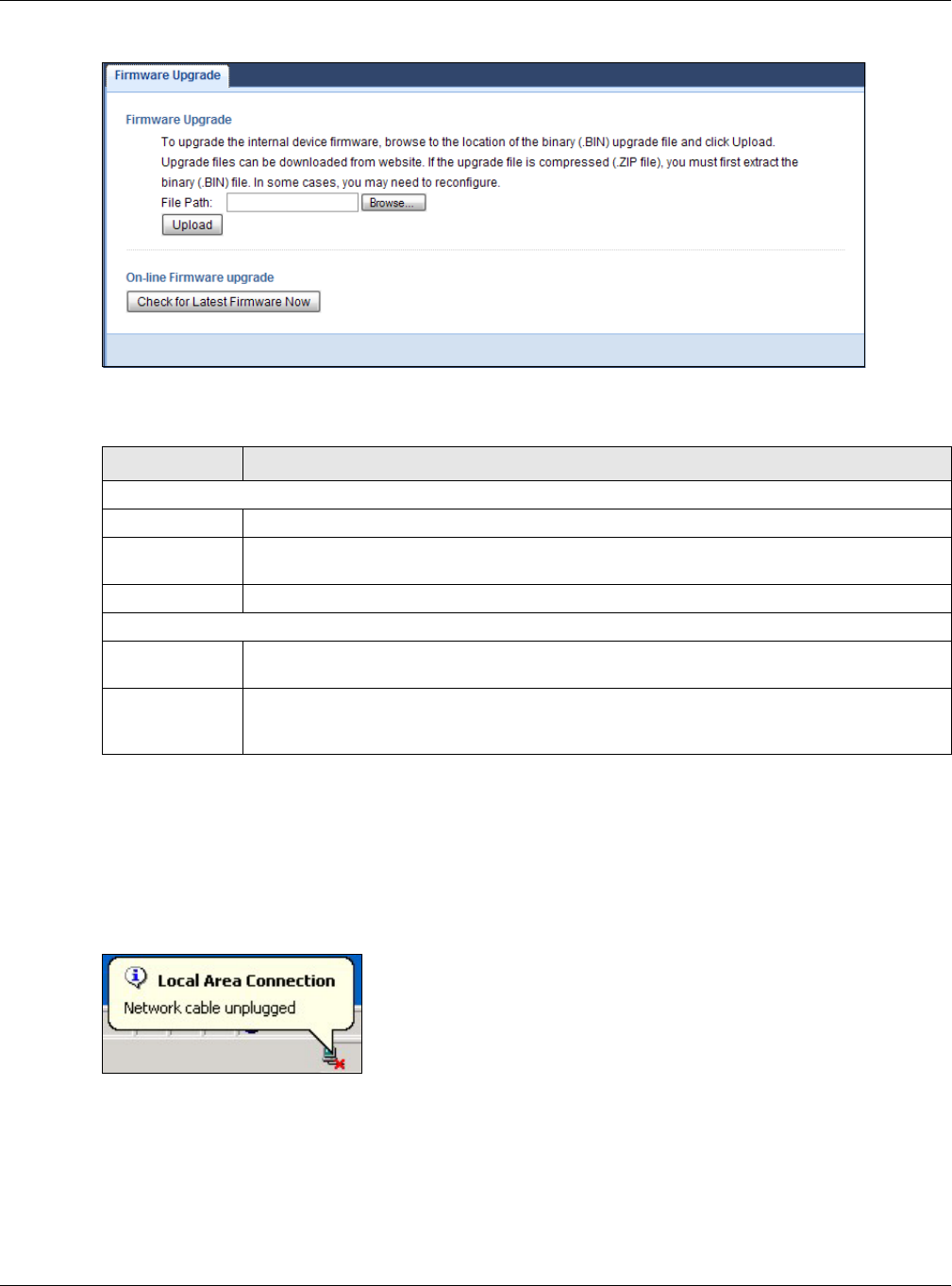
Chapter 11 Maintenance
PLA5236 User’s Guide
60
Figure 38 Maintenance > Firmware Upgrade
The following table describes the labels in this screen.
Note: Do not turn off the PLA while firmware upload is in progress!
After you click Upload, wait two minutes before logging into the PLA again.
The PLA automatically restarts in this time causing a temporary network disconnect. In some operating
systems, you may see the following icon on your desktop.
Figure 39 Network Temporarily Disconnected
After two minutes, log in again and check your new firmware version in the Dashboard screen.
Table 29 Maintenance > Firmware Upgrade
LABEL DESCRIPTION
Firmware Upgrade
File Path Type in the location of the file you want to upload in this field or click Browse... to find it.
Browse... Click Browse... to find the .bin file you want to upload. Remember that you must decompress
compressed (.zip) files before you can upload them.
Upload Click Upload to begin the upload process. This process may take up to two minutes.
On-line Firmware Upgrade
Check for Latest
Firmware Now
Click this button to get the latest firmware information, such as the version number, release
date, release note and file size from the ZyXEL website. Make sure your PLA has Internet access.
Do-
Firmware_Upgra
de
Click this button to download and install the latest firmware in your PLA.
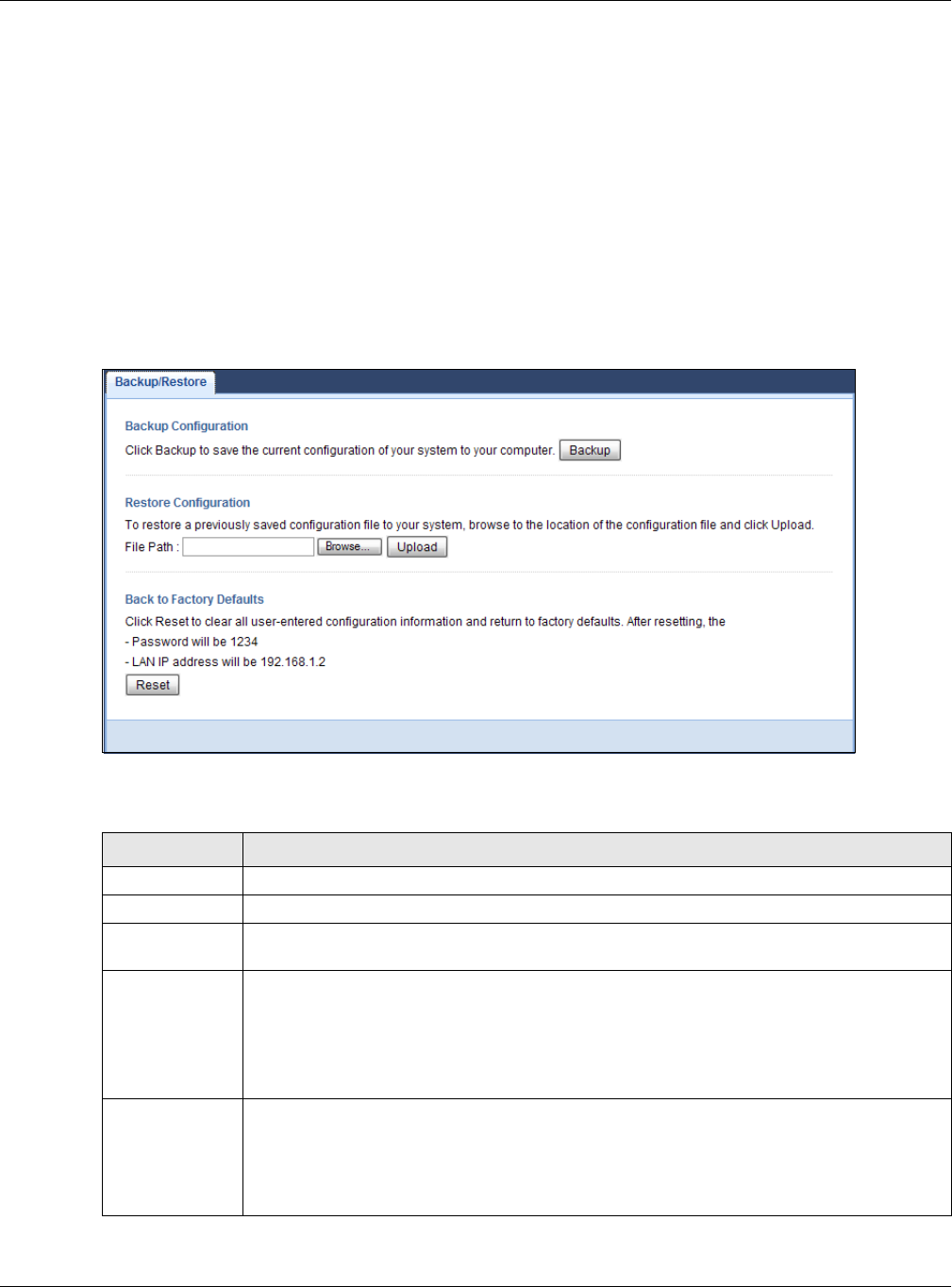
Chapter 11 Maintenance
PLA5236 User’s Guide
61
11.7 Configuration Backup/Restore Screen
Backup configuration allows you to back up (save) the PLA’s current configuration to a file on your
computer. Once your PLA is configured and functioning properly, it is highly recommended that you
back up your configuration file before making configuration changes. The backup configuration file will
be useful in case you need to return to your previous settings.
Restore configuration allows you to upload a new or previously saved configuration file from your
computer to your PLA.
Click Maintenance > Backup/Restore. Information related to factory defaults, backup configuration,
and restoring configuration appears as shown next.
Figure 40 Maintenance > Backup/Restore
The following table describes the labels in this screen.
Table 30 Maintenance > Backup/Restore
LABEL DESCRIPTION
Backup Click Backup to save the PLA’s current configuration to your computer.
File Path Type in the location of the file you want to upload in this field or click Browse... to find it.
Browse... Click Browse... to find the file you want to upload. Remember that you must decompress
compressed (.ZIP) files before you can upload them.
Upload Click Upload to begin the upload process.
Note: Do not turn off the PLA while configuration file upload is in progress.
After you click Upload, you must then wait one minute before logging into the PLA again. The
PLA automatically restarts in this time causing a temporary network disconnect.
Reset Pressing the Reset button in this section clears all user-entered configuration information and
returns the PLA to its factory defaults.
You can also press the RESET button on the rear panel to reset the factory defaults of your PLA.
Refer to the chapter about introducing the Web Configurator for more information on the RESET
button.
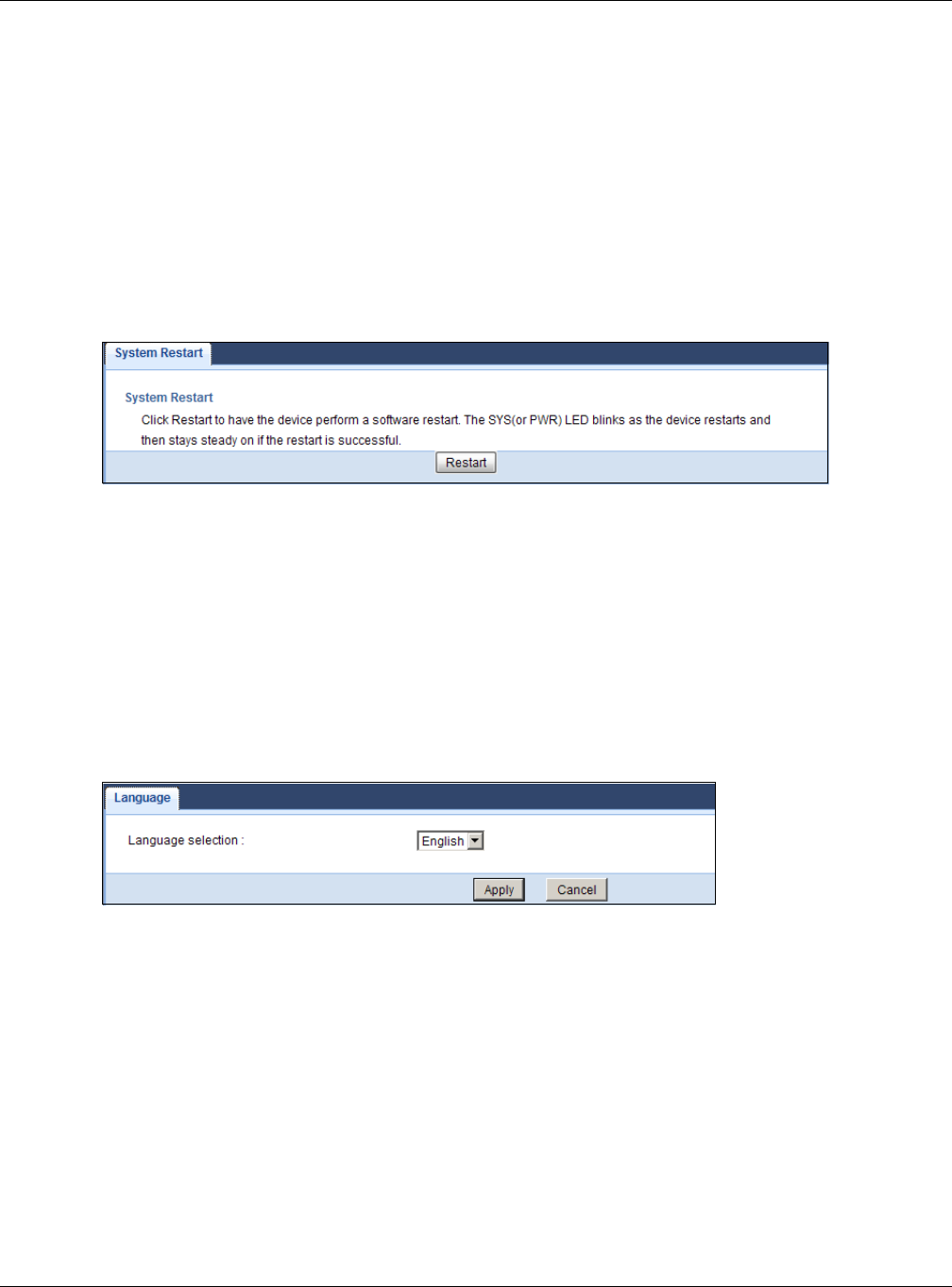
Chapter 11 Maintenance
PLA5236 User’s Guide
62
Note: If you uploaded the default configuration file you may need to change the IP address
of your computer to be in the same subnet as that of the default PLA IP address
(192.168.1.2).
11.8 Restart Screen
System restart allows you to reboot the PLA without turning the power off.
Click Maintenance > Restart to open the following screen.
Figure 41 Maintenance > Restart
Click Restart to have the PLA reboot. This does not affect the PLA's configuration.
11.9 Language Screen
Use this screen to change the language for the Web Configurator.
Select the language you prefer and click Apply. The Web Configurator language changes after a while
without restarting the PLA.
Figure 42 Maintenance > Language
11.10 Wi-Fi Mode Screen
The PLA offers three different Wi-Fi modes: Range Mode, Performance Mode and Mixed Mode. Use this
screen to change the Wi-Fi Mode on your PLA.
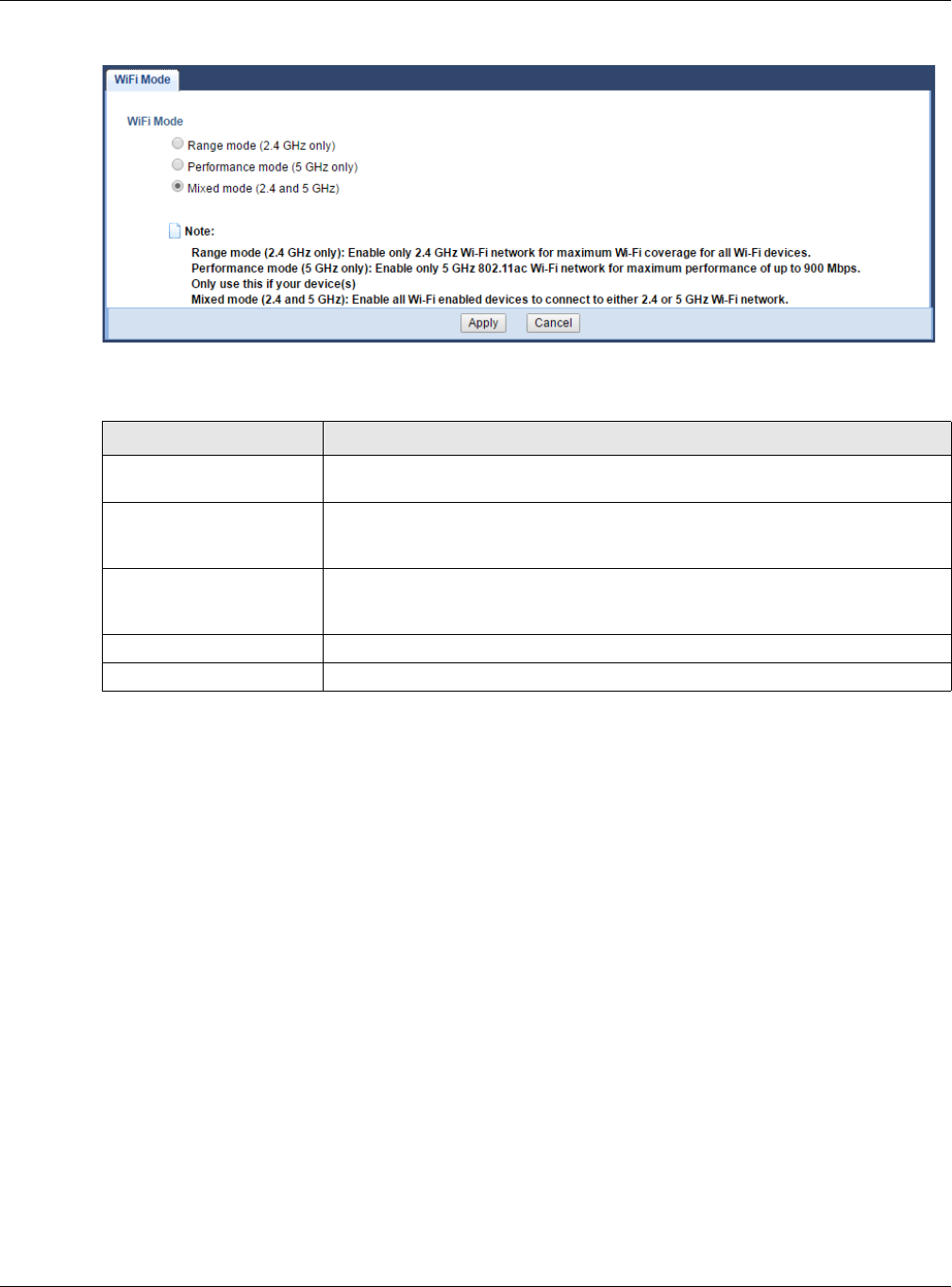
Chapter 11 Maintenance
PLA5236 User’s Guide
63
Figure 43 Maintenance > WiFi Mode
The following table describes the labels in this screen.
Table 31 Maintenance > WiFi Mode
LABEL DESCRIPTION
Range Mode This mode enables a 2.4GHz Wi-Fi, with a wider range for your Wi-Fi devices. Choose
this mode if all your Wi-Fi devices are IEEE 802.11 b/g/n compatible.
Performance Mode This mode enables a 5Ghz Wi-Fi, with a better performance than 2.4Ghz, but a
shorter range for your Wi-Fi devices. Choose this mode if all your Wi-Fi devices are
IEEE 802.11 a/n/ac compatible.
Mixed Mode This mode enables both 2.5GHz and 5GHz Wi-Fi for all devices to connect. Choose
this mode if you have IEEE 802.11 a/n/ac and IEEE802.11 b/g/n Wi-Fi devices
connecting to your wireless network.
Apply Click Apply to save your settings to the PLA.
Cancel Click Cancel to reload the previous configuration for this screen.

PLA5236 User’s Guide
64
CHAPTER 12
Troubleshooting
This chapter offers some suggestions to solve problems you might encounter.
12.1 Power and Light Problems
The PLA does not turn on. None of the lights turn on.
1Disconnect and re-connect the PLA.
2Remove the powerline adapter from the outlet. Then connect an electrical device that you know works
into the same power outlet. This checks the status of the power outlet.
3If the problem continues, contact the vendor.
The ETHERNET light does not turn on.
1Check the hardware connections. See the Quick Start Guide.
2Inspect your cables for damage. Contact the vendor to replace any damaged cables.
3Check the Ethernet adapter on your computer and make sure it’s enabled and working properly.
4If the PLA is connected to an Ethernet switch or router, make sure the device is working correctly, and
that the LAN network is working and configured correctly as well.
The HomePlug light does not turn on.
1 Make sure that the network name (sometimes called the network password) is the same on all of your
powerline adapters.
2Make sure that all your powerline adapters are HomePlug AV compliant. Check the package it came in
or ask your vendor. This PLA can not detect earlier versions of HomePlug powerline adapters such as
HomePlug 1.0 or 1.0.1. (Although they can coexist on the same electrical wiring without interfering with
each other.)

Chapter 12 Troubleshooting
PLA5236 User’s Guide
65
3Make sure that the powerline adapters on your network are all on the same electrical wiring. Connect
another powerline adapter into an outlet close to your PLA’s power outlet. They are probably now on
the same electrical wiring. Check the HomePlug ( ) light. If it now lights up your powerline adapter
was probably previously on separate electrical wiring. Ask an electrician for more information on the
electrical wiring in your building.
4Make sure that you do not have a power meter between powerline adapters. Powerline signals cannot
pass this.
The POWER and HomePlug light blink at the same time.
•You have pressed the RESET/ENCRYPT button for more than three seconds. Try setting up a
connection again, this time pressing the RESET/ENCRYPT buttons on both devices for less than three
seconds.
12.2 Powerline Problems
The signal on my powerline network is weak.
1Your powerline adapters may be connected to electrical surge protectors. Connect them to standard
power outlets.
2Your powerline adapters may be located close to large appliances such as refrigerators or air-
conditioners that cause interference with the powerline signal. Move the adapters further away from
such appliances to reduce interference.
3Your powerline adapters may be placed close to electrical devices such as electrical insect-killers which
produce radio waves. These may interfere with the powerline signals. Move the adapters further away
from such electrical devices.
4Your wiring may be old and/or low quality or with a long wiring path.
12.3 RESET/ENCRYPT Button Problems
This section applies only to PLAs with the RESET/ENCRYPT button.
The HomePlug light is already on, but I haven’t pressed the RESET/ENCRYPT button yet.
Your device has already connected to another powerline device. Press the RESET/ENCRYPT button for 5
to 8 seconds to release the connection.

Chapter 12 Troubleshooting
PLA5236 User’s Guide
66
The POWER light does not blink when I press the RESET/ENCRYPT button.
• Check the device is on.
• Press the RESET/ENCRYPT button again, making certain you have pressed the button for 0.5 to 3
seconds.
• The POWER light on some powerline devices do not blink as part of the ENCRYPT process. Check your
powerline device is a PLA.
The POWER light blinks two times quickly then pauses, before repeating.
The ENCRYPT process has failed. Press the RESET/ENCRYPT button on both devices for 5 to 8 seconds,
then try to reconnect.
The POWER lights on both devices blink when I press the RESET/ENCRYPT buttons, but the
HomePlug light does not turn on.
• Ensure you have pressed the RESET/ENCRYPT button on both devices.
• Wait for about a minute while the devices set up a connection.
• If that does not work, try again with both devices connected to a power strip next to each other. If
they now connect, then the devices were not on the same electrical circuit before.
The POWER lights on both devices blink, then many lights blink and the HomePlug light blinks red.
Do not worry, the connection process is proceeding normally.
The POWER lights on both devices finished blinking, but only one device’s HomePlug light is on.
One device may have connected to a third powerline device. To check device A is connected to
device B and not another device, disconnect device B from its power source. Device A’s HomePlug
( ) light will turn off if the connection is with Device B. Press the RESET/ENCRYPT button on both devices
for 5 to 8 seconds, then try to reconnect, pressing the RESET/ENCRYPT button for 0.5 to 3 seconds on both
devices.
I pressed the RESET/ENCRYPT button for 5 to 8 seconds, but the HomePlug light is still on.

Chapter 12 Troubleshooting
PLA5236 User’s Guide
67
The HomePlug light is on, indicating it is still connected to another powerline device. Try again, pressing
the RESET/ENCRYPT button for 5 to 8 seconds.

PLA5236 User’s Guide
68
APPENDIX A
Customer Support
In the event of problems that cannot be solved by using this manual, you should contact your vendor. If
you cannot contact your vendor, then contact a Zyxel office for the region in which you bought the
device.
See http://www.zyxel.com/homepage.shtml and also
http://www.zyxel.com/about_zyxel/zyxel_worldwide.shtml for the latest information.
Please have the following information ready when you contact an office.
Required Information
• Product model and serial number.
• Warranty Information.
• Date that you received your device.
• Brief description of the problem and the steps you took to solve it.
Corporate Headquarters (Worldwide)
Taiwan
• Zyxel Communications Corporation
• http://www.zyxel.com
Asia
China
• Zyxel Communications (Shanghai) Corp.
Zyxel Communications (Beijing) Corp.
Zyxel Communications (Tianjin) Corp.
• http://www.zyxel.cn
India
•Zyxel Technology India Pvt Ltd
• http://www.zyxel.in
Kazakhstan
•Zyxel Kazakhstan
• http://www.zyxel.kz

Appendix A Customer Support
PLA5236 User’s Guide
69
Korea
• Zyxel Korea Corp.
• http://www.zyxel.kr
Malaysia
• Zyxel Malaysia Sdn Bhd.
• http://www.zyxel.com.my
Pakistan
• Zyxel Pakistan (Pvt.) Ltd.
• http://www.zyxel.com.pk
Philippines
• Zyxel Philippines
• http://www.zyxel.com.ph
Singapore
• Zyxel Singapore Pte Ltd.
• http://www.zyxel.com.sg
Taiwan
• Zyxel Communications Corporation
• http://www.zyxel.com/tw/zh/
Thailand
• Zyxel Thailand Co., Ltd
• http://www.zyxel.co.th
Vietnam
• Zyxel Communications Corporation-Vietnam Office
• http://www.zyxel.com/vn/vi
Europe
Austria
•Zyxel Deutschland GmbH
• http://www.zyxel.de
Belarus
•Zyxel BY
• http://www.zyxel.by

Appendix A Customer Support
PLA5236 User’s Guide
70
Belgium
• Zyxel Communications B.V.
• http://www.zyxel.com/be/nl/
• http://www.zyxel.com/be/fr/
Bulgaria
•Zyxel България
• http://www.zyxel.com/bg/bg/
Czech Republic
• Zyxel Communications Czech s.r.o
• http://www.zyxel.cz
Denmark
• Zyxel Communications A/S
• http://www.zyxel.dk
Estonia
• Zyxel Estonia
• http://www.zyxel.com/ee/et/
Finland
• Zyxel Communications
• http://www.zyxel.fi
France
•Zyxel France
• http://www.zyxel.fr
Germany
•Zyxel Deutschland GmbH
• http://www.zyxel.de
Hungary
• Zyxel Hungary & SEE
• http://www.zyxel.hu
Italy
• Zyxel Communications Italy
• http://www.zyxel.it/

Appendix A Customer Support
PLA5236 User’s Guide
71
Latvia
•Zyxel Latvia
• http://www.zyxel.com/lv/lv/homepage.shtml
Lithuania
•Zyxel Lithuania
• http://www.zyxel.com/lt/lt/homepage.shtml
Netherlands
• Zyxel Benelux
• http://www.zyxel.nl
Norway
• Zyxel Communications
• http://www.zyxel.no
Poland
• Zyxel Communications Poland
• http://www.zyxel.pl
Romania
• Zyxel Romania
• http://www.zyxel.com/ro/ro
Russia
• Zyxel Russia
• http://www.zyxel.ru
Slovakia
• Zyxel Communications Czech s.r.o. organizacna zlozka
• http://www.zyxel.sk
Spain
• Zyxel Communications ES Ltd
• http://www.zyxel.es
Sweden
• Zyxel Communications
• http://www.zyxel.se
Switzerland
•Studerus AG

Appendix A Customer Support
PLA5236 User’s Guide
72
• http://www.zyxel.ch/
Turkey
• Zyxel Turkey A.S.
• http://www.zyxel.com.tr
UK
• Zyxel Communications UK Ltd.
• http://www.zyxel.co.uk
Ukraine
•Zyxel Ukraine
• http://www.ua.zyxel.com
Latin America
Argentina
• Zyxel Communication Corporation
• http://www.zyxel.com/ec/es/
Brazil
• Zyxel Communications Brasil Ltda.
• https://www.zyxel.com/br/pt/
Ecuador
• Zyxel Communication Corporation
• http://www.zyxel.com/ec/es/
Middle East
Israel
• Zyxel Communication Corporation
• http://il.zyxel.com/homepage.shtml
Middle East
• Zyxel Communication Corporation
• http://www.zyxel.com/me/en/

Appendix A Customer Support
PLA5236 User’s Guide
73
North America
USA
• Zyxel Communications, Inc. - North America Headquarters
• http://www.zyxel.com/us/en/
Oceania
Australia
• Zyxel Communications Corporation
• http://www.zyxel.com/au/en/
Africa
South Africa
• Nology (Pty) Ltd.
• http://www.zyxel.co.za

PLA5236 User’s Guide
74
APPENDIX B
Legal Information
Copyright
Copyright © 2017 by Zyxel Communications Corporation.
The contents of this publication may not be reproduced in any part or as a whole, transcribed, stored in a retrieval system, translated into any
language, or transmitted in any form or by any means, electronic, mechanical, magnetic, optical, chemical, photocopying, manual, or
otherwise, without the prior written permission of Zyxel Communications Corporation.
Published by Zyxel Communications Corporation. All rights reserved.
Disclaimer
Zyxel does not assume any liability arising out of the application or use of any products, or software described herein. Neither does it convey any
license under its patent rights nor the patent rights of others. Zyxel further reserves the right to make changes in any products described herein
without notice. This publication is subject to change without notice.
Regulatory Notice and Statement
United States of America
The following information applies if you use the product within USA area.
FCC EMC Statement
• The device complies with Part 15 of FCC rules. Operation is subject to the following two conditions:
(1) This device may not cause harmful interference, and
(2) This device must accept any interference received, including interference that may cause undesired operation.
• Changes or modifications not expressly approved by the party responsible for compliance could void the user’s authority to operate the
device.
• This product has been tested and complies with the specifications for a Class B digital device, pursuant to Part 15 of the FCC Rules. These
limits are designed to provide reasonable protection against harmful interference in a residential installation. This device generates, uses, and
can radiate radio frequency energy and, if not installed and used according to the instructions, may cause harmful interference to radio
communications. However, there is no guarantee that interference will not occur in a particular installation.
• If this device does cause harmful interference to radio or television reception, which is found by turning the device off and on, the user is
encouraged to try to correct the interference by one or more of the following measures:
• Reorient or relocate the receiving antenna
• Increase the separation between the devices
• Connect the equipment to an outlet other than the receiver’s
• Consult a dealer or an experienced radio/TV technician for assistance
The following information applies if you use the product with RF function within USA area.
FCC Radiation Exposure Statement
•This equipment complies with FCC RF radiation exposure limits set forth for an uncontrolled environment.
• This transmitter must be at least 20 cm from the user and must not be co-located or operating in conjunction with any other antenna or
transmitter.
Canada
The following information applies if you use the product within Canada area
Industry Canada ICES statement
CAN ICES-3 (B)/NMB-3(B)
CAN ICES-6/NMB-6

Appendix B Legal Information
PLA5236 User’s Guide
75
Industry Canada RSS-GEN & RSS-247 statement
• This device complies with Industry Canada license-exempt RSS standard(s). Operation is subject to the following two conditions: (1) this
device may not cause interference, and (2) this device must accept any interference, including interference that may cause undesired
operation of the device.
• This radio transmitter (2468C-PLA5236) has been approved by Industry Canada to operate with the antenna types listed below with the
maximum permissible gain and required antenna impedance for each antenna type indicated. Antenna types not included in this list,
having a gain greater than the maximum gain indicated for that type, are strictly prohibited for use with this device.
Antenna Information
If the product with 5G wireless function operating in 5150-5250 MHz and 5725-5850 MHz, the following attention must be paid,
• The device for operation in the band 5150-5250 MHz is only for indoor use to reduce the potential for harmful interference to co-channel
mobile satellite systems.
• For devices with detachable antenna(s), the maximum antenna gain permitted for devices in the band 5725-5850 MHz shall be such that the
equipment still complies with the e.i.r.p. limits specified for point-to-point and non-point-to-point operation as appropriate; and
• The worst-case tilt angle(s) necessary to remain compliant with the e.i.r.p. elevation mask requirement set forth in Section 6.2.2(3) of RSS 247
shall be clearly indicated.
If the product with 5G wireless function operating in 5250-5350 MHz and 5470-5725 MHz, the following attention must be paid.
• For devices with detachable antenna(s), the maximum antenna gain permitted for devices in the bands 5250-5350 MHz and 5470-5725 MHz
shall be such that the equipment still complies with the e.i.r.p. limit
• Le présent appareil est conforme aux CNR d’Industrie Canada applicables aux appareils radio exempts de licence. L’exploitation est
autorisée aux deux conditions suivantes: (1) l’appareil ne doit pas produire de brouillage, et (2) l’utilisateur de l’appareil doit accepter tout
brouillage radioélectrique subi, même si le brouillage est susceptible d’en compromettre le fonctionnement.
• Le présent émetteur radio (2468C-PLA5236) de modèle s'il fait partie du matériel de catégorieI) a été approuvé par Industrie Canada pour
fonctionner avec les types d'antenne énumérés ci-dessous et ayant un gain admissible maximal et l'impédance requise pour chaque type
d'antenne. Les types d'antenne non inclus dans cette liste, ou dont le gain est supérieur au gain maximal indiqué, sont strictement interdits
pour l'exploitation de l'émetteur.
Informations Antenne
Lorsque la fonction sans fil 5G fonctionnant en5150-5250 MHz and 5725-5850 MHz est activée pour ce produit , il est nécessaire de porter une
attention particulière aux choses suivantes
• Les dispositifs fonctionnant dans la bande 5150-5250 MHz sont réservés uniquement pour une utilisation à l’intérieur afin de réduire les risques
de brouillage préjudiciable aux systèmes de satellites mobiles utilisant les mêmes canaux;
• Pour les dispositifs munis d’antennes amovibles, le gain maximal d'antenne permis (pour les dispositifs utilisant la bande de 5 725 à 5 850 MHz)
doit être conforme à la limite de la p.i.r.e. spécifiée pour l'exploitation point à point et l’exploitation non point à point, selon le cas;
• Les pires angles d’inclinaison nécessaires pour rester conforme à l’exigence de la p.i.r.e. applicable au masque d’élévation, et énoncée à la
section 6.2.2 3) du CNR-247, doivent être clairement indiqués.
Lorsque la fonction sans fil 5G fonctionnant en 5250-5350 MHz et 5470-5725 MHz est activée pour ce produit, il est nécessaire de porter une
attention particulière aux choses suivantes
• Pour les dispositifs munis d’antennes amovibles, le gain maximal d'antenne permis pour les dispositifs utilisant les bandes de 5 250 à 5 350 MHz
et de 5 470 à 5 725 MHz doit être conforme à la limite de la p.i.r.e.
Industry Canada radiation exposure statement
The equipment complies with IC radiation exposure limits set forth for an uncontrolled environment. This device should be installed and operated
with a minimum distance of 20 cm between the radiator and your body.
Déclaration d’exposition aux radiations:
Cet équipement est conforme aux limites d’exposition aux rayonnements IC établies pour un environnement non contrôlé. Cet équipement doit
être installé et utilisé avec un minimum de 20 cm de distance entre la source de rayonnement et votre corps.
EUROPEAN UNION
The following information applies if you use the product within the European Union.
TYPE MANUFACTURER GAIN CONNECTOR
Dipole ARISTOTLE 1.61 dBi (2.4G)
2.78 dBi (5G)
IPEX
TYPE FABRICANT GAIN CONNECTEUR
Dipole ARISTOTLE 1.61 dBi (2.4G)
2.78 dBi (5G)
IPEX

Appendix B Legal Information
PLA5236 User’s Guide
76
Declaration of Conformity with Regard to EU Directive 1999/5/EC (R&TTE Directive)
• Compliance information for 2.4GHz and/or 5GHz wireless products relevant to the EU and other Countries following the EU Directive 1999/5/
EC (R&TTE)
• This device is restricted to indoor use only when operating in the 5150 to 5350 MHz frequency range.
National Restrictions
• This product may be used in all EU countries (and other countries following the EU Directive 1999/5/EC) without any limitation except for the
countries mentioned below:
• Ce produit peut être utilisé dans tous les pays de l’UE (et dans tous les pays ayant transposés la directive 1999/5/CE) sans aucune limitation,
excepté pour les pays mentionnés ci-dessous:
• Questo prodotto è utilizzabile in tutte i paesi EU (ed in tutti gli altri paesi che seguono le direttiva 1999/5/EC) senza nessuna limitazione,
eccetto per i paesii menzionati di seguito:
Български
(Bulgarian)
С настоящото Zyxel декларира, че това оборудване е в съответствие със съществените изисквания и другите
приложими разпоредбите на Директива 1999/5/ЕC.
Español
(Spanish)
Por medio de la presente Zyxel declara que el equipo cumple con los requisitos esenciales y cualesquiera otras
disposiciones aplicables o exigibles de la Directiva 1999/5/CE.
Čeština
(Czech)
Zyxel tímto prohlašuje, že tento zařízení je ve shodě se základními požadavky a dalšími příslušnými ustanoveními směrnice
1999/5/EC.
Dansk (Danish) Undertegnede Zyxel erklærer herved, at følgende udstyr udstyr overholder de væsentlige krav og øvrige relevante krav i
direktiv 1999/5/EF.
Deutsch
(German)
Hiermit erklärt Zyxel, dass sich das Gerät Ausstattung in Übereinstimmung mit den grundlegenden Anforderungen und den
übrigen einschlägigen Bestimmungen der Richtlinie 1999/5/EU befindet.
Eesti keel
(Estonian)
Käesolevaga kinnitab Zyxel seadme seadmed vastavust direktiivi 1999/5/EÜ põhinõuetele ja nimetatud direktiivist
tulenevatele teistele asjakohastele sätetele.
Ελληνικά
(Greek)
ΜΕ ΤΗΝ ΠΑΡΟΥΣΑ Zyxel ∆ΗΛΩΝΕΙ ΟΤΙ εξοπλισμός ΣΥΜΜΟΡΦΩΝΕΤΑΙ ΠΡΟΣ ΤΙΣ ΟΥΣΙΩ∆ΕΙΣ ΑΠΑΙΤΗΣΕΙΣ ΚΑΙ ΤΙΣ ΛΟΙΠΕΣ ΣΧΕΤΙΚΕΣ
∆ΙΑΤΑΞΕΙΣ ΤΗΣ Ο∆ΗΓΙΑΣ 1999/5/ΕC.
English Hereby, Zyxel declares that this device is in compliance with the essential requirements and other relevant provisions of
Directive 1999/5/EC.
Français
(French)
Par la présente Zyxel déclare que l'appareil équipements est conforme aux exigences essentielles et aux autres dispositions
pertinentes de la directive 1999/5/EC.
Hrvatski
(Croatian)
Zyxel ovime izjavljuje da je radijska oprema tipa u skladu s Direktivom 1999/5/EC.
Íslenska
(Icelandic)
Hér með lýsir, Zyxel því yfir að þessi búnaður er í samræmi við grunnkröfur og önnur viðeigandi ákvæði tilskipunar 1999/5/EC.
Italiano (Italian) Con la presente Zyxel dichiara che questo attrezzatura è conforme ai requisiti essenziali ed alle altre disposizioni pertinenti
stabilite dalla direttiva 1999/5/CE.
Latviešu valoda
(Latvian)
Ar šo Zyxel deklarē, ka iekārtas atbilst Direktīvas 1999/5/EK būtiskajām prasībām un citiem ar to saistītajiem noteikumiem.
Lietuvių kalba
(Lithuanian)
Šiuo Zyxel deklaruoja, kad šis įranga atitinka esminius reikalavimus ir kitas 1999/5/EB Direktyvos nuostatas.
Magyar
(Hungarian)
Alulírott, Zyxel nyilatkozom, hogy a berendezés megfelel a vonatkozó alapvetõ követelményeknek és az 1999/5/EK irányelv
egyéb elõírásainak.
Malti (Maltese) Hawnhekk, Zyxel, jiddikjara li dan tagħmir jikkonforma mal-ħtiġijiet essenzjali u ma provvedimenti oħrajn relevanti li hemm
fid-Dirrettiva 1999/5/EC.
Nederlands
(Dutch)
Hierbij verklaart Zyxel dat het toestel uitrusting in overeenstemming is met de essentiële eisen en de andere relevante
bepalingen van richtlijn 1999/5/EC.
Polski (Polish) Niniejszym Zyxel oświadcza, że sprzęt jest zgodny z zasadniczymi wymogami oraz pozostałymi stosownymi postanowieniami
Dyrektywy 1999/5/EC.
Português
(Portuguese)
Zyxel declara que este equipamento está conforme com os requisitos essenciais e outras disposições da Directiva 1999/5/
EC.
Română
(Romanian)
Prin prezenta, Zyxel declară că acest echipament este în conformitate cu cerinţele esenţiale şi alte prevederi relevante ale
Directivei 1999/5/EC.
Slovenčina
(Slovak)
Zyxel týmto vyhlasuje, že zariadenia spĺňa základné požiadavky a všetky príslušné ustanovenia Smernice 1999/5/EC.
Slovenščina
(Slovene)
Zyxel izjavlja, da je ta oprema v skladu z bistvenimi zahtevami in ostalimi relevantnimi določili direktive 1999/5/EC.
Suomi (Finnish) Zyxel vakuuttaa täten että laitteet tyyppinen laite on direktiivin 1999/5/EY oleellisten vaatimusten ja sitä koskevien direktiivin
muiden ehtojen mukainen.
Svenska
(Swedish)
Härmed intygar Zyxel att denna utrustning står I överensstämmelse med de väsentliga egenskapskrav och övriga relevanta
bestämmelser som framgår av direktiv 1999/5/EC.
Norsk
(Norwegian)
Erklærer herved Zyxel at dette utstyret er I samsvar med de grunnleggende kravene og andre relevante bestemmelser I
direktiv 1999/5/EF.

Appendix B Legal Information
PLA5236 User’s Guide
77
• Das Produkt kann in allen EU Staaten ohne Einschränkungen eingesetzt werden (sowie in anderen Staaten die der Richtlinie 1999/5/CE
folgen) mit Außnahme der folgenden aufgeführten Staaten:
In the majority of the EU and other European countries, the 2.4GHz and 5GHz bands have been made available for the use of wireless local
area networks (LANs). Later in this document you will find an overview of countries in which additional restrictions or requirements or both are
applicable. The requirements for any country may evolve. Zyxel recommends that you check with the local authorities for the latest status of
their national regulations for both the 2.4GHz and 5GHz wireless LANs. The following countries have restrictions and/or requirements in
addition to those given in the table labeled “Overview of Regulatory Requirements for Wireless LANs”:.
Belgium
• The Belgian Institute for Postal Services and Telecommunications (BIPT) must be notified of any outdoor wireless link having a range
exceeding 300 meters. Please check http://www.bipt.be for more details.
• Draadloze verbindingen voor buitengebruik en met een reikwijdte van meer dan 300 meter dienen aangemeld te worden bij het Belgisch
Instituut voor postdiensten en telecommunicatie (BIPT). Zie http://www.bipt.be voor meer gegevens.
• Les liaisons sans fil pour une utilisation en extérieur d’une distance supérieure à 300 mètres doivent être notifiées à l’Institut Belge des
services Postaux et des Télécommunications (IBPT). Visitez http://www.ibpt.be pour de plus amples détails.
Denmark
• In Denmark, the band 5150 - 5350 MHz is also allowed for outdoor usage.
• I Danmark må frekvensbåndet 5150 - 5350 også anvendes udendørs.
Italy
• This product meets the National Radio Interface and the requirements specified in the National Frequency Allocation Table for Italy. Unless
this wireless LAN product is operating within the boundaries of the owner's property, its use requires a “general authorization.” Please check
http://www.sviluppoeconomico.gov.it/ for more details.
• Questo prodotto è conforme alla specifiche di Interfaccia Radio Nazionali e rispetta il Piano Nazionale di ripartizione delle frequenze in
Italia. Se non viene installato all 'interno del proprio fondo, l'utilizzo di prodotti Wireless LAN richiede una “Autorizzazione Generale”.
Consultare http://www.sviluppoeconomico.gov.it/ per maggiori dettagli.
Latvia
• The outdoor usage of the 2.4 GHz band requires an authorization from the Electronic Communications Office. Please check http://
www.esd.lv for more details.
• 2.4 GHz frekvenèu joslas izmantoðanai ârpus telpâm nepiecieðama atïauja no Elektronisko sakaru direkcijas. Vairâk informâcijas: http://
www.esd.lv.
Notes:
1. Although Norway, Switzerland and Liechtenstein are not EU member states, the EU Directive 1999/5/EC has also been implemented in those
countries.
2. The regulatory limits for maximum output power are specified in EIRP. The EIRP level (in dBm) of a device can be calculated by adding the
gain of the antenna used (specified in dBi) to the output power available at the connector (specified in dBm).
List of national codes
Safety Warnings
• Do not use this product near water, for example, in a wet basement or near a swimming pool.
• Do not expose your device to dampness, dust or corrosive liquids.
• Do not store things on the device.
• Do not install, use, or service this device during a thunderstorm. There is a remote risk of electric shock from lightning.
• Connect ONLY suitable accessories to the device.
COUNTRY ISO 3166 2 LETTER CODE COUNTRY ISO 3166 2 LETTER CODE
Austria AT Liechtenstein LI
Belgium BE Lithuania LT
Bulgaria BG Luxembourg LU
Croatia HR Malta MT
Cyprus CY Netherlands NL
Czech Republic CZ Norway NO
Denmark DK Poland PL
Estonia EE Portugal PT
Finland FI Romania RO
France FR Serbia RS
Germany DE Slovakia SK
Greece GR Slovenia SI
Hungary HU Spain ES
Iceland IS Switzerland CH
Ireland IE Sweden SE
Italy IT Turkey TR
Latvia LV United Kingdom GB

Appendix B Legal Information
PLA5236 User’s Guide
78
• Do not open the device or unit. Opening or removing covers can expose you to dangerous high voltage points or other risks. ONLY qualified
service personnel should service or disassemble this device. Please contact your vendor for further information.
• Make sure to connect the cables to the correct ports.
• Place connecting cables carefully so that no one will step on them or stumble over them.
• Always disconnect all cables from this device before servicing or disassembling.
• Do not remove the plug and connect it to a power outlet by itself; always attach the plug to the power adaptor first before connecting it to
a power outlet.
• Do not allow anything to rest on the power adaptor or cord and do NOT place the product where anyone can walk on the power adaptor
or cord.
• Please use the provided or designated connection cables/power cables/ adaptors. Connect it to the right supply voltage (for example,
110V AC in North America or 230V AC in Europe). If the power adaptor or cord is damaged, it might cause electrocution. Remove it from the
device and the power source, repairing the power adapter or cord is prohibited. Contact your local vendor to order a new one.
• Do not use the device outside, and make sure all the connections are indoors. There is a remote risk of electric shock from lightning.
• CAUTION: Risk of explosion if battery is replaced by an incorrect type, dispose of used batteries according to the instruction. Dispose them at
the applicable collection point for the recycling of electrical and electronic devices. For detailed information about recycling of this
product, please contact your local city office, your household waste disposal service or the store where you purchased the product.
• Do not obstruct the device ventilation slots, as insufficient airflow may harm your device. For example, do not place the device in an
enclosed space such as a box or on a very soft surface such as a bed or sofa.
• The following warning statements apply, where the disconnect device is not incorporated in the device or where the plug on the power
supply cord is intended to serve as the disconnect device,
- For permanently connected devices, a readily accessible disconnect device shall be incorporated external to the device;
- For pluggable devices, the socket-outlet shall be installed near the device and shall be easily accessible.
Environment Statement
ErP (Energy-related Products)
Zyxel products put on the EU market in compliance with the requirement of the European Parliament and the Council published Directive
2009/125/EC establishing a framework for the setting of ecodesign requirements for energy-related products (recast), so called as "ErP
Directive (Energy-related Products directive) as well as ecodesign requirement laid down in applicable implementing measures, power
consumption has satisfied regulation requirements which are:
• Network standby power consumption < 8W, and/or
• Off mode power consumption < 0.5W, and/or
• Standby mode power consumption < 0.5W.
(Wireless setting, please refer to "Wireless" chapter for more detail.)
European Union - Disposal and Recycling Information
The symbol below means that according to local regulations your product and/or its battery shall be disposed of separately from domestic
waste. If this product is end of life, take it to a recycling station designated by local authorities. At the time of disposal, the separate
collection of your product and/or its battery will help save natural resources and ensure that the environment is sustainable development.
Die folgende Symbol bedeutet, dass Ihr Produkt und/oder seine Batterie gemäß den örtlichen Bestimmungen getrennt vom Hausmüll
entsorgt werden muss. Wenden Sie sich an eine Recyclingstation, wenn dieses Produkt das Ende seiner Lebensdauer erreicht hat. Zum
Zeitpunkt der Entsorgung wird die getrennte Sammlung von Produkt und/oder seiner Batterie dazu beitragen, natürliche Ressourcen zu
sparen und die Umwelt und die menschliche Gesundheit zu schützen.
El símbolo de abajo indica que según las regulaciones locales, su producto y/o su batería deberán depositarse como basura separada de
la doméstica. Cuando este producto alcance el final de su vida útil, llévelo a un punto limpio. Cuando llegue el momento de desechar el
producto, la recogida por separado éste y/o su batería ayudará a salvar los recursos naturales y a proteger la salud humana y
medioambiental.
Le symbole ci-dessous signifie que selon les réglementations locales votre produit et/ou sa batterie doivent être éliminés séparément des
ordures ménagères. Lorsque ce produit atteint sa fin de vie, amenez-le à un centre de recyclage. Au moment de la mise au rebut, la
collecte séparée de votre produit et/ou de sa batterie aidera à économiser les ressources naturelles et protéger l'environnement et la santé
humaine.
Il simbolo sotto significa che secondo i regolamenti locali il vostro prodotto e/o batteria deve essere smaltito separatamente dai rifiuti
domestici. Quando questo prodotto raggiunge la fine della vita di servizio portarlo a una stazione di riciclaggio. Al momento dello
smaltimento, la raccolta separata del vostro prodotto e/o della sua batteria aiuta a risparmiare risorse naturali e a proteggere l'ambiente e
la salute umana.
Symbolen innebär att enligt lokal lagstiftning ska produkten och/eller dess batteri kastas separat från hushållsavfallet. När den här produkten
når slutet av sin livslängd ska du ta den till en återvinningsstation. Vid tiden för kasseringen bidrar du till en bättre miljö och mänsklig hälsa
genom att göra dig av med den på ett återvinningsställe.
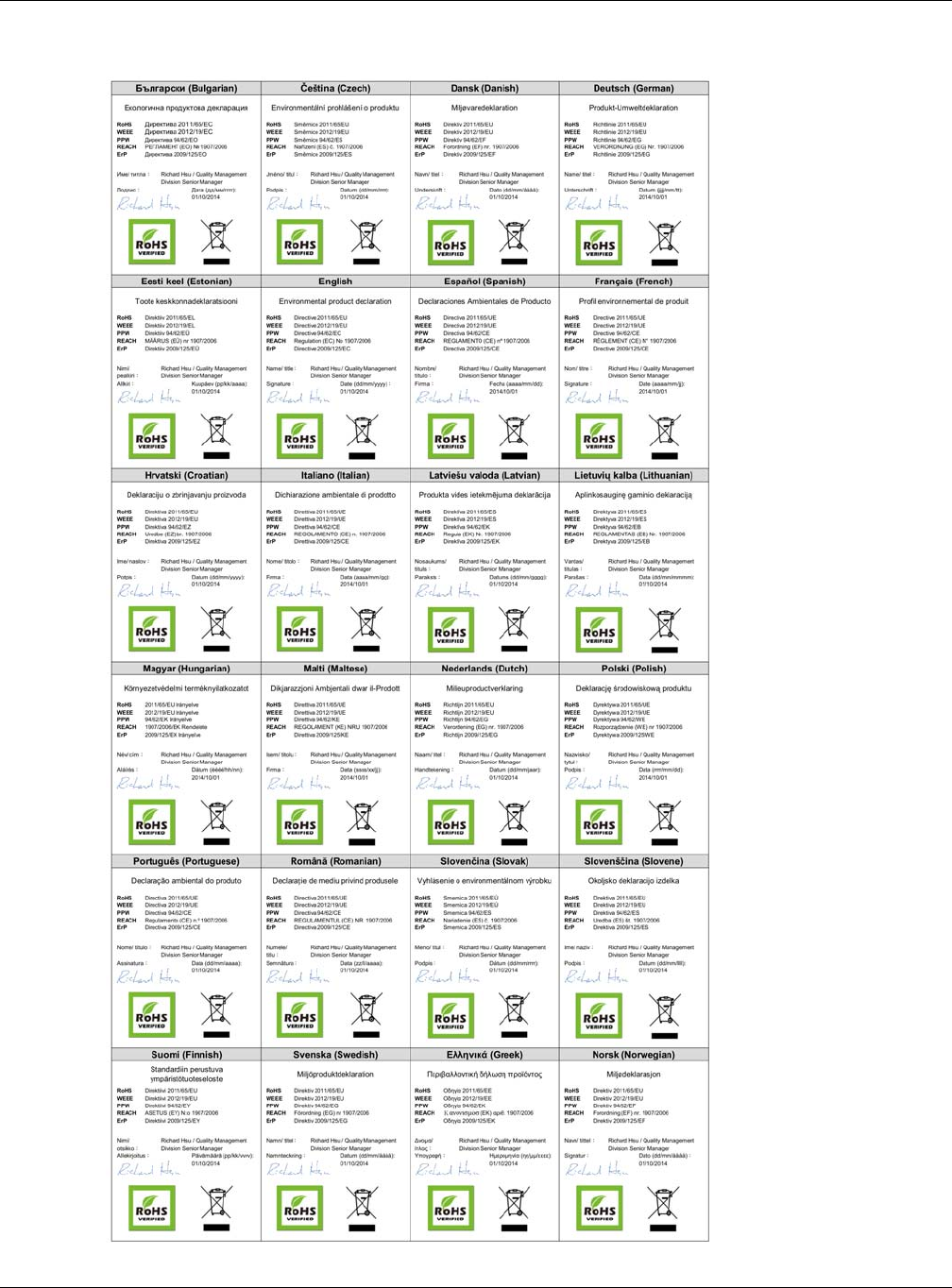
Appendix B Legal Information
PLA5236 User’s Guide
79
Environmental Product Declaration

Appendix B Legal Information
PLA5236 User’s Guide
80
台灣
以下訊息僅適用於產品具有無線功能且銷售至台灣地區
• 第十二條 經型式認證合格之低功率射頻電機,非經許可,公司,商號或使用者均不得擅自變更頻率、加大功率或變更原設計之特性及功能。
• 第十四條 低功率射頻電機之使用不得影響飛航安全及干擾合法通信;經發現有干擾現象時,應立即停用,並改善至無干擾時方得繼續使用。
前項合法通信,指依電信法規定作業之無線電通信。 低功率射頻電機須忍受合法通信或工業、科學及醫療用電波輻射性電機設備之干擾。
• 電磁波曝露量 MPE 標準值 1mW/cm2,送測產品實測值為: 0.282 mW/cm2。本產品使用時建議應距離人體 20 cm。
• 無線資訊傳輸設備忍受合法通信之干擾且不得干擾合法通信;如造成干擾,應立即停用, 俟無干擾之虞,始得繼續使用。
• 無線資訊傳設備的製造廠商應確保頻率穩定性,如依製造廠商使用手冊上所述正常操作, 發射的信號應維持於操作頻帶中
以下訊息僅適用於產品操作於 5.25-5.35 秭赫頻帶內並銷售至台灣地區
• 在 5.25-5.35 秭赫頻帶內操作之無線資訊傳輸設備,限於室內使用。
以下訊息僅適用於產品屬於專業安裝並銷售至台灣地區
• 本器材須經專業工程人員安裝及設定,始得 設置使用,且不得直接販售給一般消費者
安全警告 -為了您的安全,請先閱讀以下警告及指示 :
• 請勿將此產品接近水、火焰或放置在高溫的環境。
• 避免設備接觸
- 任何液體 - 切勿讓設備接觸水、雨水、高濕度、污水腐蝕性的液體或其他水份。
- 灰塵及污物 - 切勿接觸灰塵、污物、沙土、食物或其他不合適的材料。
• 雷雨天氣時,不要安裝,使用或維修此設備。有遭受電擊的風險。
• 切勿重摔或撞擊設備,並勿使用不正確的電源變壓器。
• 若接上不正確的電源變壓器會有爆炸的風險。
• 請勿隨意更換產品內的電池。
• 如果更換不正確之電池型式,會有爆炸的風險,請依製造商說明書處理使用過之電池。
• 請將廢電池丟棄在適當的電器或電子設備回收處。
• 請勿將設備解體。
• 請勿阻礙設備的散熱孔,空氣對流不足將會造成設備損害。
• 請插在正確的電壓供給插座 ( 如 : 北美 / 台灣電壓 110V AC,歐洲是 230V AC)。
• 假若電源變壓器或電源變壓器的纜線損壞,請從插座拔除,若您還繼續插電使用,會有觸電死亡的風險。
• 請勿試圖修理電源變壓器或電源變壓器的纜線,若有毀損,請直接聯絡您購買的店家,購買一個新的電源變壓器。
• 請勿將此設備安裝於室外,此設備僅適合放置於室內。
• 請勿隨一般垃圾丟棄。
• 請參閱產品背貼上的設備額定功率。
• 請參考產品型錄或是彩盒上的作業溫度。
• 產品沒有斷電裝置或者採用電源線的插頭視為斷電裝置的一部分,以下警語將適用 :
- 對永久連接之設備, 在設備外部須安裝可觸及之斷電裝置;
- 對插接式之設備, 插座必須接近安裝之地點而且是易於觸及的。
About the Symbols
Various symbols are used in this product to ensure correct usage, to prevent danger to the user and others, and to prevent property damage.
The meaning of these symbols are described below. It is important that you read these descriptions thoroughly and fully understand the
contents.

Appendix B Legal Information
PLA5236 User’s Guide
81
Explanation of the Symbols
Viewing Certifications
Go to http://www.zyxel.com to view this product’s documentation and certifications.
Zyxel Limited Warranty
Zyxel warrants to the original end user (purchaser) that this product is free from any defects in material or workmanship for a specific period (the
Warranty Period) from the date of purchase. The Warranty Period varies by region. Check with your vendor and/or the authorized Zyxel local
distributor for details about the Warranty Period of this product. During the warranty period, and upon proof of purchase, should the product
have indications of failure due to faulty workmanship and/or materials, Zyxel will, at its discretion, repair or replace the defective products or
components without charge for either parts or labor, and to whatever extent it shall deem necessary to restore the product or components to
proper operating condition. Any replacement will consist of a new or re-manufactured functionally equivalent product of equal or higher value,
and will be solely at the discretion of Zyxel. This warranty shall not apply if the product has been modified, misused, tampered with, damaged by
an act of God, or subjected to abnormal working conditions.
Note
Repair or replacement, as provided under this warranty, is the exclusive remedy of the purchaser. This warranty is in lieu of all other warranties,
express or implied, including any implied warranty of merchantability or fitness for a particular use or purpose. Zyxel shall in no event be held
liable for indirect or consequential damages of any kind to the purchaser.
To obtain the services of this warranty, contact your vendor. You may also refer to the warranty policy for the region in which you bought the
device at http://www.zyxel.com/web/support_warranty_info.php.
Registration
Register your product online to receive e-mail notices of firmware upgrades and information at www.zyxel.com for global products, or at
www.us.zyxel.com for North American products.
Open Source Licenses
This product contains in part some free software distributed under GPL license terms and/or GPL like licenses. Open source licenses are provided
with the firmware package. You can download the latest firmware at www.zyxel.com. To obtain the source code covered under those Licenses,
please contact support@zyxel.com.tw to get it.
SYMBOL EXPLANATION
Alternating current (AC):
AC is an electric current in which the flow of electric charge periodically reverses direction.
Direct current (DC):
DC if the unidirectional flow or movement of electric charge carriers.
Earth; ground:
A wiring terminal intended for connection of a Protective Earthing Conductor.
Class II equipment:
The method of protection against electric shock in the case of class II equipment is either double insulation
or reinforced insulation.

Index
PLA5236 User’s Guide
82
Index
A
Advanced Encryption Standard, see AES 9
AES (Advanced Encryption Standard) 9
applications 7
C
certifications 77
viewing 81
channel 34
Configuration
restore 61
connections overview 9
contact information 68
copyright 74
CPU usage 25
customer support 68
D
Daylight saving 59
disclaimer 74
E
encryption 9, 35
key 35
WPA compatible 35
F
Firmware upload 59
file extension
using HTTP
firmware version 24
G
General wireless LAN screen 35
H
HomePlug 52
HomePlug AV standard 7
I
introduction 7
IP Address 51
IP alias 49
L
LAN 48
LAN overview 48
LAN setup 48
LAN TCP/IP 49
Language 62
LED 64
ETHERNET 8
HomePlug 9
POWER 8
Link type 25
Local Area Network 48
Log 28

Index
PLA5236 User’s Guide
83
M
MAC 41
MAC address 34
MAC address filter 34
MAC address filtering 41
MAC filter 41
management
multiple networks 10
Media access control 41
Memory usage 25
multiple networks 11
N
network name 16
O
One Connect 55
Operating Channel 24
P
passwords 53
PLA Comparison 7
port speed 25
Powerline Network
Adding Devices 12
Creating multiple networks 15
Removing Devices 14
powerline setting 52
problems and solutions 64
Q
Quality of Service (QoS) 43
R
RESET/ENCRYPT Button
Manage 9
Restore configuration 61
Roaming 42
RTS/CTS Threshold 33, 42, 43
S
Scheduling 46
security 10
Service Set 36
Service Set IDentification 36
Service Set IDentity. See SSID.
SSID 24, 34, 36
Status Screens
Ethernet 23
system statistics 23
WLAN 23
Subnet Mask 51
Summary
Packet statistics 29
Wireless station status 30
System General Setup 56
System restart 62
T
Time setting 57
transfer rates 9
troubleshooting 64
W
warranty 81
note 81
Web Configurator
how to access 18
Overview 18
WEP Encryption 39, 41
